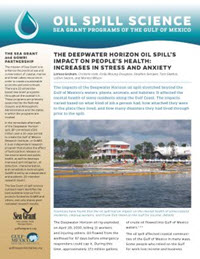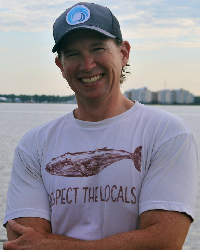 Balmer leads the Coastal Dolphin Health Assessment component of the Consortium for Advanced Research on Marine Mammal Health Assessment (CARMMHA). His group collects baseline health data on northern Gulf of Mexico dolphins, assesses potential Deepwater Horizon oil impacts, and tracks dolphins’ movement patterns using satellite tagging. Learn more about Balmer and his research here.
Balmer leads the Coastal Dolphin Health Assessment component of the Consortium for Advanced Research on Marine Mammal Health Assessment (CARMMHA). His group collects baseline health data on northern Gulf of Mexico dolphins, assesses potential Deepwater Horizon oil impacts, and tracks dolphins’ movement patterns using satellite tagging. Learn more about Balmer and his research here.
Author Archives: Stephanie Ellis
Look for these Tools and Resources for Oil Spill Research in 2020
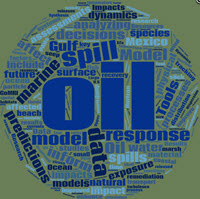
Eight years after Deepwater Horizon, we reflect on the sobering deaths of 11 people and the millions of barrels of oil released into the Gulf of Mexico. We also reflect on the extraordinary establishment of the largest coordinated scientific endeavor around an ocean event – the Gulf of Mexico Research Initiative (GoMRI) – to understand, respond to, and mitigate impacts from this and future oil spills.
The GoMRI program recently awarded their final two-year grants ($50 Million to 8 research consortia and 23 small research teams), which will wrap up its 10 year oil spill research program. Let’s take a look at some of the new and improved tools and resources that the 23 small team studies will produce that will improve our understanding of the 2010 oil spill and be better prepared for future spills.
Tools to Analyze Public Safety. Over 50,000 workers were involved in the Deepwater Horizon cleanup, and the oil spill affected more than 1,000 miles of beaches, some in prime tourist areas.
- Aerosol Model. Researchers are developing a numerical model for improved predictions of oil aerosolization. These predictions will be based on unprecedented simultaneous measurements of wind speed and aerosol concentrations performed with wind LiDARs detecting the dominating physical mechanisms that govern aerosol dynamics. The new model will help predict the environmental impact of an oil spill on air quality, from the sea to the coast. See study.
- Respiration Model. Researchers are analyzing how mice respond to aerosolized oil exposure, using a well-established method for studying in vivo effects of smoking and asbestos. The results will go into a model that simulates lung response of mice to hydrocarbon contamination, including molecular-level signatures of cancer-promoting genes, and will improve our understanding of possible impacts on workers’ respiratory systems. See study.
- Beach Exposure Model. Researchers are quantifying observational data on children’s play activities at four beach sites and combining it with chemical distribution data from prior oil spills. They will use this information to compute health risks from oil spill chemicals in air, water, and beach sands using quantified child beach play scenarios. Simulations can help promote safe beach use and inform closure decisions. See study.
Tools to Find Hidden Oil. Oil spill material that moves beneath the ocean’s surface or sinks to the seafloor adds to the complexity of tracking it for response decisions and impact assessments.
- Oil Detection Instrument. Response teams need to quickly know if actions such as dispersant application are effective in keeping oil from entering coastal and inland water systems. Researchers are designing a portable instrument that rapidly detects in-situ oil in real time. Compared to existing technologies, the device will have higher detection sensitivity, lower cost, smaller size, and will be easier to operate and maintain. See study.
- Seafloor Topography Model. Researchers are re-evaluating the seafloor area that marine oil snow affected beyond that of surface slick and oil plume areas. The team is collecting data from morphological and physical features based on a high-resolution spatial watershed model to demonstrate deposition pathways (erosion channels, lee depocenters, isolated valleys). Results will give a new perspective of the sinks, distribution, and transport of sedimented oil. See study.
- 3D Subsurface Dispersion Formula. Researchers are analyzing multiple data streams and circulation/oil tracking models to quantify the physical processes driving subsurface material dispersion. They will develop a dispersion formula for simulations that include how mesoscale eddies affect subsurface currents and vertical mixing. Results will help researchers infer locations of submerged oil from past and for future spills in the deep ocean or on the continental shelf. See study.
- Bayesian Subsurface Oil Forecasting Model. Researchers are developing the first model to integrate near-real time field data together with mathematical model output based on historical wind, current, and chemical processes information and bathymetry data. This new model will provide a means to locate and predict the future location of sunken and submerged oil, which can lead to improvements in response decisions and tactics and in environmental analyses. See study.
Tools to Track Oil. Improvements to predictions for where oil spill material is going needs data from interacting environmental factors, physical ocean processes, and spilled oil characteristics.
- Model with Wave Processes Data. Researchers are quantifying wave-related processes, especially important as a slick moves toward shore, that affect how surface oil moves. Data will include how tropical cyclones, winter fronts, temperature, surface roughness, and oil patchiness affect waves and oil transport. These environmental conditions data will enhance predictions from the Coupled Ocean-Atmosphere-Wave-Sediment Transport (COAWST) model. See study.
- Basin-Wide Modeling. Researchers are expanding circulation and transport models by accounting for northern and southeastern Gulf of Mexico physical processes and their role on oil drift, especially for spills near Cuba. Large eddies and upwelling near Cuba affect the Loop Current and create barriers that can accumulate and hinder oil movement, or direct it toward Florida. Simulated trajectories can inform U.S. Coast Guard exercises in the Straits of Florida. See study.
- Shelf to Shoreline Model. Researchers are adding an oil particle aggregate model to coastal circulation, wind, and sediment models to understand how oil moves in the “last stretch” from the inner shelf through the surf zone. Data will include Langmuir supercell turbulence, which lift sediments into the water column where they interact with entrained oil droplets. Results can estimate oil deposit locations in the surf zone, including its seaward side. See study.
- 3D Model of Upper Ocean Dynamics. Researchers are improving the predictive ability of how oil, marine snow, and other particulate matters evolve in fast-evolving small-scale upper-ocean turbulent currents. The team is using a modeling framework that includes a Large Eddy Simulation model (for boundary layer turbulence), a Lagrangian module (for particle tracking) and an Eulerian-based module (for oil particle coalescence and breakup). See study.
Tools for Oil Degradation and Dispersion Research. A better understanding of how oil degrades in the marine environment can inform spill technology development and remediation decisions.
- Oil Clock. Degrading oil releases geochemical tracers (radium isotopes), and researchers are using these tracers to “age date” or determine how long oil spill material stays in the marine environment after it is released. The team will create a geochronometer model for hydrocarbon dynamics and exposure time for microbial communities in deep and on surface waters, enhancing assessments of natural remediation rates for past and future spills. See study.
- Photo-Oxidation Database. Solar irradiation is a key natural weathering process for an oil slick, and it also appears to generate tens-of-thousands of oxygenated, surfactant-like molecules. Researchers are isolating these photo-generated surfactants, identifying their effect on stable oil emulsion formation, and creating a software platform to process mass spectral data from environmentally transformed crude oils. See study.
- Microbes for “Hidden” PAHs. Not much is known about the hard-to-find high molecular weight polycyclic aromatic hydrocarbons (PAHs) that are more toxic and mutagenic than other PAHs. Researchers are combining state-of-the art microbiological techniques and high-resolution vibrational spectroscopy to find and quantify these compounds and analyze the metabolic processes of bacterial species capable of degrading them. See study.
- Dispersant Design Matrix. Researchers are analyzing unimolecular micelles for long-term emulsification to enhance biodegradation and reduce the need for dispersant reapplication. They will create a matrix to identify optimal design factors for type (nanoparticle size, hydrophobic-hydrophilic ratio, solid vs hollow) and performance (oil uptake efficiency, stability, toxicity/biocompatibility). Comparisons with Corexit-oil mixtures will include cost-effectiveness and environments (salt and fresh water, temperature ranges). See study.
Resources on Marsh Impacts and Response. Understanding how the spill affected coastal marshes and how they responded can inform response and mitigation decisions and impact assessments.
- Synthesis of Marsh Impacts, Recovery. Researchers are conducting meta-analyses of marsh studies across geographies, response variables, and time periods that can reveal interpretations not evident from individual studies. Synthesis publications will include control factors for impacts, recovery, and resilience of plants and animals; soil-oil characteristics that influence sustainability; and recommendations for response, remediation, and restoration. See study.
- Catalog of Biomass and Microbial Impacts. Heavily oiled areas lost almost all of their vegetation, and that which returned was predominantly Spartina. This change affected marsh productivity, invertebrate and microbe recovery, and erosion. Researchers are compiling ten years of marsh monitoring data for a catalog library of above- and below-ground biomass, bacterial populations and community, and oil transformation products. See study.
Tools for Deep Ocean Analyzes. Deepwater Horizon happened in the least understood and incredibly productive area of the Gulf of Mexico. Deep Ocean dynamics affect food webs and global nutrient cycling.
- Pelagic Plankton and Upper Ocean Dynamics. Many deep-dwelling fishes and their larvae ascend the water column at night to feed and then return to depth. Researchers are analyzing the community structure and feeding ecology of these plankton and will combine their findings with other deep-ocean data, incorporate them into ecosystem and food web models, and estimate how disturbances affect deep-ocean ecosystem dynamics. See study.
- Natural Seep Data in Models. Understanding natural seep dynamics could improve predictions for subsea oil blowouts. Researchers are quantifying the differences and connections of small (seep) and large (blowout) release rates and their underlying physics. They will combine their results with data from previous natural seep studies and provide a key parameters guide to enhance predictions for natural and engineered releases. See study.
Tools to Assess Marine Animal Impacts. Understanding how marine animals respond to oil spill exposure can inform response decisions, impact assessments, and public safety actions.
- Adverse Outcome Pathway Model. Researchers are developing a mechanism-based model to assess impacts of the marine vertebrate stress response to oil exposure and estimate recovery. Using the Gulf toadfish, they will link initiating events (receptor activation, stress perception) to impacts on cell and organ systems (receptor sensitivity, pituitary fatigue, cortisol biosynthesis), and changes at the whole animal level (metabolism, immune capacity, behavior) to estimate population level effects (abundance, diversity). See study.
- Petrochemical Vulnerability Index. Researchers are synthesizing toxicological data, life history traits, spatial distribution, and extinction risk assessments for more than 2,000 Gulf of Mexico marine species. The resulting species-specific petrochemical vulnerability index can help resource managers and oil and gas industries make better-informed decisions for marine resource management, restoration, mitigation, and recovery in U.S., Mexican, and Cuban waters. See study.
- Meta-Analyses of Transcriptional Responses to Oil. There may be a similar genetic response to oil spill exposure across multiple fish species. Researchers are analyzing global RNA sequence libraries and microbiome samples from six oil-exposed fish species in four life stages from deep ocean and estuarine habitats. A database of impaired basic molecular functions of oil-exposed fish can inform fisheries management practices for future spills. See study.
- Toxicity Models for Corals. Researchers are analyzing individual- and cellular-level oil toxicity for Atlantic scleractinian and Gulf of Mexico shallow water coral species. The team will integrate their results into existing/emerging oil toxicity and 3D oil plume models, which will provide visualizations, predictions, and understanding of how oil affects key organisms and habitats and can inform response decisions related to impact thresholds, severity, and treatments. See study.
Resources: A detailed oil spill timeline and a video about the making of a 10 Year Gulf of Mexico Research Program.
************
The Gulf of Mexico Research Initiative (GoMRI) is a 10-year independent research program established to study the effect, and the potential associated impact, of hydrocarbon releases on the environment and public health, as well as to develop improved spill mitigation, oil detection, characterization and remediation technologies. An independent and academic 20-member Research Board makes the funding and research direction decisions to ensure the intellectual quality, effectiveness and academic independence of the GoMRI research. All research data, findings and publications will be made publicly available. The program was established through a $500 million financial commitment from BP. For more information, visit https://gulfresearchinitiative.org/.
© Copyright 2010-2018 Gulf of Mexico Research Initiative (GoMRI) – All Rights Reserved. Redistribution is encouraged with acknowledgement to the Gulf of Mexico Research Initiative (GoMRI). Please credit images and/or videos as done in each article. Questions? Contact web-content editor Nilde “Maggie” Dannreuther, Northern Gulf Institute, Mississippi State University (maggied@ngi.msstate.edu).
Dr. Rita Colwell Shares Her Journey to Inspire Women in Science
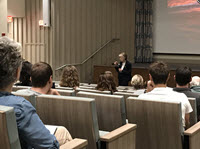
“I was not going to be stopped,” said Dr. Rita Colwell describing how she faced hurdles, many related to being a woman during her 60+ year science career, and blazed paths, including her being the first female director of the National Science Foundation. She spoke earnestly and enthusiastically to faculty, staff, and students gathered for the two-day Career and Leadership event at the University of Miami (UM) Rosenstiel School for Marine and Atmospheric Science (RSMAS).
“It is very important to fully engage women in science, energy, and technology because the country needs them, the world needs them,” said Colwell.
Professor Villy Kourafalou – Director of the UM “SEEDS (A Seed for Success)” program and Chair of the RSMAS “Diversity, Equity, and Inclusion Committee” – invited Dr. Colwell to be the Distinguished Lecturer at the 2018 lecture series that supports diversity and career development and success. Kourafalou knew that Colwell would inspire all scientists attending the event and leave a positive and lasting impression, but especially for the young women. And she did.

“It was incredibly inspiring to see a successful woman who has been in the field for so long speak about her research as well as the obstacles and successes she has experienced,” said UM graduate student Lela Schlenker. “I loved hearing her talk about meeting challenges and rising above sexist attitudes. She was such an inspiration.”
On day one, Colwell spoke about global infectious disease and its relationship with climate, oceans, and human health. She described her early work of computer coding with IBM punch cards and experiences in Bangladesh conducting cholera and genomics research, identifying specific bacterial strains in people’s gut. While Colwell spoke passionately about the science, she was equally as passionate about the people affected, evident when she described how the villagers learned to filter their drinking water that resulted in a 50% decrease in cholera cases.
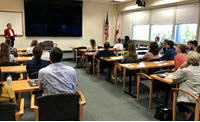
On day two, Colwell took the attendees on a historical journey as she described women in science from Galileo’s daughter to recent Nobel Prize winners. She discussed societal pressures that are not supportive of women entering science and engineering fields; however, she made a point to emphasize – particularly to the women in attendance – her persistence throughout her career, “If somebody tried to block my way, I went over, under, through the left or through the right.”
Afterwards, the audience asked questions about how male scientists can support female students and scientists (treat women equally, give women opportunities, students will be more productive and you will be rewarded), the role of good mentors (male or female), and work/life balance (go sailing to clear your mind, enlist the support of your partner/family). Other questions covered topics from ways to encourage more funding of interdisciplinary science programs to new skills students should acquire (genomics, IT, working with large data sets).
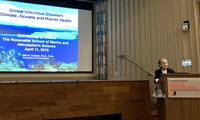
Colwell also encouraged attendees to participate in outreach and improve communicating their science effectively. She mentioned giving public presentations and participating in videos like the two Screenscope films Dispatches from the Gulf that documented the science and people involved with the Gulf of Mexico Research Initiative (GoMRI).
Professor Tamay Ozgokmen described the rapt attention displayed on everyone’s face as similar to watching a Hitchcock suspense movie and how Colwell captured their fascination with clarity and energy. “The way she expressed her memoirs revealed a lot of resilience, creativity, use of psychology, extraordinary intellect, combined with very hard, many decades of work. Nowadays, people like to do a little bit of everything, without going deep into any topic, but clearly, sustained focus and curiosity of science is at the core of Dr. Colwell’s enormous achievements.”
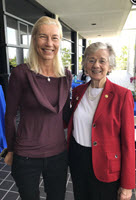
Professor Villy Kourafalou was thrilled with the audience’s overwhelming enthusiasm and the lively discussions at the networking events afterwards, but she was not surprised. “Bringing distinguished female scientists to RSMAS to talk about their amazing science achievements and their career pathways has been extremely rewarding. Rita Colwell, a larger-than-life scientist, graced us with her witty approach to life and science. It was a privilege to host her, and we are grateful for her generous time.”
- Rita Colwell is a Distinguished University Professor at the University of Maryland and Johns Hopkins University Bloomberg School of Public Health, Founder and Chair of CosmosID, Inc., and Chair of the GoMRI Research Board. She is the recipient of numerous national and international awards and honors, including 55 honorary degrees, and holds many leadership and advisory positions in U.S. Government and nonprofit science policy organizations, private foundations, and the international scientific research community.
- Villy Kourafalou leads a team of researchers, Ph.D. students, and postdocs at the UM RSMAS Department of Ocean Sciences. She is the co-Director of the Ocean Modeling and Observing System Simulation Experiments Center, lead for the Coastal and Shelf Modeling group; co-Chair of the international Coastal Ocean and Shelf Seas Task Team; and Principal or co-Principal Investigator of several GoMRI-funded projects.
- Tamay Ozgokmen teaches and advises Ph.D. students, post-docs, and researchers at the UM RSMAS Department of Ocean Sciences and is the Principal Investigator of the GoMRI-funded CARTHE consortium with over 44 co-Principal Investigators from 27 universities and research institutions.
- Learn more about the SEEDS program and the UM-based research consortia CARTHE and RECOVER.
************
The Gulf of Mexico Research Initiative (GoMRI) is a 10-year independent research program established to study the effect, and the potential associated impact, of hydrocarbon releases on the environment and public health, as well as to develop improved spill mitigation, oil detection, characterization and remediation technologies. An independent and academic 20-member Research Board makes the funding and research direction decisions to ensure the intellectual quality, effectiveness and academic independence of the GoMRI research. All research data, findings and publications will be made publicly available. The program was established through a $500 million financial commitment from BP. For more information, visit https://gulfresearchinitiative.org/.
© Copyright 2010-2018 Gulf of Mexico Research Initiative (GoMRI) – All Rights Reserved. Redistribution is encouraged with acknowledgement to the Gulf of Mexico Research Initiative (GoMRI). Please credit images and/or videos as done in each article. Questions? Contact web-content editor Nilde “Maggie” Dannreuther, Northern Gulf Institute, Mississippi State University (maggied@ngi.msstate.edu).
RECOVER Releases Director’s Cut of Mahi-Mahi Tagging Expedition
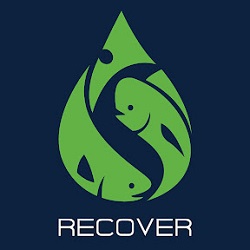 The video was created by former Relationships of Effects of Cardiac Outcomes in fish for Validation of Ecological Risk (RECOVER) consortium outreach coordinator Dan DiNicola and highlights the consortium’s efforts to capture spawning, feeding, and migratory behaviors in wild mahi using PSAT tags.
The video was created by former Relationships of Effects of Cardiac Outcomes in fish for Validation of Ecological Risk (RECOVER) consortium outreach coordinator Dan DiNicola and highlights the consortium’s efforts to capture spawning, feeding, and migratory behaviors in wild mahi using PSAT tags.
The consortia commented: “As a last project Dan created and produced the Directors Cut of last year’s tagging cruise. This cruise took place over the course of three days in the Gulf of Mexico in June, where RECOVER tagged wild mahi with PSAT tags to capture information about spawning, feeding and migratory behaviors. We have posted it below for the all to watch, and to appreciate the talent and dedication that Dan demonstrated as our RECOVER outreach coordinator.
Thank you, Dan for all the amazing work you have done over the past three years. We wish you the best of luck in all new ventures!”
BBC’s Planet Earth: Blue Planet II Features Deep Ocean Research and Scientists
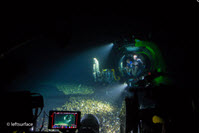
“Magical discovery moments” is how Dr. Samantha “Mandy” Joye describes scenes at the bottom of the ocean. Now, thanks to the BBC-produced documentary series Blue Planet II, we can get a glimpse of these discovery moments and join discussions about the ocean’s importance.
The series, narrated by David Attenborough, includes seven episodes about exploring the world’s ocean. Included in these episodes are footage featuring research by GoMRI-funded consortia Deep Pelagic Nekton Dynamics of the Gulf of Mexico (DEEPEND) and Ecosystem Impacts of Oil and Gas Inputs to the Gulf (ECOGIG).
Watch this video clip Brine Pool: Exploring an Alien World for Blue Planet II featuring oceanographers Drs. Sylvia Earl and Mandy Joye as they dive in a submersible and explore the bottom of the ocean.
This video is a part of Our Blue Planet, a joint venture between Alucia Productions and BBC Earth to get people talking about the ocean.
Resources:
- Video clip Brine Pool of Death is from the Blue Planet II Series The Deep, which features DEEPEND and ECOGIG research footage
- Video clips featuring Dr. Mandy Joye (ECOGIG director): The Future of the Oceans and Searching for Cures in the Deep Sea
- Websites for the BBC’s Blue Planet II and Alucia Productions
- Websites for DEEPEND and ECOGIG
Here are a few stories about GoMRI-funded research in response to the Deepwater Horizon oil spill, which includes DEEPEND and ECOGIG research:
- Two documentaries produced by Screenscope Dispatches from the Gulf are part of the PBS series Journey to Planet Earth.
- Science at Sea: Deep-Sea Research Informs Taxonomic Assessment of Gulf Fauna
- Smithsonian Features Research about Brittle Stars Helping Coral Recover from Oil Spill
- Discovering Vibrant, Dynamic Life in the Deep Gulf of Mexico
- Scientists on Alvin have Eyes on the Bottom of Deepwater Horizon Site
************
The Gulf of Mexico Research Initiative (GoMRI) is a 10-year independent research program established to study the effect, and the potential associated impact, of hydrocarbon releases on the environment and public health, as well as to develop improved spill mitigation, oil detection, characterization and remediation technologies. An independent and academic 20-member Research Board makes the funding and research direction decisions to ensure the intellectual quality, effectiveness and academic independence of the GoMRI research. All research data, findings and publications will be made publicly available. The program was established through a $500 million financial commitment from BP. For more information, visit https://gulfresearchinitiative.org/.
© Copyright 2010-2018 Gulf of Mexico Research Initiative (GoMRI) – All Rights Reserved. Redistribution is encouraged with acknowledgement to the Gulf of Mexico Research Initiative (GoMRI). Please credit images and/or videos as done in each article. Questions? Contact web-content editor Nilde “Maggie” Dannreuther, Northern Gulf Institute, Mississippi State University (maggied@ngi.msstate.edu).
Grad Student Montgomery Explores How Ocean Chemistry Affects Microbes
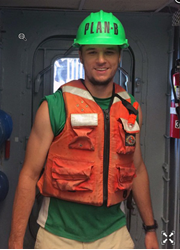
Natural seeps are abundant in the Gulf of Mexico and help create a chemically unique habitat where microbial populations can flourish. Andy Montgomery is researching the relationship between marine microbes and ocean chemistry and how chemical shifts affect the role microorganisms play in biogeochemical cycling, a common pathway for chemicals and organic matter to move through the ocean. His goal is to push the microbes to their limits to determine what they are capable of under extremely stressful conditions to understand how major chemical disturbances, such as oil spills, affect microbial populations and processes.
Andy is a Ph.D. student with the University of Georgia’s Department of Marine Sciences and a GoMRI Scholar with the Ecosystem Impacts of Oil and Gas Inputs to the Gulf-2 (ECOGIG-2) consortium.
His Path
Andy’s grandfathers inspired his love for life and science when he was a child. One grandfather, who lives on a lake, taught him that life is like fishing: the more lines you have in the water, the more adventures you will enjoy. His other grandfather, a biology professor, taught him to appreciate life’s ever-changing forms. These lessons instilled in Andy a desire to understand how life’s components are intertwined and inspired a passion to expand his mind through science and life experiences.
Andy began his graduate career in the University of Georgia’s Integrative Life Science program, an interdisciplinary program that covers many disciplines, including marine sciences, infectious diseases, and biochemistry. The program allowed Andy to experience different labs on campus while he searched for a research focus. While working with Dr. Mandy Joye, her research about environmental influences on marine microbes fascinated him and he wanted to take part in that opportunity. While working in a non-GoMRI position in Joye’s lab, Andy was asked to fill in for an ill researcher aboard an ECOGIG research cruise.
“It was my first chance to go out to sea, and I immediately fell in love with it,” said Andy. “We spent a month on the R/V Endeavor collecting samples in the Gulf of Mexico. I got to see firsthand how amazingly beautiful and fragile our oceans are. With my newfound enthusiasm for going out to sea and working in the Gulf, Mandy and I agreed that ECOGIG research would be a perfect fit for my graduate work.”
His Work
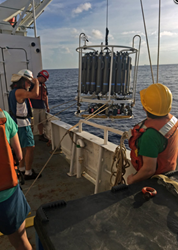
Andy investigates microbes’ response to chemical changes in their environment from two angles. First, he wants to understand how the microbial population responds to major environmental shifts such as oil spills and how the population changes over time after its initial response. He is particularly interested in determining if microbial populations return to pre-event levels or if they experience permanent changes. Second, he wants to determine how microbial processes related to carbon cycling react to environmental changes.
Andy collects Gulf water samples and immediately measures the rates of certain microbial processes (such as carbon degradation or assimilation) to establish their baseline activity. He then supplements the samples with a certain chemical compound, such as methane, oil, or nutrients, that he hypothesizes will affect the organisms. He measures changes in the rates of the microbial processes relative to baseline observations and analyzes genomic data using stable isotope probing and next-generation sequencing. These observations help him determine which microbial populations the chemicals are enriching or inhibiting and if and how microbial processes are altered. His uses these findings to better understand how these microbes may react to similar exposures in the natural environment.
“After the spill, there was a major increase in carbon uptake and usage because organic matter containing carbon was readily available to microorganisms,” explained Andy. “Understanding which geochemical factors control these processes, how that correlates to the microbial population, and how the population changes over time will help us prepare for future oil spills and other disasters.”
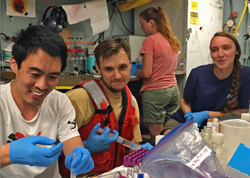
His Learning
Andy’s experiences working in Joye’s lab have helped him understand how important passion is to scientific research. The lab members’ contagious excitement and desire to learn and educate others about the natural world inspire him to give back to society. “The fervor exhibited through their work is unmistakable, and they never stop working to better understand the world we live in,” explained Andy. “I hope this feeling continues to grow and that I am able to leave a positive lasting impact on this Earth through my career.”
His Future
Andy discovered the importance of educating society on scientific issues through teaching undergraduate labs and participating in ECOGIG outreach events such as the Ocean Discovery Zone and Science at the Stadium. He hopes to create future exciting opportunities for others to learn about emerging scientific ideas and findings.
He tells students considering a scientific career to get involved as early and often as they can. “I had the opportunity to do research my freshman year of college. I got hands-on experience from day one and learned a lot of basic lab techniques early on, which greatly helped me advance my skills and knowledge,” he said. “Even if you can’t immediately join a lab, there are many university research courses, citizen science opportunities, or outreach programs to get involved in.”
Praise for Andy
Joye said that during his time in her lab, Andy grew into a thoughtful, meticulous scientist and a passionate and dedicated instructor. She described him as a natural leader with outstanding character, “Andy sets an exceptional example and works tirelessly on his own projects while always being available to give others a hand as needed. He works to not only meet but also exceed expectations and holds himself to a high standard. It is such a pleasure and honor to mentor someone like Andy.”
The GoMRI community embraces bright and dedicated students like Andy Montgomery and their important contributions. The GoMRI Scholars Program recognizes graduate students whose work focuses on GoMRI-funded projects and builds community for the next generation of ocean science professionals. Visit the ECOGIG website to learn more about their work.
************
The Gulf of Mexico Research Initiative (GoMRI) is a 10-year independent research program established to study the effect, and the potential associated impact, of hydrocarbon releases on the environment and public health, as well as to develop improved spill mitigation, oil detection, characterization and remediation technologies. An independent and academic 20-member Research Board makes the funding and research direction decisions to ensure the intellectual quality, effectiveness and academic independence of the GoMRI research. All research data, findings and publications will be made publicly available. The program was established through a $500 million financial commitment from BP. For more information, visit https://gulfresearchinitiative.org/.
© Copyright 2010-2018 Gulf of Mexico Research Initiative (GoMRI) – All Rights Reserved. Redistribution is encouraged with acknowledgement to the Gulf of Mexico Research Initiative (GoMRI). Please credit images and/or videos as done in each article. Questions? Contact web-content editor Nilde “Maggie” Dannreuther, Northern Gulf Institute, Mississippi State University (maggied@ngi.msstate.edu).
Get to Know CWC Researcher Kendall Valentine
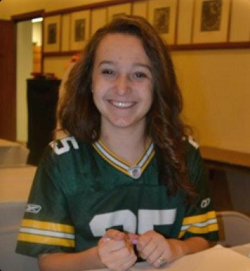 Kendall is an oceanography Ph.D. student at Louisiana State University and a researchers with the Coastal Waters Consortium (CWC). She is in the early stages of her research investigating the transport of suspended sediment in coastal Louisiana. Get to know more about Kendall, her background, and her Barataria Bay research here.
Kendall is an oceanography Ph.D. student at Louisiana State University and a researchers with the Coastal Waters Consortium (CWC). She is in the early stages of her research investigating the transport of suspended sediment in coastal Louisiana. Get to know more about Kendall, her background, and her Barataria Bay research here.
Grad Student Flournoy Emphasizes the Importance of Student Exposure to STEM
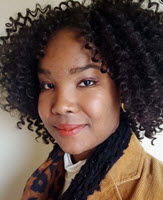
Nikaela Flournoy’s scientific journey has always carried a societal tie, from her passion for research’s social relevance to her realizations about the relationship between society and STEM (science, technology, engineering, and math). Though she is excited to see a greater emphasis on STEM in primary and secondary education, she hopes to help expand STEM awareness and curriculum to students from diverse educational and social backgrounds.
Nikaela recently completed her doctoral studies in the University of Alabama’s Department of Biological Sciences and was honored as a GoMRI Scholar with the Alabama Center for Ecological Resilience (ACER). She continues her ACER research as a post-doctoral researcher at the University of Alabama.
Her Path
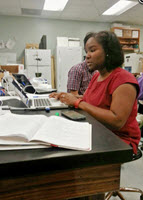
Nikaela learned about the possibilities of scientific research as an undergraduate student at Alabama A&M University. Her high school curriculum included standard science courses but they did not highlight the diverse opportunities a scientific career could hold. “I knew scientific research existed before I attended Alabama A&M, but I didn’t know the scope of it until I was offered the opportunity to work in a research lab,” said Nikaela. She worked as an undergraduate research assistant while completing her biology degree and completed a master’s degree in microbiology at the University of Iowa with a focus on virology.
Nikaela’s educational background provided her with different perspectives in the sciences. While her biology research fostered an interest in environmental microbiology, her virology research generated an awareness about public health and the societal relevance of scientific research. When the 2010 Deepwater Horizon oil spill occurred, Nikaela was still unsure if she wanted to continue her scientific education through a doctoral program. However, the images of the oil as it entered the coastal environment and the expectation of downstream economic impacts inspired her to search for research opportunities where she could use her skillsets for the greater good. “Seeing the graphic imagery within the northern Gulf of Mexico inspired me to pursue research that would utilize my prior skillsets to investigate the interface between the environment and public health,” she said. In 2011, she joined Dr. Patricia Sobecky’s research investigating the long-term effects of Deepwater Horizon on the Alabama coastline, a collaboration with Dr. Behzad Mortazavi’s nitrogen cycling lab at the Dauphin Island Sea Lab (DISL). Their work became part of the ACER project in 2015.
Her Work
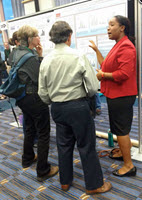
Coastal saltmarshes help remove anthropogenic nitrogen from the coastal ecosystem through processes such as denitrification, a microbial process that reduces nitrate in saltmarsh sediments by releasing it into the atmosphere as nitrogen gas. Large-scale contamination events such as oil spills can potentially cause losses in saltmarsh vegetation, impairing the marsh’s ability to remove nitrogen. Nikaela analyzes DNA in samples from Deepwater Horizon-impacted subtidal and vegetated saltmarshes to understand resident microbes’ presumed contributions to nitrogen removal and its effects on microbial diversity.
Nikaela extracts DNA from sediment samples collected from the Chandeleur Islands five years after it was heavily oiled during Deepwater Horizon and analyzes it using next-generation Illumina sequencing. She applies bioinformatic approaches to determine which bacteria are present and assesses their genetic potential to remove nitrogen. She then compares and contrasts those metrics between saltmarsh conditions to observe how loss of vegetation might impact the marsh’s denitrification potential. So far, Nikaela and her collaborators observed that the average denitrification capacity of vegetated marshes was four-times higher than unvegetated marshes. Denitrifying microbes were equally abundant in both types of marsh, suggesting that vegetation regulates the denitrifiers’ activity rather than their abundance.
Her Learning
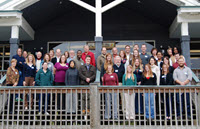
Nikaela’s experiences working with Dr. Sobecky have provided her opportunities to experience many aspects of microbial ecology as it relates to innovation, engagement, and advocacy efforts for women in STEM. She believes that her sharpened drive is a reflection of Sobecky’s own enthusiasm and passion for their research. “Dr. Sobecky always emphasizes the importance of reading older literature, as it contains much of the foundational theory that most metagenomic principles are based on today,” Nikaela said. “She is a consistent source of resources, mentorship, and encouragement, which are critical traits for a graduate advisor. It’s important that young scientists like myself have mentors like Dr. Sobecky who encourage us to be resilient in our research pursuits.”
One of Nikaela’s most memorable moments during her Ph.D. experience was attending the Women of Color STEM Entrepreneurship Conference hosted by the National STEM Collaborative, a consortium focused on supporting minority girls and women in STEM. Sobecky’s involvement with the Collaborative connected Nikaela with the conference and offered her a unique experience that she believes she couldn’t have found anywhere else. “Never before had I been around so many minority women with advanced STEM degrees and careers in one space,” she said. “The outpouring of encouragement from women in all aspects of STEM was amazing.”
Her Future
Nikaela currently works as a post-doctoral researcher in Sobecky’s lab and hopes to eventually work in an administrative position at a historically black college or university (HBCU) and give back to the community that introduced her to research. “I got my start at an HBCU. I feel like it’s my responsibility as a research scientist and educator to teach at an HBCU and provide the next-generation of research scientists with the same opportunities that I had and more,” she said.
Praise for Nikaela
Sobecky described Nikaela as a scientist who shows the strength, perseverance, and work ethic that advisors always hope to see develop in the students and postdocs they mentor. She praised Nikaela for always seeking to learn and bring new knowledge to her research projects. Nikaela’s drive to share science with others and invest in other upcoming scientists particularly stood out to Sobecky, who said “She is dedicated to paying it forward and helping others learn more about STEM and to helping them develop professionally. Nikaela embodies the consummate scientist and science educator that our nation needs to help solve societal issues.”
The GoMRI community embraces bright and dedicated students like Nikaela Flournoy and their important contributions. The GoMRI Scholars Program recognizes graduate students whose work focuses on GoMRI-funded projects and builds community for the next generation of ocean science professionals. Visit the ACER website to learn more about their work.
************
The Gulf of Mexico Research Initiative (GoMRI) is a 10-year independent research program established to study the effect, and the potential associated impact, of hydrocarbon releases on the environment and public health, as well as to develop improved spill mitigation, oil detection, characterization and remediation technologies. An independent and academic 20-member Research Board makes the funding and research direction decisions to ensure the intellectual quality, effectiveness and academic independence of the GoMRI research. All research data, findings and publications will be made publicly available. The program was established through a $500 million financial commitment from BP. For more information, visit https://gulfresearchinitiative.org/.
© Copyright 2010-2018 Gulf of Mexico Research Initiative (GoMRI) – All Rights Reserved. Redistribution is encouraged with acknowledgement to the Gulf of Mexico Research Initiative (GoMRI). Please credit images and/or videos as done in each article. Questions? Contact web-content editor Nilde “Maggie” Dannreuther, Northern Gulf Institute, Mississippi State University (maggied@ngi.msstate.edu).
Science at Sea: Deep-Sea Research Informs Taxonomic Assessment of Gulf Fauna

The deep-pelagic ecosystem was the largest habitat affected by the Deepwater Horizon incident, yet our limited knowledge about its fauna makes it difficult to compare their conditions before and after the spill. Researchers with the DEEPEND consortium are developing a quantitative, taxonomically comprehensive assessment of these deep-sea creatures to estimate their vulnerability and ability to recover from disturbances. The scientists led two research expeditions in 2017 and collected acoustic and physical oceanography data, 113 water samples, and over 10,000 specimens from net sampling.
Casting a Wide Net
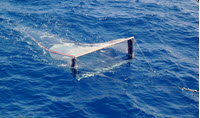
DEEPEND Principle Investigator Dr. Tracey Sutton led the spring-time cruise, which began in Gulfport, Mississippi, and visited stations throughout the northern Gulf, including the Desoto Canyon. His team completed 17 deep-pelagic (surface to 1500 m depth) trawl deployments using the Multiple Opening/Closing Net and Environmental Sensing System (MOCNESS) plus CTD (conductivity, temperature, depth) and multibeam acoustical profiling. Researchers fitted the MOCNESS with an autonomous sonar (WideBand Autonomous Transceiver, WBAT), a new sensor capable of tracking the vertical migrations of individual organisms. Ship sonars can identify where organisms are by measuring sound that they reflect, but do not provide enough information to examine the individuals in each layer of the water column. Using the WBAT technology, the team gathered more detailed information about organisms near the net, which they compared to the information gathered by the ship’s sonar.
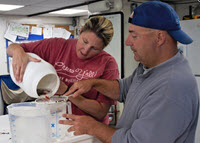
The researchers sorted each catch into major taxon (fishes, crustaceans, squids, and jellyfishes) and identified, measured, weighed, and collected tissue samples from target organisms. Specimens were then stored in ethanol, formalin, or frozen for use in future analyses. The team filtered water samples for microorganisms using sterile 0.45 micron filters and froze the samples for DNA extraction and sequencing at the Nova Southeastern University Oceanographic Center. Using the CTD collections, the team could determine where water masses were located, where maximum photosynthesis occurred, and where distinct microbial communities were located.

Consortium researcher Dr. Michelle Zapp Sluis led the summer ichthyoplankton cruise, which began at the Louisiana Universities Marine Consortium in Chauvin, Louisiana, and visited 47 stations throughout the Mississippi Canyon region. The researchers deployed bongo nets from the back of the boat to collect mesopelagic fish specimens (at ~100 meters depth, at night) and deployed Neuston nets from the side of the boat to collect fish larvae near the sea surface. Collections from nighttime deployments will help the team identify larvae and fishes that vertically migrate on a diel basis. Other collections included zooplankton and associated invertebrate taxa harvested from net contents and Sargassum seaweed for stable isotope analyses. The team will conduct genetic analyses on selected taxa of fishes (e.g., tunas) to confirm their identities.
Building on the Past to Inform the Future
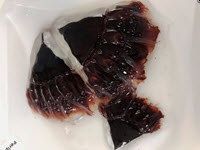
The expeditions are part of the consortium’s three-year sampling and analysis program. The program builds on the field and data management protocols of the NOAA-supported Offshore Nekton Sampling and Analysis Program (ONSAP) and the Deepwater Acoustics Program (DAP), which Sutton and consortium researcher Dr. Kevin Boswell designed and executed in 2010-2011 as part of NOAA’s Natural Resource Damage Assessment (NRDA).
According to Sutton, some of DEEPEND’s most important findings to date include: 1) a dramatic and persistent decline in the numbers of deep-pelagic fishes, shrimps, and squids since 2011; 2) the detection of continued hydrocarbon signatures in the ovaries of female fishes and shrimps, which might indicate a connection between the declines and the oil spill; and 3) the continued discovery of new species and new species’ occurrences in the deep Gulf, furthering the notion that the Gulf is among the world’s most diverse deep-water ecosystems. “One thing that astounds me on every cruise is how diverse the deep Gulf is,” said Sutton. “Despite this being our fifth deep-trawling cruise in addition to the 2011 work we did, we are still finding new things.”
Painting the Bigger Picture

The consortium plans to use samples and data from the two cruises for (1) community analysis and recruitment studies (what and how much lives where, how populations are replacing themselves); (2) genetic studies (did the oil spill change the genetic makeup of Gulf populations); (3) contaminant studies (are there still traces of Deepwater Horizon hydrocarbons in deep-sea animals); (4) physics studies (does the flow of water in the Gulf structure pelagic assemblages); and (5) a host of ecological studies (the food web structure of the deep Gulf and effects on reproduction).
The cruises also contribute to the education and outreach aspects of scientific research through DEEPEND’s Teacher-at-Sea program, daily blogs from scientists, and the growing collection of high-quality and often rare deep-sea photography by Dr. Danté Fenolio (available here on the DEEPEND website).
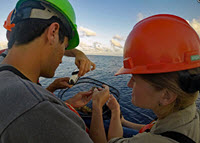
Learn more about DEEPEND research:
- Read: Discovering Vibrant, Dynamic Life in the Deep Gulf of Mexico
- Visit the DEEPEND website and Facebook page
************
This research was made possible in part by a grant from the Gulf of Mexico Research Initiative (GoMRI) to the Deep-Pelagic Nekton Dynamics of the Gulf of Mexico (DEEPEND) consortium.
The Gulf of Mexico Research Initiative (GoMRI) is a 10-year independent research program established to study the effect, and the potential associated impact, of hydrocarbon releases on the environment and public health, as well as to develop improved spill mitigation, oil detection, characterization and remediation technologies. An independent and academic 20-member Research Board makes the funding and research direction decisions to ensure the intellectual quality, effectiveness and academic independence of the GoMRI research. All research data, findings and publications will be made publicly available. The program was established through a $500 million financial commitment from BP. For more information, visit https://gulfresearchinitiative.org/.
© Copyright 2010-2018 Gulf of Mexico Research Initiative (GoMRI) – All Rights Reserved. Redistribution is encouraged with acknowledgement to the Gulf of Mexico Research Initiative (GoMRI). Please credit images and/or videos as done in each article. Questions? Contact web-content editor Nilde “Maggie” Dannreuther, Northern Gulf Institute, Mississippi State University (maggied@ngi.msstate.edu).
Grad Student Hackbusch Pressures Marine Microbes for Information
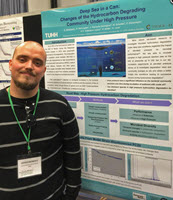
The Deepwater Horizon incident occurred at 1500 m depth, where the pressure is approximately 15 MPa, but little is known about how such high pressure affects the metabolic processes involved with oil biodegradation for bacteria that live there. Steffen Hackbusch conducts laboratory experiments that incubate microbes collected from deep-sea Gulf of Mexico sediment in seawater treated with oil and dispersant in high-pressure reactors mimicking deep-sea conditions. His observations of how the microbes react under high-pressure conditions will help inform future oil spill response as decision makers consider biodegradation at depth as they develop remediation strategies.
Steffen is a microbiology Ph.D. student at the Hamburg University of Technology’s Institute of Technical Biocatalysis and a GoMRI Scholar with the Center for the Integrated Modeling and Analysis of Gulf Ecosystems II (C-IMAGE II).
His Path
Steffen’s interest in science started with having two brothers, “As physical fights became an outdated way to prove who was right, we started using logical arguments and reasoning – and still do over the holidays!” As a high school student, he was fascinated by history and physics and wondered if he could become well-educated simply by reading enough. When he realized that science often identifies as many questions as it does answers, he was hooked.

Steffen initially studied engineering as an undergraduate at the University of Duisburg-Essen hoping to answer questions about how things work. He later changed his degree to water science (a degree path involving biochemistry with a focus on water) after his father, a physics teacher, inspired questions about why things work. While working towards a master’s degree in evolution, ecology, and systematics at Friedrich Schiller University Jena, Steffen attended lectures by Dr. Kirsten Küsel and Dr. Hans-Curt Flemming that sparked his interest in microbial evolution. Following his master’s research, Steffen began his Ph.D. studies at Hamburg University of Technology with Dr. Rudolf Müller and Dr. Andreas Liese, who were searching for a microbiologist to help their team investigate the dynamics of oil fate under deep-sea conditions.
“I enjoy contributing to the scientific process of accumulating knowledge that helps protect the world humans live in, especially the deep sea which is a huge part of our ecosystem that we know little about,” said Steffen.
His Work
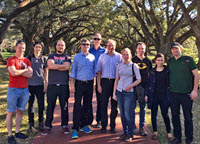
Steffen puts oil-degrading microbes that were collected near the Deepwater Horizon site into high-pressure reactors that simulate deep-sea conditions to observe how they are affected by different pressures. His trials expose microbes to 10 and 15 MPa pressure with 1% v/v of oil (a concentration that caused degradation/growth effects in previous experiments) and dispersant concentrations similar to what was applied at depth during the spill.
Steffen incubates a single oil-degrading species in a reactor tube to see how it deals with pressure alone and then with combinations of pressure and the presence of oil and dispersant. He measures growth and estimates the number of viable bacteria cells after exposure. He repeats the experiment using entire microbial communities collected from upper layers of seafloor sediment near the spill site. Using next-generation sequencing on microbes after exposure treatments, Steffen identifies relative increases and decreases in microbial abundance under different conditions.
Steffen explained that by assessing single species and whole communities, researchers can acquire two perspectives about exposure: an ecological view of how an ecosystem may react and a close-up view of the molecular processes involved with a single species. So far, he observed various microbial responses, with some species experiencing difficulty growing and consuming oil at elevated pressure while others appeared unaffected. Though his exposure trials are still on-going, early results suggest that dispersant may have greater impacts on microbial community structure compared to oil and pressure.
“We hope to contribute to the overall picture dealing with future oil spills by stressing that pressure has to be considered in the microbial degradation of crude oil,” said Steffen. “There are several studies from fellow GoMRI members addressing pressure as a factor that influences bacterial communities, and our research is able to contribute to that discussion.”
His Learning
Working in Dr. Liese’s lab, Steffen learned the importance of team work and was able to view and approach his research from new angles through conversations with his colleagues, particularly fellow graduate student Nuttapol Noirungsee. Collaborating with other researchers and learning about their findings at the annual Gulf of Mexico Oil Spill and Ecosystem Science Conference was a particularly striking experience for Steffen. “Seeing so many bright minds working towards one goal had a lasting impression on me,” he said. “I particularly enjoyed working in an international consortium, where you can meet people from around the world sharing ideas and passions.”
His Future
After defending his thesis, Steffen hopes to continue his journey answering scientific questions and pursuing new challenges and opportunities.
Praise for Steffen
Dr. Liese describes Steffen as a highly motivated scientist with a burning desire to help elucidate the effects of pressure and Corexit dispersant on deep-sea microbes. “Steffen is very eager to teach himself and learn new methods that support his research,” said Dr. Liese. “I am very happy that he is a member of our interdisciplinary team as a microbiologist.”
The GoMRI community embraces bright and dedicated students like Steffen Hackbusch and their important contributions. The GoMRI Scholars Program recognizes graduate students whose work focuses on GoMRI-funded projects and builds community for the next generation of ocean science professionals. Visit the C-IMAGE website to learn more about their work.
By Stephanie Ellis and Nilde Maggie Dannreuther. Contact sellis@ngi.msstate.edu for questions or comments.
************
The Gulf of Mexico Research Initiative (GoMRI) is a 10-year independent research program established to study the effect, and the potential associated impact, of hydrocarbon releases on the environment and public health, as well as to develop improved spill mitigation, oil detection, characterization and remediation technologies. An independent and academic 20-member Research Board makes the funding and research direction decisions to ensure the intellectual quality, effectiveness and academic independence of the GoMRI research. All research data, findings and publications will be made publicly available. The program was established through a $500 million financial commitment from BP. For more information, visit https://gulfresearchinitiative.org/.
© Copyright 2010-2019 Gulf of Mexico Research Initiative (GoMRI) – All Rights Reserved. Redistribution is encouraged with acknowledgement to the Gulf of Mexico Research Initiative (GoMRI). Please credit images and/or videos as done in each article. Questions? Contact web-content editor Nilde “Maggie” Dannreuther, Northern Gulf Institute, Mississippi State University (maggied@ngi.msstate.edu).
Grad Student Ziegler Compares Gulf and East Coast Ecosystems for Predicting Saltmarsh Food Web Responses to Disturbances
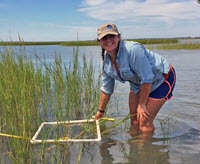
Major disturbances such as oil spills can significantly affect populations of vulnerable saltmarsh species, which may result in greater impacts to the overall saltmarsh food web. Shelby Ziegler believes that a better understanding of what saltmarsh predator-prey interactions look like today can help identify changes in the food web following disturbances in the future.
“If we see a big die-off of a certain species after a major perturbation, we need to know what implications that will have moving up or down the food web,” said Shelby. “This research is vital for future generations to better understand and maintain saltmarsh populations and prepare for the effects of events like oil spills.” Shelby is an ecology Ph.D. student with the University of North Carolina – Chapel Hill and a GoMRI Scholar with the Coastal Waters Consortium II (CWC II).
Her Path
Shelby became fascinated with biology after dissecting fish and marine animals during a high school marine science class. She knew that when she went to college, she wanted to follow a path that would allow her to go out into the field and work directly with the marine life. During her sophomore year at the College of William and Mary, she conducted undergraduate research in Maine and Washington state that explored how different environmental conditions can potentially affect how communities work, fostering her interest in scientific research.
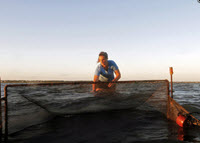
After completing her undergraduate degree, Shelby worked at the Virginia Institute of Marine Science on the Zostera Experimental Network (ZEN), a large global seagrass network. While investigating seagrass systems across the Northern Hemisphere, she realized that important, seemingly similar coastal habitats can have different functions for marine communities. Shelby accepted a graduate position in Dr. Joel Fodrie’s ecology lab at the University of North Carolina investigating how the Deepwater Horizon oil spill affected the coastal saltmarsh food web with CWC. “There’s a common phrase in North Carolina – no wetlands, no seafood,” said Shelby. “The United States is continuously losing its wetlands – over a football field of marsh per day in Louisiana alone. I want to know what that means for our communities and fisheries economy. It’s a huge question that could take a whole career to understand, but I’m hoping my research can provide a little bit of insight.”
Her Work
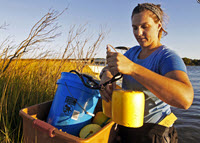
Saltmarshes on the Gulf Coast and East Coast are similar in that they are dominated by Spartina alterniflora and its associated fish and invertebrate communities. Shelby collects and reviews Gulf Coast and East Coast saltmarsh baseline data to help construct an ecosystem model that can depict how the removal of different species by a disaster may affect the marsh food web. “The Gulf of Mexico and East Coast have very similar ecosystems but function in very different ways,” she said. “It’s vital to understand how these systems work in general before we can understand how contamination like the oil spill affected the ecosystem or the community.”
The first phase of Shelby’s research examined saltmarsh predator-prey interactions and how they differed between the Gulf and East coasts. She conducted predation assays comparing (1) oiled and unoiled Louisiana sites and (2) oiled and unoiled Louisiana sites and East Coast sites. She collected periwinkle snails from the marsh, tied them to a tether (similar to a fishing rod), and placed them in the marsh overnight for 24 hours. She then counted how many snails were eaten during that time period. This experiment found no differences between oiled and unoiled Louisiana sites (suggesting food web recovery in oiled sites), but showed significant differences between the Gulf Coast and East Coast. “There are a lot of different mechanisms that could potentially drive the differences observed between the Gulf and East Coasts,” explained Shelby. “Those findings led me to focus on not only single predator-prey interactions but also overall food web dynamics and how they differ between the East Coast and Louisiana.”
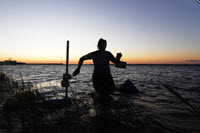
Shelby’s current research examines the diets of fish living in East Coast and Gulf Coast ecosystems. She reviews and analyzes previously published Gulf of Mexico and East Coast literature to determine baseline food web data. Her literature synthesis indicates that key marsh taxa, such as killifish and fiddler crabs, appear absent in the diets of transient Gulf Coast fish but are found regularly in the diets of the same fish species on the East Coast. Depth marsh flooding caused by tidal inundation may influence these species’ interactions across different regions and, if so, there could be an alternative trophic pathway in the Gulf that affects the amount of energy transient fish obtain from the marsh habitat.
She will combine her current findings with gut and tissue analyses conducted by other CWC researchers to construct an ecosystem model reflecting the baseline dynamics of the saltmarsh food web. They hope future researchers can compare gut contents harvested from saltmarsh organisms following a disturbance with their model and interpret observed dietary shifts to determine which species the disturbance most affected.
Her Learning
Shelby’s work with Dr. Fodrie showed her that asking thoughtful questions is key to conducting solid research. Rather than simply thinking up a research question, Fodrie encouraged her to observe the system being researched and identify the important questions based on what she sees.
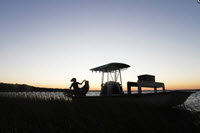
Working with CWC allowed Shelby to interact with established scientists from other fields. She believes she gained a little mentorship from each researcher, which she incorporates into her own research and scientific journey. The collaborative effort also taught her the importance of maintaining a balance between supporting the work of others in your project and making sure your own research gets done. During her first semester as a graduate student, Shelby traveled to Louisiana alone to participate in a sampling effort. “I came down not knowing anyone and was integrated into this large group of scientists who all had their own priorities and were trying to get a ton of sampling done in one week,” she said. “I learned that you have to make sure your own voice is heard as a graduate student and stand up for yourself, because your work is just as important as the work that everyone else is doing.”
Her Future
Shelby hopes to focus her career on asking and answering interesting questions and use her findings to push habitat conservation and restoration efforts. She encourages future students to make sure that their chosen field is one that they love. She said, “Graduate school is hard enough even when your research is something that you’re excited and care about, so fight for yourself and your research interests. That includes having a healthy work-life balance – the happier you are with your life, the more productive you’ll be when it comes to your work.”
Praise for Shelby
Dr. Fodrie describes Shelby as a team player in both his lab and the overall CWC project. “Shelby is a real self-starter and hard worker,” he said. “In just her first two years, she’s already spent a dissertations’ worth of time in the field sampling marsh fishes day and night.” He explained that her research is revealing important details about the marsh food web. In particular, her comparative field research and synthesis work demonstrate that – unlike many East Coast marshes – marsh platform fishes are absent from the diets of larger transient fishes in the Gulf of Mexico, revealing new insights about how oil exposure impacts may propagate or attenuate across food webs. He explained that Shelby is also uniquely positioned to export what they have learned about Gulf of Mexico ecosystem responses to oiling and inform the current debate about the potential risks of oil exploration along the East Coast.
The GoMRI community embraces bright and dedicated students like Shelby Ziegler and their important contributions. The GoMRI Scholars Program recognizes graduate students whose work focuses on GoMRI-funded projects and builds community for the next generation of ocean science professionals. Visit the CWC website to learn more about their work.
************
The Gulf of Mexico Research Initiative (GoMRI) is a 10-year independent research program established to study the effect, and the potential associated impact, of hydrocarbon releases on the environment and public health, as well as to develop improved spill mitigation, oil detection, characterization and remediation technologies. An independent and academic 20-member Research Board makes the funding and research direction decisions to ensure the intellectual quality, effectiveness and academic independence of the GoMRI research. All research data, findings and publications will be made publicly available. The program was established through a $500 million financial commitment from BP. For more information, visit https://gulfresearchinitiative.org/.
© Copyright 2010-2018 Gulf of Mexico Research Initiative (GoMRI) – All Rights Reserved. Redistribution is encouraged with acknowledgement to the Gulf of Mexico Research Initiative (GoMRI). Please credit images and/or videos as done in each article. Questions? Contact web-content editor Nilde “Maggie” Dannreuther, Northern Gulf Institute, Mississippi State University (maggied@ngi.msstate.edu).
Smithsonian Features Research about the Gulf of Mexico’s Highly Diverse Deep-Sea Habitat
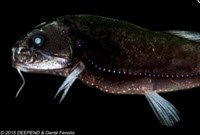
The Smithsonian’s Ocean Portal published an article about the diverse deep sea species found in the Gulf of Mexico following the Deepwater Horizon incident. The DEEPEND research consortium identified nearly 800 different species in Gulf waters, including 180 species not previously observed in the Gulf of Mexico region.
Read the article The Gulf of Mexico: A Deep-Sea Treasure Trove of Fishes to learn more about deep Gulf biodiversity and what factors researchers theorize may be the cause.
- Learn why and how scientists study deep-sea organisms: Discovering Vibrant, Dynamic Life in the Deep Gulf of Mexico
- Learn how researchers map and classify deep-sea organisms: Study Develops Biogeographic Classification of the World’s Deep Oceans
************
GoMRI and the Smithsonian have a partnership to enhance oil spill science content on the Ocean Portal website.
This research was made possible in part by a grant from BP/The Gulf of Mexico Research Initiative (GoMRI) to the Deep-Pelagic Nekton Dynamics of the Gulf of Mexico (DEEPEND) consortium.
The GoMRI is a 10-year independent research program established to study the effect, and the potential associated impact, of hydrocarbon releases on the environment and public health, as well as to develop improved spill mitigation, oil detection, characterization and remediation technologies. An independent and academic 20-member Research Board makes the funding and research direction decisions to ensure the intellectual quality, effectiveness and academic independence of the GoMRI research. All research data, findings and publications will be made publicly available. The program was established through a $500 million financial commitment from BP. For more information, visit https://gulfresearchinitiative.org/.
© Copyright 2010-2018 Gulf of Mexico Research Initiative (GoMRI) – All Rights Reserved. Redistribution is encouraged with acknowledgement to the Gulf of Mexico Research Initiative (GoMRI). Please credit images and/or videos as done in each article. Questions? Contact web-content editor Nilde “Maggie” Dannreuther, Northern Gulf Institute, Mississippi State University (maggied@ngi.msstate.edu).
New Sea Grant Fact Sheet On Federal Laws and Policies that Govern Oil Spill Response

The Sea Grant Oil Spill Outreach Team released a product that gives a concise overview of the Stafford Act (1988) and the Oil Pollution Act (1990) that govern oil spill response. Also explained are how the National Response Framework, the National Contingency Plan, and the Oil Spill Liability Trust Fund fit into the picture.
Read the Federal emergency response framework for oil spills: Stafford Act and Oil Pollution Act and learn about the types of assistance that the Stafford Act authorizes and how the Oil Pollution Act strengthens the government’s ability to prevent oil spills, ensure that they are cleaned up, and restore affected natural resources. Also learn how the National Response Framework assists with initial emergency response, how the National Contingency Plan addresses oil spills during coastal storms, and where money in the Oil Spill Liability Trust Fund comes from and when those funds can be used.
By Nilde Maggie Dannreuther. Contact maggied@ngi.msstate.edu with questions or comments.
************
The Sea Grant Oil Spill Outreach Team synthesizes peer-reviewed science for a broad range of general audiences, particularly those who live and work across the Gulf Coast. Sea Grant offers oil-spill related public seminars across the United States.
Information about upcoming Sea Grant science seminars and recently-held events is available here. To receive email updates about seminars, publications, and the outreach team, click here.
************
GoMRI and the Sea Grant programs of the Gulf of Mexico (Florida, Mississippi-Alabama, Louisiana, and Texas) have partnered to create an oil spill science outreach program.
The Gulf of Mexico Research Initiative (GoMRI) is a 10-year independent research program established to study the effect, and the potential associated impact, of hydrocarbon releases on the environment and public health, as well as to develop improved spill mitigation, oil detection, characterization and remediation technologies. An independent and academic 20-member Research Board makes the funding and research direction decisions to ensure the intellectual quality, effectiveness and academic independence of the GoMRI research. All research data, findings and publications will be made publicly available. The program was established through a $500 million financial commitment from BP. For more information, visit https://gulfresearchinitiative.org/.
© Copyright 2010-2019 Gulf of Mexico Research Initiative (GoMRI) – All Rights Reserved. Redistribution is encouraged with acknowledgement to the Gulf of Mexico Research Initiative (GoMRI). Please credit images and/or videos as done in each article. Questions? Contact web-content editor Nilde “Maggie” Dannreuther, Northern Gulf Institute, Mississippi State University (maggied@ngi.msstate.edu).
Graphics: DEEPEND Photographic Timeline Highlights Deepsea Biodiversity
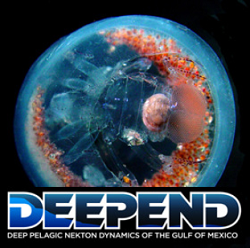 Researchers performed 99 trawl deployments (over 500 samples) during five Gulf of Mexico research cruises. The photographic timeline progresses through catches from different cruise trawls to highlight deepsea biodiversity, including some extremely rare deepsea species.
Researchers performed 99 trawl deployments (over 500 samples) during five Gulf of Mexico research cruises. The photographic timeline progresses through catches from different cruise trawls to highlight deepsea biodiversity, including some extremely rare deepsea species.
Get to Know CWC Researcher Shivakumar Shivarudrappa
 Dr. Shivarudrappa is a Coastal Waters Consortium (CWC) researcher who examines the taxonomic identification of benthic invertebrate fauna to assess how the 2010 Deepwater Horizon oil spill impacted their community. Learn more about his research and scientific journey here.
Dr. Shivarudrappa is a Coastal Waters Consortium (CWC) researcher who examines the taxonomic identification of benthic invertebrate fauna to assess how the 2010 Deepwater Horizon oil spill impacted their community. Learn more about his research and scientific journey here.
Get to Know CWC Researcher William Carter
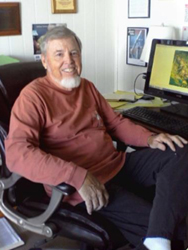 Carter is a Coastal Waters Consortium (CWC) researchers and the chief scientist for the National Center for Airborne Laser Mapping (NCALM), where he collects research-quality airborne lidar, digital photography, and hyperspectral observations for researchers. Learn more about his background and research here!
Carter is a Coastal Waters Consortium (CWC) researchers and the chief scientist for the National Center for Airborne Laser Mapping (NCALM), where he collects research-quality airborne lidar, digital photography, and hyperspectral observations for researchers. Learn more about his background and research here!
Webinar: The Benefits and Challenges of Interdisciplinary Research
 The webinar, titled “The Benefits and Challenges of Interdisciplinary Research,” features Drs. Rajeev Ramchand and Michael Blum as they discuss their experiences collaborating with researchers from other disciplines.
The webinar, titled “The Benefits and Challenges of Interdisciplinary Research,” features Drs. Rajeev Ramchand and Michael Blum as they discuss their experiences collaborating with researchers from other disciplines.
Sea Grant Releases Fact Sheet on Community Response to Oil Spills
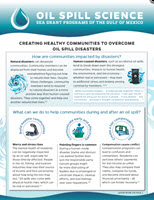
The Sea Grant Oil Spill Outreach Team released a publication that discusses how communities respond to a human-induced incident such as an oil spill as compared to natural disasters. Both types of events can affect the environment, economy, and human health; however, how people respond tends to be different.
Social scientists documented a series of shared effects on residents of the five U.S. Gulf Coast states following the Deepwater Horizon incident. They noted that unlike natural disasters when people tend to come together and help one another, human-induced incidents and related response efforts tend to cause discord. Feelings of stress, anger, and mistrust arise in affected communities, particularly among groups who feel their livelihoods threatened.
The fact sheet Creating healthy communities to overcome oil spill disasters outlines why scientists think certain groups exhibit these feelings and explains research about helping to alleviate or prevent these responses. The fact sheet also contains helpful links to organizations that can offer more information for individuals living in the aftermath of a human-induced incident like an oil spill.
Some of the information in this fact sheet came from earlier, more in-depth Sea Grant publications:
- Top five frequently asked questions about the Deepwater Horizon oil spill,
- The Deepwater Horizon oil spill’s impact on people’s health: Increases in stress and anxiety, and
- Is it safe? Examining health risks from the Deepwater Horizon oil spill.
The Sea Grant Oil Spill Outreach Team synthesizes peer-reviewed science for a broad range of general audiences, particularly those who live and work across the Gulf Coast. Sea Grant offers oil-spill-related public seminars across the Gulf Coast.
Information about upcoming Sea Grant science seminars and recently-held events is available here. To receive email updates about seminars, publications, and the outreach team or to ask a question, click here. To learn more about their work, visit their website.
************
GoMRI and the Sea Grant programs of the Gulf of Mexico (Florida, Mississippi-Alabama, Louisiana, and Texas) have partnered to create an oil spill science outreach program.
The Gulf of Mexico Research Initiative (GoMRI) is a 10-year independent research program established to study the effect, and the potential associated impact, of hydrocarbon releases on the environment and public health, as well as to develop improved spill mitigation, oil detection, characterization and remediation technologies. An independent and academic 20-member Research Board makes the funding and research direction decisions to ensure the intellectual quality, effectiveness and academic independence of the GoMRI research. All research data, findings and publications will be made publicly available. The program was established through a $500 million financial commitment from BP. For more information, visit https://gulfresearchinitiative.org/.
© Copyright 2010-2018 Gulf of Mexico Research Initiative (GoMRI) – All Rights Reserved. Redistribution is encouraged with acknowledgement to the Gulf of Mexico Research Initiative (GoMRI). Please credit images and/or videos as done in each article. Questions? Contact web-content editor Nilde “Maggie” Dannreuther, Northern Gulf Institute, Mississippi State University (maggied@ngi.msstate.edu).
Virtual Reality: RECOVER Announces VR Hatcheries Tour
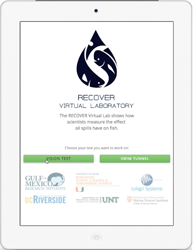 The Relationships of Effects of Cardiac Outcomes in fish for Validation of Ecological Risk (RECOVER) consortium updated their website to create an improved visitor experience, including a Virtual Reality tour of the team’s hatchery facilities. Users visiting the site on their mobile smartphone can take the free tour directly on their device using the Wonda VR software. The renovated site can be found at its new web address, http://
The Relationships of Effects of Cardiac Outcomes in fish for Validation of Ecological Risk (RECOVER) consortium updated their website to create an improved visitor experience, including a Virtual Reality tour of the team’s hatchery facilities. Users visiting the site on their mobile smartphone can take the free tour directly on their device using the Wonda VR software. The renovated site can be found at its new web address, http://
Smithsonian Features Research about Brittle Stars Helping Coral Recover from Oil Spill
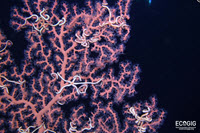
The Smithsonian’s Ocean Portal published an article about deep sea coral affected by the Deepwater Horizon incident and how their recovery is linked to the sea creature that lives on them. The ECOGIG research consortium are monitoring the health of these corals over time using high-resolution imagery, and they have made some amazing discoveries.
Read the article A Brittle Star may be a Coral’s Best Friend to learn more about the mutually beneficial relationship of brittle stars and coral.
- Learn why and how scientists study these corals: Jewels of the Gulf: Deep-sea Coral Educational Video Series
- Get more scientific details: Study Suggests Brittle Stars Limited Deepwater Horizon Impacts on Deep Sea Corals
************
GoMRI and the Smithsonian have a partnership to enhance oil spill science content on the Ocean Portal website.
This research was made possible in part by a grant from BP/The Gulf of Mexico Research Initiative (GoMRI) to the Ecosystem Impacts of Oil and Gas Inputs to the Gulf (ECOGIG).
The GoMRI is a 10-year independent research program established to study the effect, and the potential associated impact, of hydrocarbon releases on the environment and public health, as well as to develop improved spill mitigation, oil detection, characterization and remediation technologies. An independent and academic 20-member Research Board makes the funding and research direction decisions to ensure the intellectual quality, effectiveness and academic independence of the GoMRI research. All research data, findings and publications will be made publicly available. The program was established through a $500 million financial commitment from BP. For more information, visit https://gulfresearchinitiative.org/.
© Copyright 2010-2018 Gulf of Mexico Research Initiative (GoMRI) – All Rights Reserved. Redistribution is encouraged with acknowledgement to the Gulf of Mexico Research Initiative (GoMRI). Please credit images and/or videos as done in each article. Questions? Contact web-content editor Nilde “Maggie” Dannreuther, Northern Gulf Institute, Mississippi State University (maggied@ngi.msstate.edu).
Research Teams Show Hurricane Readiness and Resilience
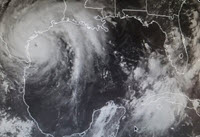
The 2017 hurricane season was one of the most active and destructive on record and included two major storms that affected the U.S. Gulf Coast – Harvey and Irma. Scientists who lead consortia funded by the Gulf of Mexico Research Initiative are based in this area, and they shared how they and their teams prepared for and fared after the storms.
Florida-based teams prepared for the worse as a category 5 Irma barreled towards them after causing massive destruction in the Caribbean and the Florida Keys. The storm had weakened to a category 3 when it landed in south Florida, and the hurricane-ready research teams fared well.
Martin Grosell with the RECOVER consortium at the University of Miami said infrastructure had minor damage, and the campus closed for 8-10 days. Though it slowed the group’s research progress, they are back on schedule and repairs are approaching completion. Their storm preparations to preserve fish that they use in oil spill studies really paid off, “Our fish did much better than we could have hoped for, in part, due to the transfer to the SUSTAIN tank.” Ironically, the safest place for many of these important fish during a hurricane was in a machine that creates hurricanes! Read more about the fish transfer to the SUSTAIN facility, the world’s largest hurricane simulator.
Tracey Sutton with the DEEPEND consortium at Nova Southeastern University reported that their faculty labs, designed to withstand the most powerful hurricanes, did not sustain damage and their backup generators provided continuous power that kept their samples safe. The CARTHE team at the University of Miami similarly reported escaping Irma with little damage. Professor Shuyi Chen and her team ran coupled atmosphere-wave-ocean models for both hurricanes showing different characteristics that produced distinct impacts.
Texas-based teams were not as fortunate during Hurricane Harvey, which caused damage to the Texas coast that to-date is the costliest recorded.
Antonietta Quigg with the ADDOMEx consortium at The Texas A&M University-Galveston reported the campus sustained water damage and closed for safety reasons. Faculty, staff, and students living on the mainland were not able to return to work; however, the team rallied as Quigg described, “ADDOMEx’ers in Galveston worked at home on papers, read, and planned with colleagues to look at oil spills in and around the Houston area. Many team members worked very hard to help family, friends and colleagues who had been negatively impacted… mucking out houses, cooking, and other activities.” A few days later, team members collected samples to assess impacts in Galveston Bay, finding some elevated presence of oil.
Ed Buskey leads the DROPPS consortium at The University of Texas Marine Science Institute in Port Aransas, which sustained a direct hit. Estimates of damage are in the tens of millions. “Everything happened so fast…that was the most challenging thing,” recalled Buskey. “We have a detailed hurricane plan, but storms that form in the Bay of Campeche are the ones that really get us.” Storms that move across the Gulf from the Atlantic usually give them about a week’s preparation time. “At our first two planning meetings, Harvey was a Tropical Storm, and then the word was that it would be a Category 1, not likely for a mandatory evacuation. We started our preparations with that in mind.” The next morning, the forecast was for a Category 3 storm with mandatory evacuation off the island by 9 PM that night. “Our labs closed at 1. We really had to rush to finish preparations at the institute, and then prep our homes.”
Buskey said the team did a fantastic job, backing up hard drives, covering equipment with plastic, and moving things to a LEED Gold certified building. “That was supposed to be the strongest building on our campus, designed to withstand Category 3.” However, it was badly damaged with roof and window failures, resulting in standing water. Most plastic-covered electronics were safe, initially, but the loss of power and air conditioning for over a week compromised them.
Damages to research equipment and facilities included a gas chromatograph mass spectrometer for oil sample analysis. A new one is on its way, thanks to the director’s discretionary funds. The outdoor mesocosm tanks stayed in place because the team filled them with water, but its heating and cooling system was damaged. The zooplankton samples used in mesocosm experiments were in storage and survived. “We were actually running a set of experiments the week that Harvey came, our last ones for DROPPS 2. Even though we cut them a few hours short, we managed to complete it.”
The protozoa cultures that they use in experiments were lost. “The storm’s intensity affected the diesel generator, it didn’t start up, and the incubators were without power for several days. Normally we have those cultures on our emergency circuits and those worked in the past, but not this time. Fortunately, those experiments were almost complete.”
Other losses included their research pier, which was destroyed when a drilling rig ship became unmoored during the storm and ran into the pier, and two monitoring stations out in the bay of the National Estuarine Research Reserve, which Buskey leads.
Buskey said they have enough to make do and get things going again, “People are scattered, some are at UTMSI, some at Harte Research Institute, spread across different floors. Everything is a little more challenging and takes extra effort, but we’re making progress. Our classes are going, we are carving out small areas of research space, and getting some equipment set up.” While it is hard to predict how long it will take, he estimates closer to year’s end before everything is done.
Buskey and other administrators are busy helping prepare insurance claims and working with FEMA to assess damages. The university provided $5M to get recovery started, and student housing, which was destroyed, is top priority. Graduate students have struggled with additional expenses of renting apartments in Corpus Christi and traveling between campuses, but construction may be complete in another month or so.
“We had really great support from Texas A&M University-Corpus Christi by hosting us here and from UT Austin. Our marine science advisory council gave over $130K in personal donations for immediate help to students and some lab personnel. We are also using crowd sourcing to raise money for people here at UTMSI.”
Several DROPPS team members’ homes were nearly or completely destroyed, leaving them with only what they took when they evacuated. Others with less severe damage are steadily making repairs, though it is slow as demand for workers remains high.
If you would like to learn about supporting Hurricane Harvey recovery at UTMSI, go to https://hornraiser.utexas.edu/project/7548.
************
The Gulf of Mexico Research Initiative or GoMRI is a 10-year independent research program established to study the effect, and the potential associated impact, of hydrocarbon releases on the environment and public health, as well as to develop improved spill mitigation, oil detection, characterization and remediation technologies. An independent and academic 20-member Research Board makes the funding and research direction decisions to ensure the intellectual quality, effectiveness and academic independence of the GoMRI research. All research data, findings and publications will be made publicly available. The program was established through a $500 million financial commitment from BP. For more information, visit https://gulfresearchinitiative.org/.
© Copyright 2010-2018 Gulf of Mexico Research Initiative (GoMRI) – All Rights Reserved. Redistribution is encouraged with acknowledgement to the Gulf of Mexico Research Initiative (GoMRI). Please credit images and/or videos as done in each article. Questions? Contact web-content editor Nilde “Maggie” Dannreuther, Northern Gulf Institute, Mississippi State University (maggied@ngi.msstate.edu)
Sea Grant Releases Bulletin on Corals and Oil Spills

The Sea Grant Oil Spill Outreach Team released a publication that explains which corals were affected by the Deepwater Horizon incident and how scientists are monitoring those corals. The bulletin also describes the important roles that corals play in maintaining a healthy ocean and how corals worldwide struggle in the face of constant, multiple threats.
The bulletin, Corals and Oil Spills presents the latest science about how the oil spill affected deep-sea octocorals, some mid-depth coral, and the role that response methods, including dispersants use, played in coral health.
The Sea Grant Oil Spill Outreach Team synthesizes peer-reviewed science for a broad range of general audiences, particularly those who live and work across the Gulf Coast. Sea Grant offers oil-spill-related public seminars across the Gulf Coast.
Information about upcoming Sea Grant science seminars and recently-held events is available here. To receive email updates about seminars, publications, and the outreach team, click here.
************
GoMRI and the Sea Grant programs of the Gulf of Mexico (Florida, Mississippi-Alabama, Louisiana, and Texas) have partnered to create an oil spill science outreach program.
The Gulf of Mexico Research Initiative (GoMRI) is a 10-year independent research program established to study the effect, and the potential associated impact, of hydrocarbon releases on the environment and public health, as well as to develop improved spill mitigation, oil detection, characterization and remediation technologies. An independent and academic 20-member Research Board makes the funding and research direction decisions to ensure the intellectual quality, effectiveness and academic independence of the GoMRI research. All research data, findings and publications will be made publicly available. The program was established through a $500 million financial commitment from BP. For more information, visit https://gulfresearchinitiative.org/.
© Copyright 2010-2018 Gulf of Mexico Research Initiative (GoMRI) – All Rights Reserved. Redistribution is encouraged with acknowledgement to the Gulf of Mexico Research Initiative (GoMRI). Please credit images and/or videos as done in each article. Questions? Contact web-content editor Nilde “Maggie” Dannreuther, Northern Gulf Institute, Mississippi State University (maggied@ngi.msstate.edu).
ECOGIG PI Featured on GulfCast Podcast
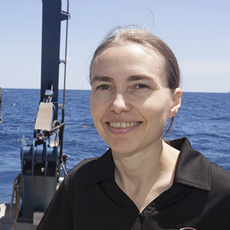 Dr. Mandy Joye recently appeared on the show to discuss her research on the ocean’s microbial “worker bees,” which carry out critical processes that keep the ocean healthy, and their reaction to the Deepwater Horizon oil spill.
Dr. Mandy Joye recently appeared on the show to discuss her research on the ocean’s microbial “worker bees,” which carry out critical processes that keep the ocean healthy, and their reaction to the Deepwater Horizon oil spill.
Lesson Plan: Nature of Science Deep-sea STEM Module (Grades 6-12)
 The new module Nature of Science targets grades 6-12 and utilizes consortium research data to clearly describe the scientific method, including what is science, how is science conducted, and how is science communicated. The full 45-page module is available for download from the DEEPEND website and here on the GoMRI Education site.
The new module Nature of Science targets grades 6-12 and utilizes consortium research data to clearly describe the scientific method, including what is science, how is science conducted, and how is science communicated. The full 45-page module is available for download from the DEEPEND website and here on the GoMRI Education site.
Video: “Motion of the Ocean” Shows Technology Used to Study Currents
 Scientists completed four field experiments in the Gulf of Mexico, linking the dynamics of deep ocean, shelf, and coastal surface currents (where materials such as oil or debris naturally accumulate) in a way that has never been done before. So how did they do that?
Scientists completed four field experiments in the Gulf of Mexico, linking the dynamics of deep ocean, shelf, and coastal surface currents (where materials such as oil or debris naturally accumulate) in a way that has never been done before. So how did they do that?
The team representing 30 universities used 2,000 custom-made, biodegradable, GPS-equipped drifters; 15,000 biodegradable drift cards; hundreds of thousands of infrared images and high-resolution photos; 5 drones; 6 small boats; 2 planes; 2 research vessels; and a suite of instruments that measured physical properties and conditions of water and the atmosphere. Whew!
Take a look at the technology that researchers with the CARTHE consortium used to answer the question: Where is water going to go in the ocean? The data they collected will help develop the next generation of ocean circulation models.
Motion of the Ocean from CARTHE on Vimeo. Video credit: Waterlust
The CARTHE experiments have far-reaching applications with new scientific insights that can inform navigation, energy production, climate science, hurricane predictions, search and rescue, beach safety, and tracking floating non-biodegradable plastics pollution, which is a rapidly growing ocean problem.
Read more about the Gulf of Mexico field experiments that these scientists conducted:
- Science at Sea: SPLASH Experiment Improves Predictions for Oil Moving toward Shore
- LASER Focus Advances Knowledge of How Gulf of Mexico Water Moves
- Tracking the Last Mile Before Oil Meets the Beach
- CARTHE at Sea: A Grand Experiment for Transformative Research in Gulf Oil Studies
************
This research was made possible in part by a grant from the Gulf of Mexico Research Initiative (GoMRI) to the Consortium for Advanced Research on Transport of Hydrocarbon in the Environment II (CARTHE II) and CARTHE I. Other funding sources included the Office of Naval Research (Grant #N000141110087).
The Gulf of Mexico Research Initiative (GoMRI) is a 10-year independent research program established to study the effect, and the potential associated impact, of hydrocarbon releases on the environment and public health, as well as to develop improved spill mitigation, oil detection, characterization and remediation technologies. An independent and academic 20-member Research Board makes the funding and research direction decisions to ensure the intellectual quality, effectiveness and academic independence of the GoMRI research. All research data, findings and publications will be made publicly available. The program was established through a $500 million financial commitment from BP. For more information, visit http://gulfresearchinitiative.org/.
© Copyright 2010- 2017 Gulf of Mexico Research Initiative (GoMRI) – All Rights Reserved. Redistribution is encouraged with acknowledgement to the Gulf of Mexico Research Initiative (GoMRI). Please credit images and/or videos as done in each article. Questions? Contact web-content editor Nilde “Maggie” Dannreuther, Northern Gulf Institute, Mississippi State University (maggied@ngi.msstate.edu).
Grad Student Leftwich Unites Dolphin Research and Secondary Education
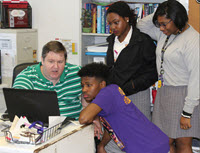
Researchers believe that large numbers of deep-diving marine mammals were living near the Deepwater Horizon site during the 2010 spill and may have experienced changes in their population distribution and abundance. Kendal Leftwich conducts acoustic research assessing how northern Gulf of Mexico dolphin populations changed and recovered over time to help researchers better understand the health of dolphin species living in affected areas.
Kendal also has been a bridge for a distinctive partnership with high school students, using his dolphin research as a platform to provide students with firsthand experiences conducting collaborative scientific research. During the 2015 – 2016 academic year, he taught the students how to analyze acoustic data for marine mammal sounds and compare the sounds to those described in scientific publications to determine their species.
Kendal is a Ph.D. student at the University of New Orleans Department of Physics and a GoMRI Scholar with the Littoral Acoustic Demonstration Center – Gulf Ecological Monitoring and Modeling (LADC-GEMM).
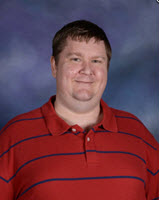
His Path
Kendal discovered his passion for physics while pursuing a degree in secondary mathematics education at the University of New Orleans (UNO). While taking an elective physics class, he realized his interest in math stemmed from the practical applications available through physics. As Kendal began teaching physics at Warren Easton Charter High School in New Orleans, Louisiana, he also began a master’s degree in physics at UNO where he met Professor Juliette Ioup.
Dr. Ioup uses ocean acoustics to study Gulf of Mexico dolphin populations with LADC-GEMM, a consortium that grew from the Littoral Acoustic Demonstration Center founded by the late Dr. George Ioup. Kendal became interested in analyzing underwater acoustical data for dolphin research through conversations with Dr. Juliette Ioup and began a physics Ph.D. program there. Later, Dr. Ioup offered him a graduate research position with LADC-GEMM.
His Work
Kendal uses signal processing techniques to observe dolphin populations since the Deepwater Horizon incident. Signal processing refers to the analysis or modification of a signal to gather new information from it, such as filtering an audio clip to hear faint or inaudible sounds more clearly. He processes acoustic data collected in 2015 using a LADC-GEMM-developed computer algorithm and statistical method to estimate the population densities of various dolphin species at certain northern Gulf of Mexico sites.
The algorithm analyzes the acoustic data and identifies marine mammal vocalizations or “clicks” that fall within the parameters Kendal provides. Because clicks that occur at a high frequency usually belong to dolphins, he uses the program to filter the data for all clicks above a certain frequency and to identify various types of dolphins. He then estimates the population density of dolphins in the area. Kendal plans to repeat this process with acoustic data collected in 2017 to track changes in the dolphins’ population over time.
His Learning
Working with Dr. Ioup, Kendal experienced scientific research first-hand and gained an understanding of the time, resources, and skills necessary for a successful project. He honed his signal processing skills through her mentorship, particularly in relation to Fourier transformation techniques and their applications. “Thanks to her guidance, my ability to perform research has grown from a task where I required a great deal of guidance to one I can lead and guide others to complete,” he said.

Kendal applied this personal growth to his mentorship of five Warren Easton Charter High School AP science students, who worked with him as research assistants during his data analysis. Students submitted weekly PowerPoint presentations documenting their analyses of the signals found, including the times and locations. His goal was to teach the students how to work independently using scholarly works to analyze and interpret data and to communicate and collaborate in a professional environment.
“I initially began working with the LADC-GEMM data hoping to gain experience, publish some research papers, and work with the physics and mathematics of signal processing,” said Kendal. “Over the last year, my motivations have grown with my experience and now include helping younger students learn how to conduct scientific research and work with a research group.”
Kendal presented his methods and experiences at the 2017 Gulf of Mexico Oil Spill and Ecosystem Science conference in a talk titled “Engaging High School Students in Studying Marine Mammals Observed near the BP Oil Spill.” He used this presentation as a proof of concept when approaching local school administrators about including more schools and students with the hands-on learning opportunity. “The program quickly developed into more than I expected, and the students learned a great deal about research, collaboration, work ethic, and being part of a university-level group,” he said. “Now, we are growing the program into a city-wide consortium of high school students working with LADC-GEMM data. We currently have four schools with approximately 40-50 students each who are working on various aspects of the data or in LADC-GEMM-related areas.”
His Future
Kendal wants to work as a university physics professor, where he can continue learning as a researcher and teach others through his courses. He suggests that students considering a scientific career should be determined and keep a positive attitude, which are keys to success in the face of obstacles. “One of the things that I like to tell my students on the first day of class is that my class is not about how smart you are – it is about how hard are you willing to work,” he said. “Scientific research is not easy and will have challenges and setbacks. The determining factor in your success is your ability to not get discouraged and continue working hard.”
Praise for Kendal
Dr. Ioup described Kendal as a diligent student who often asks thoughtful, difficult, and relevant questions. She praised Kendal’s sense of humor and his ability to connect with students at all levels. She has been impressed with both the research he is doing in her lab and his outreach work, “He is very much ahead of me in the outreach programs. I will make a suggestion only to find out he is already doing it. He works very hard all the time, including weekends, which is easy to understand with all that he is able to accomplish.”
The GoMRI community embraces bright and dedicated students like Kendal Leftwich and their important contributions. The GoMRI Scholars Program recognizes graduate students whose work focuses on GoMRI-funded projects and builds community for the next generation of ocean science professionals. Visit the LADC-GEMM website to learn more about their work.
************
The Gulf of Mexico Research Initiative (GoMRI) is a 10-year independent research program established to study the effect, and the potential associated impact, of hydrocarbon releases on the environment and public health, as well as to develop improved spill mitigation, oil detection, characterization and remediation technologies. An independent and academic 20-member Research Board makes the funding and research direction decisions to ensure the intellectual quality, effectiveness and academic independence of the GoMRI research. All research data, findings and publications will be made publicly available. The program was established through a $500 million financial commitment from BP. For more information, visit https://gulfresearchinitiative.org/.
© Copyright 2010-2018 Gulf of Mexico Research Initiative (GoMRI) – All Rights Reserved. Redistribution is encouraged with acknowledgement to the Gulf of Mexico Research Initiative (GoMRI). Please credit images and/or videos as done in each article. Questions? Contact web-content editor Nilde “Maggie” Dannreuther, Northern Gulf Institute, Mississippi State University (maggied@ngi.msstate.edu)
Smithsonian Highlights Research about Acoustic Monitoring of Beaked Whales

The Smithsonian recently published an article about how researchers are using sound or echolocation to learn more about the elusive beaked whale. Some of these whales live and forage in the vicinity where the Deepwater Horizon incident happened, and researchers are monitoring their numbers and location to learn how the oil spill may have affected their populations.
Read the article Seeing with Sound: Acoustic monitoring of beaked whales can help determine oil spill impacts where researchers Kait Frasier, Simone Baumann-Pickering, and John A. Hildebrand (Scripps Institution of Oceanography) explain how they are studying these fascinating creatures.
************
GoMRI and the Smithsonian have a partnership to enhance oil spill science content on the Ocean Portal website.
This research was made possible in part by a grant from BP/The Gulf of Mexico Research Initiative (GoMRI) to the Center for the Integrated Modeling and Analysis of Gulf Ecosystems II (C-IMAGE II).
The GoMRI is a 10-year independent research program established to study the effect, and the potential associated impact, of hydrocarbon releases on the environment and public health, as well as to develop improved spill mitigation, oil detection, characterization and remediation technologies. An independent and academic 20-member Research Board makes the funding and research direction decisions to ensure the intellectual quality, effectiveness and academic independence of the GoMRI research. All research data, findings and publications will be made publicly available. The program was established through a $500 million financial commitment from BP. For more information, visit https://gulfresearchinitiative.org/.
© Copyright 2010-2018 Gulf of Mexico Research Initiative (GoMRI) – All Rights Reserved. Redistribution is encouraged with acknowledgement to the Gulf of Mexico Research Initiative (GoMRI). Please credit images and/or videos as done in each article. Questions? Contact web-content editor Nilde “Maggie” Dannreuther, Northern Gulf Institute, Mississippi State University (maggied@ngi.msstate.edu)
Grad Student Hoover Examines How Freshwater Discharge Affects Gulf Larval Fish
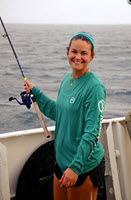
Responders to the 2010 Deepwater Horizon incident sought to reduce the amount of shoreline oiling by diverting an increased amount of Mississippi River outflow into the Gulf of Mexico. The Army Corps of Engineers opened the Bonnet Carré Spillway in 2016, which diverted Mississippi River water into the Mississippi Sound, to relieve pressure on the Louisiana levee system following heavy rainfall. While these actions may have been necessary, surges of freshwater and nutrients into coastal and shelf waters can place stress on the marine environment.
Angie Hoover wants to know how large freshwater pulses and other environmental stressors affect the diet, growth, and condition of larval fishes. “The main motivation behind my work is to do something that betters the planet,” said Angie. “There is a lot of anthropogenic-sourced stress on the Earth, and I want to provide data and information that can help mitigate these issues.”
Angie is a master’s student with the University of Southern Mississippi’s Division of Coastal Sciences and a GoMRI Scholar with the Consortium for Oil Spill Exposure Pathways in Coastal River-Dominated Ecosystems (CONCORDE).
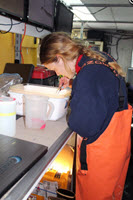
Her Path
Angie grew up in a landlocked Oklahoma town, so she asked that her family vacation at the beach where she could explore the seashore. That desire remained with her, and when she began her undergraduate degree, she never considered a career path other than studying the ocean and its organisms. “I have always found myself wondering how organisms interact with each other and their environments,” said Angie. “The connections formed between organisms and the complexity of marine habitats and food webs especially piqued my interest.”
Angie completed an undergraduate degree in biology at Southwestern Oklahoma State University, which had coastal connections through a partnership with the University of Southern Mississippi (USM). She spent two summers taking classes at USM’s Gulf Coast Research Laboratory where she later began a coastal sciences master’s degree in Dr. Frank Hernandez’s fisheries oceanography and ecology lab.
Her Work
Angie is investigating how the resulting hydrographic changes after the Bonnet Carré diversion and hypoxic zones affect important survival factors such as diet, growth, and condition in larval fish species. “Because riverine diversions were used to keep the oil offshore after Deepwater Horizon, understanding how diversions impact larval fish, especially those important to the fisheries industry, will be important if they are used for future spill response,” she said.
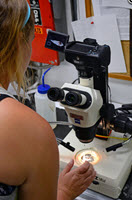
CONCORDE researchers identified water masses in the Mississippi Sound/Chandeleur Sound, Mobile Bay, and Birdsfoot Delta to compare the prey field (zooplankton), diet, growth, and condition of Gulf menhaden (Brevoortia petronus) across different physical and biological environments. Angie and her colleagues conducted a research cruise shortly after the Bonnet Carré opening to capture fish specimens using a paired bongo net and later sorted the plankton samples for fish larvae.
Angie’s first research goal uses Gulf menhaden to identify potential impacts of diversion-driven changes to Mississippi Sound hydrography. Gulf menhaden were abundant in all of her team’s samples and provided a useful sample size for comparison studies among water masses. Angie imaged and measured the Gulf menhaden larvae and removed their guts and otoliths (an inner ear bone that reflects a fish’s growth). She identified and counted the gut contents to determine the fish’s diets and weighed and measured the fish to determine each organism’s condition.
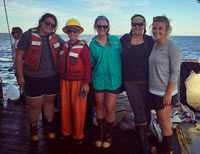
Angie’s findings so far show that although larvae diets were not statistically different among water masses, growth and condition did vary significantly. The abundance and community composition of their zooplankton prey differed in the northern Mississippi Sound/Chandeleur Sound compared to Mobile Bay and Birdsfoot Delta. She explained that freshwater influxes can cause changes in temperature and salinity that alter the planktonic communities that larval fish prey upon, potentially leading to reductions in the larvae’s growth and condition.
Angie’s next step will be to investigate how a different environmental stressor, seasonally occurring coastal hypoxia, influences larval fish diet, growth, and condition. During a summer research cruise, she used a multinet plankton sampler to collect plankton at different depths in the water column, including hypoxic and normoxic environments. She will compare the diet, growth, and condition of larvae collected from hypoxic water to those in water with normal oxygen levels to determine if hypoxia played a role in any observed differences.
Her Learning
Working with Dr. Hernandez provided Angie with valuable experience and knowledge about the various aspects of scientific research. Through her work, she learned not only technical skills such as field sampling techniques, sample processing, and species identification, but also important networking and communication skills to share her research and collaborate with other scientists. “Throughout my years at USM, I gained a better understanding of the metrics and analyses used in the field of larval fish ecology, what is feasible and important for developing a project, and how to write and communicate my science effectively and efficiently,” she said.
Angie faced her struggles with public speaking head-on at the 2017 Gulf of Mexico Oil Spill and Ecosystem Science Conference in New Orleans, Louisiana. The conference was her first oral presentation to expert researchers – a particularly intimidating situation for her. “Being able to successfully present my work and answer questions from the GoMRI community helped me see myself as a part of the scientific community rather than just another student,” she explained. “It was a breakthrough I needed to experience, and GoMRI provided the platform.”
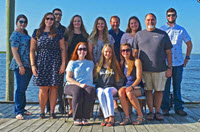
Her Future
Angie’s graduate school experiences strengthened her love for ocean sciences and her interest in deciphering data. She hopes to find a laboratory or agency technician position and expand her skills and knowledge about the interactions between anthropogenic disturbances and fisheries ecology and oceanography. She suggests that students interested in a scientific career should expand their traditional ideas about a scientific career path and make their own opportunities. “As someone with little to no aquatic experience who spent the majority of her life in a landlocked state, I have learned that everyone’s path is different,” she said. “As long as you are taking as much action as possible to build your skills and knowledge base and are passionate about succeeding in your field, you will get your chance.”
Praise for Angie
Dr. Hernandez described Angie as a tremendous asset to his lab and to CONCORDE research. He said that her research on larval fish diet, growth, and condition exceeds their originally proposed research objectives. “She has excelled both at sea collecting data and in the laboratory processing samples,” he said. “She has a tremendous work ethic, a strong commitment to her research, and the respect of all of her lab mates – especially her mentor.”
The GoMRI community embraces bright and dedicated students like Angie and their important contributions. The GoMRI Scholars Program recognizes graduate students whose work focuses on GoMRI-funded projects and builds community for the next generation of ocean science professionals. Visit the CONCORDE website to learn more about their work.
************
The Gulf of Mexico Research Initiative (GoMRI) is a 10-year independent research program established to study the effect, and the potential associated impact, of hydrocarbon releases on the environment and public health, as well as to develop improved spill mitigation, oil detection, characterization and remediation technologies. An independent and academic 20-member Research Board makes the funding and research direction decisions to ensure the intellectual quality, effectiveness and academic independence of the GoMRI research. All research data, findings and publications will be made publicly available. The program was established through a $500 million financial commitment from BP. For more information, visit https://gulfresearchinitiative.org/.
© Copyright 2010-2017 Gulf of Mexico Research Initiative (GoMRI) – All Rights Reserved. Redistribution is encouraged with acknowledgement to the Gulf of Mexico Research Initiative (GoMRI). Please credit images and/or videos as done in each article. Questions? Contact web-content editor Nilde “Maggie” Dannreuther, Northern Gulf Institute, Mississippi State University (maggied@ngi.msstate.edu).
Teachers Participate in ECOGIG Research Expedition
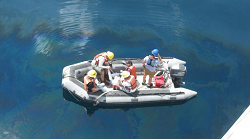 Two Georgia middle school teachers recently joined a consortium research cruise through the AMP-IT-UP (Advanced Manufacturing and Prototyping Integrated to Unlock Potential) program, a multi-year grant focused on cultivating the next generation of STEM innovators. The research was relevant not only for the teachers but also for their students, who have been studying AMP-IT-UP curriculum modules on the Gulf ecosystems. Learn more about the program and the educators’ experiences here.
Two Georgia middle school teachers recently joined a consortium research cruise through the AMP-IT-UP (Advanced Manufacturing and Prototyping Integrated to Unlock Potential) program, a multi-year grant focused on cultivating the next generation of STEM innovators. The research was relevant not only for the teachers but also for their students, who have been studying AMP-IT-UP curriculum modules on the Gulf ecosystems. Learn more about the program and the educators’ experiences here.
Webinar: CRGC Student Webinar Explores the Graduate School Process
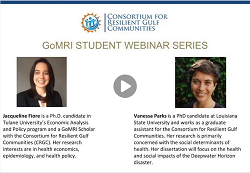 Graduate students Jacqueline Fiore and Vanessa Parks recently discussed their graduate school experiences and working on a transdisciplinary research team in a recent webinar for the Student Spotlight Series. Watch the webinar here.
Graduate students Jacqueline Fiore and Vanessa Parks recently discussed their graduate school experiences and working on a transdisciplinary research team in a recent webinar for the Student Spotlight Series. Watch the webinar here.
Sea Grant Releases Fact Sheet on Beach, Water, and Seafood Safety after Oil Spill
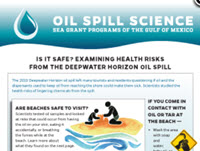
The Sea Grant Oil Spill Outreach Team released a publication that addresses the public’s questions about health safety after the Deepwater Horizon incident.
The fact sheet, Is it Safe? Examining Health Risks from the Deepwater Horizon Oil Spill succinctly explains findings from peer-reviewed studies and reports from state and federal agencies that investigated the safety of the beach, water, and seafood since the spill.
More in-depth information is available in the following Sea Grant publications:
- Top five frequently asked questions about the Deepwater Horizon oil spill
- Navigating shifting sands: Oil on our beaches
- The Deepwater Horizon oil spill’s impact on Gulf seafood
The Sea Grant Oil Spill Outreach Team synthesizes peer-reviewed science for a broad range of general audiences, particularly those who live and work across the Gulf Coast. Sea Grant offers oil-spill-related public seminars across the Gulf Coast.
Information about upcoming Sea Grant science seminars and recently-held events is available here. To receive email updates about seminars, publications, and the outreach team, click here.
************
GoMRI and the Sea Grant programs of the Gulf of Mexico (Florida, Mississippi-Alabama, Louisiana, and Texas) have partnered to create an oil spill science outreach program.
The Gulf of Mexico Research Initiative (GoMRI) is a 10-year independent research program established to study the effect, and the potential associated impact, of hydrocarbon releases on the environment and public health, as well as to develop improved spill mitigation, oil detection, characterization and remediation technologies. An independent and academic 20-member Research Board makes the funding and research direction decisions to ensure the intellectual quality, effectiveness and academic independence of the GoMRI research. All research data, findings and publications will be made publicly available. The program was established through a $500 million financial commitment from BP. For more information, visit https://gulfresearchinitiative.org/.
© Copyright 2010-2017 Gulf of Mexico Research Initiative (GoMRI) – All Rights Reserved. Redistribution is encouraged with acknowledgement to the Gulf of Mexico Research Initiative (GoMRI). Please credit images and/or videos as done in each article. Questions? Contact web-content editor Nilde “Maggie” Dannreuther, Northern Gulf Institute, Mississippi State University (maggied@ngi.msstate.edu).
Get to Know CRGC Grad Student Patel
 Megha Patel is a social work Ph.D. student at Tulane University and a member of the Consortium for Resilient Gulf Communities (CRGC)’s Community Action Planning and Resilience Building efforts.
Megha Patel is a social work Ph.D. student at Tulane University and a member of the Consortium for Resilient Gulf Communities (CRGC)’s Community Action Planning and Resilience Building efforts.
Learn more about her background and research interests here.
Get to Know CWC Researcher Giulio Mariotti
 Mariotti is a geobiologist developing a model to predict the rate at which marshes retreat due to waves and pond formation. His research with the Coastal Waters Consortium (CWC) will help predict future marsh loss and identify strategies to reduce it.
Mariotti is a geobiologist developing a model to predict the rate at which marshes retreat due to waves and pond formation. His research with the Coastal Waters Consortium (CWC) will help predict future marsh loss and identify strategies to reduce it.
Video: The Motion of the Ocean
 This video highlights the tools and techniques that modern researchers use to study ocean currents and develop more accurate ocean circulation models.
This video highlights the tools and techniques that modern researchers use to study ocean currents and develop more accurate ocean circulation models.
Fact Sheet: ACER Tool Talk Series Features Stable Isotope Analysis
 Scientists can use stable isotope analysis to determine stable isotope ratios in an organism’s tissues to reconstruct food webs in oiled and non-oiled coastal environments. Specifically, they collect blood and muscle tissue samples from mid-level and higher order consumers, like sharks, to find out if there was any effect of the oil on the consumer population. As carbon isotope ratios can indicate if the shark was feeding in coastal waters verses offshore waters, one of the questions this analysis may help answer is if these consumers were able to avoid the oiled waters.
Scientists can use stable isotope analysis to determine stable isotope ratios in an organism’s tissues to reconstruct food webs in oiled and non-oiled coastal environments. Specifically, they collect blood and muscle tissue samples from mid-level and higher order consumers, like sharks, to find out if there was any effect of the oil on the consumer population. As carbon isotope ratios can indicate if the shark was feeding in coastal waters verses offshore waters, one of the questions this analysis may help answer is if these consumers were able to avoid the oiled waters.
Fact Sheet: CRGC Two-Pager Details Transdisciplinary Student Outreach
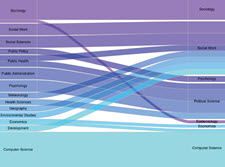 Experts at the Consortium for Resilient Gulf Communities (CRGC) come from from diverse fields. Working directly with experts outside their own fields of study enhances students’ insights about disaster, recovery, and resilience, while improving their problem solving skills and passion for their work.
Experts at the Consortium for Resilient Gulf Communities (CRGC) come from from diverse fields. Working directly with experts outside their own fields of study enhances students’ insights about disaster, recovery, and resilience, while improving their problem solving skills and passion for their work.
The two-page pamphlet describes the consortium’s efforts to provide graduate and undergraduate students with hands-on opportunities to work with transdisciplinary research methods and best practices for addressing community disasters.
Fact Sheet: GoMRI Science Featured by Science Journal for Kids
 Recent research into Deepwater Horizon’s impacts on salt marsh fiddler crabs has been adapted for the journal’s Environmental Science Journal for Teens publication. The research team included researchers from two Louisiana State University-led projects (1, 2) and the Florida Institute of Oceanography.
Recent research into Deepwater Horizon’s impacts on salt marsh fiddler crabs has been adapted for the journal’s Environmental Science Journal for Teens publication. The research team included researchers from two Louisiana State University-led projects (1, 2) and the Florida Institute of Oceanography.
Video: LADC-GEMM Drone Footage of Research Cruise
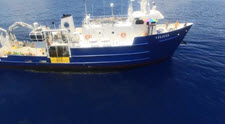 A recent visual and acoustic survey of the northern Gulf of Mexico assessed changes in marine mammal distribution and ambient noise levels following the Deepwater Horizon oil spill. The short clip follows the R/V Pelican as it surveys the area.
A recent visual and acoustic survey of the northern Gulf of Mexico assessed changes in marine mammal distribution and ambient noise levels following the Deepwater Horizon oil spill. The short clip follows the R/V Pelican as it surveys the area.
ECOGIG Hosts Second Annual Ocean Discovery Camp
 Campers aged 11-14 explored ocean topics such as deep oceans, ecosystems, and chemosynthetic processes through hands-on projects, games, videos, and slideshows. The students also designed and built their own remotely operated vehicles (ROVs) and created stop-motion videos based on the camp’s themes.
Campers aged 11-14 explored ocean topics such as deep oceans, ecosystems, and chemosynthetic processes through hands-on projects, games, videos, and slideshows. The students also designed and built their own remotely operated vehicles (ROVs) and created stop-motion videos based on the camp’s themes.
LADC-GEMM Undergraduate Student Reflects on Summer Cruise Experience
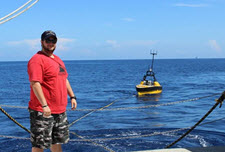 Matt Firneno recently completed Bachelor’s degrees in physics and mathematics at the University of New Orleans. He participated in LADC-GEMM’s recent research cruise aboard R/V Pelican, where he assisted learned about different forms of data acquisition and real-time data analysis. Learn more about his research and experiences here.
Matt Firneno recently completed Bachelor’s degrees in physics and mathematics at the University of New Orleans. He participated in LADC-GEMM’s recent research cruise aboard R/V Pelican, where he assisted learned about different forms of data acquisition and real-time data analysis. Learn more about his research and experiences here.
CWC Blog Series Features Undergraduate Interns
 Since 2011, LUMCON has been host to groups of undergraduate students taking part in the Research Experience for Undergraduates (REU) Program. The REU Program helps student interns interested in scientific careers gain experience conducting research in the field. CWC will profile these students and their research through a series of blog and social media posts.
Since 2011, LUMCON has been host to groups of undergraduate students taking part in the Research Experience for Undergraduates (REU) Program. The REU Program helps student interns interested in scientific careers gain experience conducting research in the field. CWC will profile these students and their research through a series of blog and social media posts.
Keep up with the blog series here.
For more information about the REU program, check out the REU Internships page on the LUMCON website.
LADC-GEMM Blog Post Introduces “Will” the Seaglider
 “Will” is an underwater autonomous vehicle that will survey and collect acoustic Gulf of Mexico data for approximately eight weeks. Every four hours, the glider surfaces, relays information back to a base station at Oregon State University, and descends again to collect more information.
“Will” is an underwater autonomous vehicle that will survey and collect acoustic Gulf of Mexico data for approximately eight weeks. Every four hours, the glider surfaces, relays information back to a base station at Oregon State University, and descends again to collect more information.
Will is surveying and collecting acoustic data in the Gulf until July 22, 2017, when he will be recovered by a small boat by OSU graduate student Samara Haver and Sean Griffin of Proteus Technologies.
Video: Tour of the R/V Pelican
 The clip invites viewers to tour the research vessel alongside Board of Regents members and learn about the research that scientists conduct during cruises.
The clip invites viewers to tour the research vessel alongside Board of Regents members and learn about the research that scientists conduct during cruises.
Resource: CRGC Releases Database of Oil Spill Claim Sources
 Since the 2010 Deepwater Horizon (DWH) oil spill, there has been extensive data collection across the Gulf of Mexico region to better understand the economic impacts of the disaster, particularly on the fishing, seafood, and tourism industries in Gulf Coastal communities that were affected by the spill. There has also been a need to locate claims related to the oil spill— either made or paid out.
Since the 2010 Deepwater Horizon (DWH) oil spill, there has been extensive data collection across the Gulf of Mexico region to better understand the economic impacts of the disaster, particularly on the fishing, seafood, and tourism industries in Gulf Coastal communities that were affected by the spill. There has also been a need to locate claims related to the oil spill— either made or paid out.
The new resource uses a variety of potential sources, such as the U.S. Census Bureau, to help businesses, researchers, community members, and other stakeholders locate information about fisheries, tourism, and oil spill claims. The database is intended to introduce users to information sources that may be less widely known than standard economic activity databases.
Database of Potential Sources on Fisheries, Tourism, and Oil Spill Claims
Get to Know CRGC Grad Student Betsy Lopez
 Betsy is a masters student at Tulane University’s Disaster Resilience Leadership Academy. She is also the program coordinator of Internships and Experiential Learning at the Newcomb College Institute, where she manages grants and endowments and oversees experiential learning opportunities, the alumnae-mentoring program, and the Kenya summer abroad program.
Betsy is a masters student at Tulane University’s Disaster Resilience Leadership Academy. She is also the program coordinator of Internships and Experiential Learning at the Newcomb College Institute, where she manages grants and endowments and oversees experiential learning opportunities, the alumnae-mentoring program, and the Kenya summer abroad program.
CONCORDE Hosts Third Fisherman-Scientist Bridge Building Workshop
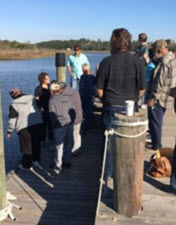 Approximately 15 local fishermen and their families attended the workshop to meet the scientists and voice their concern about topics such as sediment and marine snow. The fishermen also learned how to use the YSI ProDSSII conductivity/temperature-depth meter (CTD) to collect depth salinity and temperature profiles. They will continue collecting and returning data through the end of the project.
Approximately 15 local fishermen and their families attended the workshop to meet the scientists and voice their concern about topics such as sediment and marine snow. The fishermen also learned how to use the YSI ProDSSII conductivity/temperature-depth meter (CTD) to collect depth salinity and temperature profiles. They will continue collecting and returning data through the end of the project.
Read more about the workshop and CONCORDE’s collaboration with fishermen here.
DEEPEND Logs DP05 Cruise Through Kids Blog
 Following a short weather delay, the consortium kicked off its fifth research cruise, a two-week survey of Gulf of Mexico. The DEEPEND team has been posting updates on their progress to the project’s Kids Blog almost daily.
Following a short weather delay, the consortium kicked off its fifth research cruise, a two-week survey of Gulf of Mexico. The DEEPEND team has been posting updates on their progress to the project’s Kids Blog almost daily.
Visit the blog to catch up on the latest news.
App: RECOVER Virtual Lab (iPad + Web)
 In the wake of Deepwater Horizon, scientists have been working diligently to understand the impacts of the oil spill on the Gulf of Mexico along with the wildlife and people that depend on it.
In the wake of Deepwater Horizon, scientists have been working diligently to understand the impacts of the oil spill on the Gulf of Mexico along with the wildlife and people that depend on it.
The Relationships of Effects of Cardiac Outcomes in fish for Validation of Ecological Risk (RECOVER) consortium’s focus has been on the impacts of fish, specifically the economically and ecologically important mahi-mahi and red drum. Most of their research and experiments take place behind closed doors in laboratories with extremely controlled settings. As a result, it is not always feasible for the general public to see what happens day-to-day. RECOVER is extremely excited to bring you our solution – the RECOVER Virtual Lab. A novel approach to bring marine science into any classroom, foster STEM learning, and improve student performance in science classes.
The app allows students to analyze real data collected by consortium scientists and observe how oil-exposed mahi and redfish swim compared to unexposed control fish. Lesson plans for teachers and quizzes testing student’s performance are built-in to the app’s interface, and more experiments are in development.
The app currently contains two lessons:
- Vision Test: Students analyze data collected by researcher Jason Magnunson to see how crude oil impacts the vision of mahi-mahi, red drum, and sheepshead minnow.
- Swim Tunnel: Students use a “fish treadmill” to observe how oil impacts the swimming speeds and ability of mahi mahi.
Download the iPad app from the Apple App Store or visit http://recovervirtuallab.com/ to get started!
Video: CONCORDE Releases Time-Lapse Drifter Video
 Dr. Brian Dzwonkowski released drifters at the mouth of Mobile Bay. Graduate student Jeff Coogan animated the drifters’ path, which captured a low-wind, high-discharge event.
Dr. Brian Dzwonkowski released drifters at the mouth of Mobile Bay. Graduate student Jeff Coogan animated the drifters’ path, which captured a low-wind, high-discharge event.
You can watch the video here.
Oceanography Highlights Findings from Deepwater Horizon Research

Cover of the September 2016 Oceanography Magazine, Volume 29, Number 3
7th year of the largest coordinated research endeavor around an ocean event.
The 2010 Deepwater Horizon oil spill and subsequent response efforts raised concerns about impacts on the Gulf of Mexico’s ocean and coastal environments. The Gulf of Mexico Research Initiative (GoMRI), in response to the spill, initiated an unprecedented 10-year scientific research program funded by BP. Seven years into the program, we know more than ever before about the Gulf’s complex environment, dynamic processes, and response to stressors.
Oceanography magazine dedicated a special issue to this research, GoMRI: Deepwater Horizon Oil Spill and Ecosystem Science, and below are highlights from 13 papers it featured.*
WHERE OIL WENT
Surface oil covered a cumulative area of 149,000 km2 in the northeastern Gulf. Wind and currents transported surface slicks towards land, affecting approximately 1,800-2,100 km of shoreline, a third of which were moderately to heavily oiled including 1,075 km in Louisiana. Macondo oil was visually evident at the edge of Louisiana marshes and up to 10 m inland.
Subsea oil and gas rose through the water column and formed an underwater oil plume that covered an area of approximately 930 km2 and made direct contact with continental slope sediments. A significant proportion of surface oil returned to the deep seafloor primarily through an extensive marine oil snow sedimentation event known as a “dirty blizzard,” forming a 0.5-1.2 cm thick floc layer.
Cleanup efforts removed oil from 73% of beaches affected by the spill, but residual oil remained as surface residue balls (SRBs), submerged oil mats, and in marsh plants and sediment, and is subject to continued weathering, biodegradation, and possible resuspension.
HOW OIL CHANGED
Crude oils contain thousands of compounds that, upon entering a marine environment, undergo significant compositional changes from weathering processes such as evaporation, dissolution, emulsification, dispersion, sedimentation/flocculation, microbial degradation, and photooxidation.
Most crude oil compounds are readily biodegradable and generally follow a clear degradation pattern: n-alkanes first followed by branched alkanes, lower molecular weight aromatics, higher molecular weight aromatics, and cyclic alkanes. Anaerobic biodegradation is a slower process than aerobic degradation, and crude oil compounds can remain relatively unaltered in reduced sediments and environments for long time periods and may appear as relatively fresh oil compared to surface oil exposed to aerobic conditions.
MICROBIAL RESPONSE AFFECTING OIL FATE
Macondo oil had a relatively low content of persistent resins and asphaltenes, and warm temperatures supported geochemical and biological degradation. The prevalence of oil-degrading bacteria generated a prompt response from the microbial community and subsequent biodegradation. Microbial communities in the plume were different from those in non-plume waters and exhibited a significant enrichment of hydrocarbon-degrading metabolic genes. Aerobic oxidation of short chain alkanes, propane, and butane caused up to 70% of oxygen depletion observed in the oil plume.
Residual oil trapped in Pensacola Beach sands showed a progression of microbial populations linked to hydrocarbon degradation. Early-responder microbes were followed by populations capable of aromatic hydrocarbon decomposition. Microbial abundance in oiled sands was 10-10,000 times that in clean sands in the first four months after oil came ashore. A typical beach-environment microbial community returned after one year but differed significantly from pre-spill communities.
DEEP OCEAN IMPACTS
Carbon from the spill was likely incorporated into the mesopelagic (200-1,000 m depth) food web through consumption of prey rich in depleted carbon. The nature of microbial communities in the deep sea likely changed. An 80-93% decline in benthic foraminifera was related to reducing conditions and increased polycyclic aromatic hydrocarbons (PAH) concentrations.
Deepsea megafauna had lower diversity and abundance near the spill site relative to regions farther away, though blue marlin, Atlantic sailfish, blackfin tuna, and dolphinfish showed no significant reduction in larval abundance. Bottom-dwelling golden tilefish had the highest concentrations of naphthalene metabolite levels in bile measured in fishes globally. Tunas and jacks collected near the spill site exhibited developmental crude oil cardiotoxicity, suggesting a possible loss of early predator recruits that spawn in open waters. Sperm whale acoustic activity decreased near the spill site by a factor of two and increased farther away, suggesting they relocated.
Hard-bottom communities, including natural and artificial reefs, suffered injuries that were severe and long-lasting. Macrofauna and meiofauna diversity had not recovered after four years, and community structure differences still persist. Deep-sea colonial corals, in particular octocorals near the spill site, showed visible evidence of impact, and flocculent material covering the coral contained chemical fingerprints associated with Macondo oil and DOSS (dioctyl sodium sulfosuccinate). Researchers returned to these coral eight times and observed continued impacts such as tissue death with some coral skeletons secondarily colonized by hydrozoans.
Field measurements showed that planktonic community abundance and species composition returned to pre-spill conditions within a year. Laboratory experiments indicated that zooplankton exposed to sublethal crude oil levels bioaccumulated five PAHs, which could increase their susceptibility to predation and enhance trophic transfer of toxic PAHs.
MARSH IMPACTS
There were immediate negative impacts in moderately to heavily oiled marshes in southeastern Louisiana. The average concentration of total alkanes and PAHs in June 2013 was 20 and 374 times pre-oiled conditions, respectively. Total alkane concentrations were on a trajectory to be near baseline levels by 2015, but this did not occur likely a result of multiple resuspension events from storms.
Some damaged marsh shorelines showed precipitous shoreline erosion at least 2.5 years after oiling due to damaged root systems. Marshes lost due to oiling and shoreline erosion will not return without human intervention. Forty-two months after the spill, heavily oiled marshes showed near-complete plant mortality, and live aboveground biomass was 50% of reference marshes. Decreased living marsh vegetation and population levels of some fauna were obvious for 2-5 years. Meiofauna density was lower along with S. alterniflora grasses in heavily oiled areas.
Fiddler crab average size declined and there were proportion shifts in two species composition. Periwinkle snails density declined, and a slow recovery in abundance and size distribution was related to habitat recovery. Worms, seed shrimp, and mud dragons had not recovered to background levels 48 months post-spill. Killifish showed little evidence of spill impacts. Horse fly abundance declined sharply. Arthropods were suppressed by 50% in 2010 but had largely recovered in 2011. Seaside Sparrow nests on unoiled sites were more likely to fledge than those on oiled sites. Loons varied in frequency with PAHs by year and exhibited reduced body mass as PAH concentrations increased.
These effects are expected to continue – possibly for decades – to some degree, or the marsh ecosystem will reach a new baseline condition in heavily damaged areas.
FISH & SEAFOOD IMPACTS
Commercial, recreational, and subsistence fisheries were closed in fall 2010 in areas where oil was observed and predicted to travel and reopened by April 2011. Impacts on fisheries productivity were relatively short-lived, with landings and their values returning to pre-spill levels or greater for most fishery species. However, long-term effects are yet to be determined. Laboratory studies indicate that early life stages of fish are generally more sensitive to oil and dispersant’s sublethal effects (with some resulting in reduced swimming performance and cardiac function) than adults.
Public health risks from exposure to crude oil residue through seafood or coastal beaches returned to pre-spill levels after the spill dissipated. Seafood from reopened areas was found to be safe for consumption, with PAH levels comparable to those found in common local processed foods. PAH concentrations detected in many seafood samples during and following the spill were at least 2 orders of magnitude below levels of public health concern. DOSS was detected in less than 1% of samples and at levels below public health concern.
Tests on SRBs showed that Vibrio vulnificus were 10 times higher than the surrounding sand and up to 100 times higher than seawater, suggesting that SRBs can act as reservoirs for bacteria including human pathogens. Coquina clams initially showed higher PAH levels relative to the surrounding sand, but levels decreased continuously and were undetectable in sand (one year) and Coquina tissues (two years).
DISPERSANT EFFECTS & FUTURE TECHNOLOGIES
Dispersant increased the oil fraction that spread within the water column and laterally displaced oil that reached the sea surface. Dispersants reduced droplet sizes and rise velocities, resulting in a more than tenfold increase in the downstream length of the surface oil footprint.
Chemical dispersants may be more toxic to some marine organisms than previously thought, and small oil droplets created by dispersant use and directly consumed by marine organisms are often more toxic than crude oil alone. Dispersant effects on microorganisms might be taxa-specific, and some studies suggest that dispersants stimulated biodegradation while others conclude the opposite. Degradation rates of hexadecane and naphthalene were more rapid in the absence of dispersants, as was the overall removal of the water-accommodated oil fraction.
Dispersant applied at the broken riser pipe helped form a deep water oil plume. DOSS was likely transferred to the plume and was later detected in surface sediments, on corals, and within oil-sand patties.
A future option is development of plant-based materials for efficient chemical herding of compact oil slicks into layers that are sufficiently thick to enable oil burning or skimming. Opportunities exist for new dispersants that work in synergy with current dispersants and mitigate some of their disadvantages. Examples include a system containing soybean lecithin and the surfactant Tween 80, substitution of lecithin for DOSS, and using carbon-based particles and silicas to stabilize emulsified droplets. Laboratory research needs to be conducted at concentrations and under conditions relevant to marine environments.
MODELING CAPABILITIES
Model improvements provide a better understanding of droplet formation in the turbulent plume above the wellhead. No model during the spill could predict droplet size distribution, which dictates rise times, dissolution, and biodegradation. Oil spill models now include the ability to simulate the rise of a buoyant oil plume from the seabed to the surface. Consideration of oil’s 3D movement permits the prediction of oil spreading through subsurface plumes. Our understanding of the near-surface oceanic layer and atmospheric boundary layer, including the influences of waves and wind, has also improved.
Oil spill modeling routines will likely be included in Earth system models, linking physical models with marine sediment and biogeochemical components. Advances in coupled nearfield-farfield dynamic modeling together with real-time, seven-day circulation forecasts allow for near-real-time tracking and forecasting of oil dynamics. This is the most promising approach for rapid evaluation of blowout predictions to support first response decisions.
* Overton, E.B., T.L. Wade, J.R. Radović, B.M. Meyer, M.S. Miles, and S.R. Larter. 2016. Chemical composition of Macondo and other crude oils and compositional alterations during oil spills. Oceanography 29(3):50–63
Socolofsky, S.A., E.E. Adams, C.B. Paris, and D. Yang. 2016. How do oil, gas, and water interact near a subsea blowout? Oceanography 29(3):64–75
Passow, U., and R.D. Hetland. 2016. What happened to all of the oil? Oceanography 29(3):88–95
Özgökmen, T.M., E.P. Chassignet, C.N. Dawson, D. Dukhovskoy, G. Jacobs, J. Ledwell, O. Garcia-Pineda, I.R. MacDonald, S.L. Morey, M.J. Olascoaga, A.C. Poje, M. Reed, and J. Skancke. 2016. Over what area did the oil and gas spread during the 2010 Deepwater Horizon oil spill? Oceanography 29(3):96–107
John, V., C. Arnosti, J. Field, E. Kujawinski, and A. McCormick. 2016. The role of dispersants in oil spill remediation: Fundamental concepts, rationale for use, fate, and transport issues. Oceanography 29(3):108–117
Passow, U., and K. Ziervogel. 2016. Marine snow sedimented oil released during the Deepwater Horizon spill. Oceanography 29(3):118–125
Tarr, M.A., P. Zito, E.B. Overton, G.M. Olson, P.L. Adhikari, and C.M. Reddy. 2016. Weathering of oil spilled in the marine environment. Oceanography 29(3):126–135
Joye, S.B., S. Kleindienst, J.A. Gilbert, K.M. Handley, P. Weisenhorn, W.A. Overholt, and J.E. Kostka. 2016. Responses of microbial communities to hydrocarbon exposures. Oceanography 29(3):136–149
Rabalais, N.N., and R.E. Turner. 2016. Effects of the Deepwater Horizon oil spill on coastal marshes and associated organisms. Oceanography 29(3):150–159
Murawski, S.A., J.W. Fleeger, W.F. Patterson III, C. Hu, K. Daly, I. Romero, and G.A. Toro-Farmer. 2016. How did the Deepwater Horizon oil spill affect coastal and continental shelf ecosystems of the Gulf of Mexico? Oceanography 29(3):160–173
Buskey, E.J., H.K. White, and A.J. Esbaugh. 2016. Impact of oil spills on marine life in the Gulf of Mexico: Effects on plankton, nekton, and deep-sea benthos. Oceanography 29(3):174–181
Fisher, C.R., P.A. Montagna, and T.T. Sutton. 2016. How did the Deepwater Horizon oil spill impact deep-sea ecosystems? Oceanography 29(3):182–195
Dickey, R., and M. Huettel. 2016. Seafood and beach safety in the aftermath of the Deepwater Horizon oil spill. Oceanography 29(3):196–203
************
The Gulf of Mexico Research Initiative (GoMRI) is a 10-year independent research program established to study the effect, and the potential associated impact, of hydrocarbon releases on the environment and public health, as well as to develop improved spill mitigation, oil detection, characterization and remediation technologies. An independent and academic 20-member Research Board makes the funding and research direction decisions to ensure the intellectual quality, effectiveness and academic independence of the GoMRI research. All research data, findings and publications will be made publicly available. The program was established through a $500 million financial commitment from BP. For more information, visit http://gulfresearchinitiative.org/.
© Copyright 2010- 2017 Gulf of Mexico Research Initiative (GoMRI) – All Rights Reserved. Redistribution is encouraged with acknowledgement to the Gulf of Mexico Research Initiative (GoMRI). Please credit images and/or videos as done in each article. Questions? Contact web-content editor Nilde “Maggie” Dannreuther, Northern Gulf Institute, Mississippi State University (maggied@ngi.msstate.edu).
SeaGlide Workshop Engages Teachers and Students in Ocean Research Technology
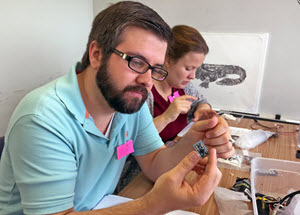
Christopher Hatten of Mildred Osborne Charter School contemplates the Arduino microcontroller board that he will later program to run his SeaGlide model. (Photo by Dinah Maygarden)
Researchers from Oregon State University, the University of New Orleans, and Proteus Technologies explained how they use ocean gliders to collect temperature, pressure, and acoustic data such as sounds made by Gulf of Mexico whales and dolphins. The Littoral Acoustic Demonstration Center – Gulf Ecological Monitoring and Modeling (LADC-GEMM) team guided the participants in constructing their own SeaGlide models assisted by eight Warren Easton Charter High School students with experience building the model gliders.
SeaGlide models are fully functioning miniature gliders that, like “real” gliders, collect data and take in and expel water to change their buoyancy and propel themselves forward. The kits are designed to guide users through the building process while teaching them the foundations behind the technology. The participants learned about basic electronics so they could solder and program the gliders’ circuit boards and built servo-driven engines that manage the gliders’ buoyancy and pitch.
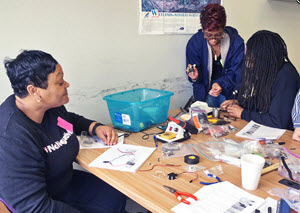
Julian DeRouen (far right), an advanced physics student from Warren Easton Charter High School, shows Fifth Ward Elementary’s Rhodie Simms and West St. John Elementary’s Angela Farnell how to assemble the electronics for their glider models. (Photo by Sara Heimlich)
Workshop participants consisted of 5th – 12th grade educators working in local schools and after-school programs. Most participants said that they thought the hands-on building experience was the most valuable part of the workshop and expressed an intention to incorporate what they learned into their school-year, after-school, or summer curriculums. Some expressed an interest in teaching the material for as long as three or four weeks, while others considered incorporating the gliders as a weekly activity throughout the entire school year. The majority of participants reported that the workshop made them feel more confident in their ability to teach overall science, technology, engineering, and math (STEM) principles.
***********
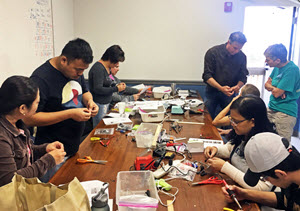
Proteus Technologies’ Sean Griffin guides participants through the delicate process of soldering electronic parts onto the programmable computer chips that control the model gliders’ movements. (Photo by Kendal Leftwich)
This research was made possible in part by a grant from the Gulf of Mexico Research Initiative (GoMRI) to the Littoral Acoustic Demonstration Center – Gulf Ecological Monitoring and Modeling (LADC-GEMM) consortium.
The Gulf of Mexico Research Initiative (GoMRI) is a 10-year independent research program established to study the effect, and the potential associated impact, of hydrocarbon releases on the environment and public health, as well as to develop improved spill mitigation, oil detection, characterization and remediation technologies. An independent and academic 20-member Research Board makes the funding and research direction decisions to ensure the intellectual quality, effectiveness and academic independence of the GoMRI research. All research data, findings and publications will be made publicly available. The program was established through a $500 million financial commitment from BP. For more information, visit http://gulfresearchinitiative.org/.
© Copyright 2010- 2017 Gulf of Mexico Research Initiative (GoMRI) – All Rights Reserved. Redistribution is encouraged with acknowledgement to the Gulf of Mexico Research Initiative (GoMRI). Please credit images and/or videos as done in each article. Questions? Contact web-content editor Nilde “Maggie” Dannreuther, Northern Gulf Institute, Mississippi State University (maggied@ngi.msstate.edu).
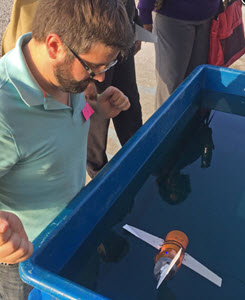
Hatten tests his finished model in a water tank. (Photo by Dinah Maygarden)
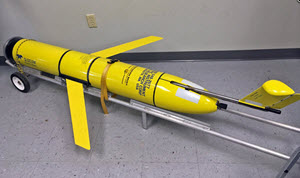
The workshop used this glider, provided by Stephan Howden of the University of Southern Mississippi, to demonstrate the type of gliders used in LADC-GEMM research. (Photo by Sara Heimlich)
Fact Sheet: Sea Grant Releases Brochure on Oil Spill Cleanup Technology Developments
 The Sea Grant Oil Spill Outreach Team released a new informational brochure that explores products currently available or in development to remove oil from water in future spills.
The Sea Grant Oil Spill Outreach Team released a new informational brochure that explores products currently available or in development to remove oil from water in future spills.
The brochure Emerging Surfactants, Sorbents, and Additives for Use in Oil Spill Clean-Up addresses surfactants inspired by microbes, finding treasure in unexpected places (everyday materials), and tiny materials with big impact (nanotechnology). These developments show promise; however, much testing, both in the lab and the field, and regulatory steps lay ahead before these products may be used during an oil spill.
The Sea Grant Oil Spill Outreach Team synthesizes peer-reviewed science for a broad range of general audiences, particularly those who live and work across the Gulf Coast. Sea Grant offers oil-spill-related public seminars across the Gulf Coast. Click here to view upcoming science seminars and read about recently-held events. To receive email updates about seminars, publications, and the outreach team, click here.
************
GoMRI and the Sea Grant programs of the Gulf of Mexico (Florida, Mississippi-Alabama, Louisiana, and Texas) have partnered to create an oil spill science outreach program.
The Gulf of Mexico Research Initiative (GoMRI) is a 10-year independent research program established to study the effect, and the potential associated impact, of hydrocarbon releases on the environment and public health, as well as to develop improved spill mitigation, oil detection, characterization and remediation technologies. An independent and academic 20-member Research Board makes the funding and research direction decisions to ensure the intellectual quality, effectiveness and academic independence of the GoMRI research. All research data, findings and publications will be made publicly available. The program was established through a $500 million financial commitment from BP. For more information, visit http://gulfresearchinitiative.org/.
© Copyright 2010- 2017 Gulf of Mexico Research Initiative (GoMRI) – All Rights Reserved. Redistribution is encouraged with acknowledgement to the Gulf of Mexico Research Initiative (GoMRI). Please credit images and/or videos as done in each article. Questions? Contact web-content editor Nilde “Maggie” Dannreuther, Northern Gulf Institute, Mississippi State University (maggied@ngi.msstate.edu).
App: Virtual Lab Creates More “Wow” Moments in Science Discovery
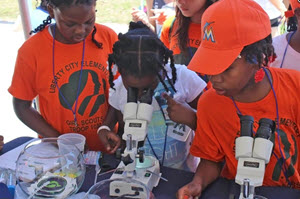
Miami Girl Scouts look at mahi-mahi embryos at an Ocean Kids outreach event. University of Miami students with the RECOVER consortium set up hands-on learning stations about the ocean. (Photo by RECOVER)
A child’s face lit up with wonder as she peered into a microscope for the first time and discovered a new world. Researchers at the Miami-based RECOVER consortium want experiences like this to happen more often for more students, so they designed and developed the RECOVER Virtual Lab. Now, scientists can engage students ages 8 and older anywhere anytime with an innovative lab experience that is accessible online and soon through the Apple App Store.
RECOVER Outreach lead Daniel DiNicola explained how the virtual lab came about, “In the consortium’s beginning, Martin Grosell [RECOVER Director] and I wanted to increase the public’s awareness and use of RECOVER’s visually-engaging experiments. We wanted something interactive that schools or public venues like museums could use.” The virtual lab is a consortium legacy product that will teach oil spill science for years to come and increases their classroom reach around the world.
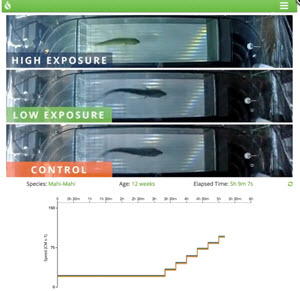
Visitors to the Virtual Lab see an experiment showing how the swimming performance of Mahi mahi are affected by different levels of oil exposure. The chart below the fish tracks performance. (Photo provided by RECOVER)
The lab’s development began in earnest using the same team that built the RECOVER website. “We liked that they already understood the research and that they work close by at the University of Miami’s main campus,” explained DiNicola. Development took about eight months and included storyboarding, wire framing, script development, filming, post production, data visualization, app design, and coding.
Internal beta testing for the virtual lab gave the RECOVER team feedback that improved science accuracy. “It was extremely beneficial to work alongside the scientists whose work is featured in the app,” said DiNicola. “The scientists offered insight and guidance that helped us refine the product and identify bugs.”
The pilot lesson, Fish Treadmills, is geared toward middle school, high school, and college students. Future lessons will include an experiment on visual acuity, fish embryonic and larval development, and social interactions. “All our lessons will feature one RECOVER graduate student acting as the virtual lab partner and explaining their research,” explained DiNicola. “We believe this is a great way for our students to practice valuable science communication skills as well as show their enthusiasm for their work.”
An evaluation component is built into the app to help determine and quantify the virtual lab’s success. Grade-specific quizzes available after every lesson will give the RECOVER team valuable insights into the lesson’s effectiveness. The demographic and location data collected by the quizzes will help identify use and participation trends. The RECOVER team hopes to publish their findings on the tool’s effectiveness using the evaluation data.
Grade-specific workbooks and transcripts for educators and students are available for download. Future plans for the virtual lab include more lessons for younger elementary students. For more information, visit the RECOVER website.
************
This research was made possible in part by a grant from the Gulf of Mexico Research Initiative (GoMRI) to the Relationship of Effects of Cardiac Outcomes in Fish for Validation of Ecological Risk (RECOVER) consortium.
The Gulf of Mexico Research Initiative (GoMRI) is a 10-year independent research program established to study the effect, and the potential associated impact, of hydrocarbon releases on the environment and public health, as well as to develop improved spill mitigation, oil detection, characterization and remediation technologies. An independent and academic 20-member Research Board makes the funding and research direction decisions to ensure the intellectual quality, effectiveness and academic independence of the GoMRI research. All research data, findings and publications will be made publicly available. The program was established through a $500 million financial commitment from BP. For more information, visit http://gulfresearchinitiative.org/.
© Copyright 2010- 2017 Gulf of Mexico Research Initiative (GoMRI) – All Rights Reserved. Redistribution is encouraged with acknowledgement to the Gulf of Mexico Research Initiative (GoMRI). Please credit images and/or videos as done in each article. Questions? Contact web-content editor Nilde “Maggie” Dannreuther, Northern Gulf Institute, Mississippi State University (maggied@ngi.msstate.edu).
Grad Student Girard Uses High-Definition Imagery to Assess Post-Spill Coral Recovery
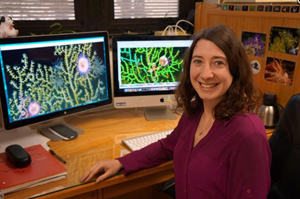
Fanny digitizes a high-definition image of an impacted coral colony to quantify impacts, growth, and recovery. (Photo by Cherisse DuPreez)
Deep-sea corals are important organisms that support a healthy and diverse deep-sea ecosystem. However, there is much we do not know about certain coral species, including how they grow, reproduce, or interact with other organisms. Fanny Girard’s research helps bridge that knowledge gap through her work on how disturbances such as oil spills affect deep-sea coral colonies and if those effects have lasting impacts. She hopes that her research will underline the need to protect these important deep-sea ecosystems.
Fanny is a Ph.D. student in Pennsylvania State University’s biology program and a GoMRI Scholar with the Ecosystem Impacts of Oil and Gas Inputs to the Gulf (ECOGIG) consortium.
Her Path
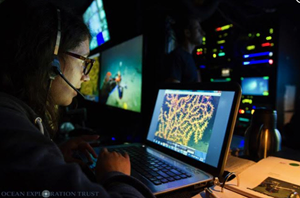
Fanny takes photos of corals in the ROV control van onboard the E/V Nautilus. (Photo credit: Ocean Exploration Trust)
Fanny grew up on the Mediterranean coast of southern France and developed a special affinity for the ocean. Her desire to work on ocean related issues started when she was eleven years old, scuba diving with her mother. While pursuing a biology bachelor’s degree at Pierre and Marie Curie University, Fanny explored marine mammal ecology during internships studying whale populations in Canada’s Gulf of St. Lawrence. Her graduate marine ecology studies at the University of Western Brittany included a course on the deep sea that inspired her to change direction. “Even though the deep sea is the largest ecosystem on earth, there is still so much to discover. That fact made me want to get involved in deep-sea research,” she said.
Fanny participated in various deep-sea research projects during her master’s work, including projects at the Institut Français de Recherche pour l’Exploitation de la Mer (IFREMER) in France and Dalhousie University in Halifax, Nova Scotia. Her master’s advisor introduced her to Pennsylvania State University’s Dr. Chuck Fisher, who offered her a Ph.D. position researching deep-sea corals for the ECOGIG project. “I had read about some of [Dr. Fisher’s work] in the Gulf of Mexico and was very excited about joining his lab,” said Fanny. “A lot of research still needs to be done to protect corals, and I really wanted to be part of this effort.”
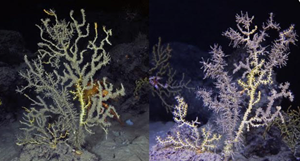
An impacted coral imaged in 2011 (left) and 2016 (right). Part of this coral has visibly recovered, but most of the colony was still heavily impacted six years post-spill. (Image by Fanny Girard)
Her Work
Natural mortality is a rare event among deep-sea octocorals, also known as sea fans, whichhave the potential to act as sentinels for anthropogenic impacts. Fanny uses high-definition imagery to assess the Deepwater Horizon oil spill’s long-term impacts on octocorals.
Since 2010, her group’s lab has been monitoring hundreds of coral colonies at oil exposed and control sites. The team collects high-definition images of the same corals every year using ROV-mounted camera equipment. Fanny digitizes the images and identifies visible impacts to coral branches, including excess mucus, bare skeletons, and secondary colonization by hydroids. She compares the annual images to assess recovery over time and identifies factors potentially influencing recovery, which helps determine if the spill had delayed or long-term effects on the coral’s health and growth.
Her analyses suggest that while lightly-impacted corals have mostly recovered, many colonies are still unhealthy with little recovery evident. While deep-sea octocorals naturally grow extremely slowly, the growth of the impacted corals was barely detectable after six years, and significantly-impacted corals have lost branches continuously since 2011. Fanny recently authored a peer-reviewed article providing evidence that brittle stars, which live on and have a symbiotic relationship with coral colonies, appeared to protect and facilitate coral recovery.
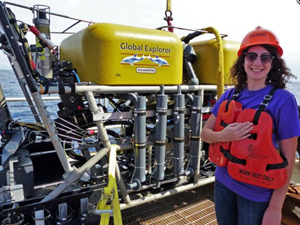
Fanny stands in front of the ROV Global Explorer after a successful dive. She uses ROVs to image corals and collect different types of samples, including coral, water, and sediment. (Photo by Cherisse DuPreez)
The slow growth rates and abnormal branch loss that their team observed could indicate a lengthy post-oil spill recovery process. Fanny created a mathematical model that uses a matrix population model to project how many branches per coral colony will present as healthy, unhealthy, or colonized by hydroids and estimate recovery time. “The model suggests that it will take decades until all remaining branches appear healthy,” Fanny explained. “It will take another century until the lost branches have regrown.” She said that the long term image-based monitoring technique used in her research is an excellent tool to identify corals that suddenly become damaged or die, indicating an environmental disturbance.
Her Learning
Fanny experienced the most scientific growth while working with her advisors, Drs. Chuck Fisher and Iliana Baums, conducting field work aboard research cruises. Since beginning her Ph.D., she has participated in at least one research cruise each year and acted as chief scientist during a 2016 cruise. She says that the interdisciplinary nature of expeditions gave her a greater appreciation for other fields and introduced her to people who share her passion for the environment. The experiences taught her important skills for conducting research expeditions, such as coordinating between scientists, crew members, and ROV teams. “Making connections is extremely important for graduate students to find employers and identify future collaborations, but it can also be very difficult,” said Fanny. “I think being part of the GoMRI science community really facilitated that process.”
Her Future
Fanny plans to continue studying the deep sea and hopes her research can help protect and restore vulnerable ecosystems. She is considering post-doc opportunities, possibly in Europe, but is willing to travel anywhere for the right project. She advises students considering a scientific career to follow their passion, even if it seems difficult. As an undergraduate student, Fanny often expressed a desire to go on expeditions and study the ocean. However, most people dismissed her goals because of limited job opportunities and advised her to pursue a more mainstream profession. “I didn’t listen, and now I’m doing what I love,” she said. “I think if you are determined and love what you are doing, you will succeed.”
Praise for Fanny
Dr. Fisher said that Fanny has been an important asset to his team’s research since her first day. He explained that she developed the research methods used to demonstrate and quantify the brittle stars’ beneficial effects on oil-impacted coral’s recovery on her own. “Fanny is a pleasure to work with and has taken our research in new and exciting directions,” he said. “Most recently, she developed a mathematical model to predict the eventual fate of long-lived corals impacted by the oil spill.”
The GoMRI community embraces bright and dedicated students like Fanny Girard and their important contributions. The GoMRI Scholars Program recognizes graduate students whose work focuses on GoMRI-funded projects and builds community for the next generation of ocean science professionals. Visit the ECOGIG website to learn more about their work.
************
The Gulf of Mexico Research Initiative (GoMRI) is a 10-year independent research program established to study the effect, and the potential associated impact, of hydrocarbon releases on the environment and public health, as well as to develop improved spill mitigation, oil detection, characterization and remediation technologies. An independent and academic 20-member Research Board makes the funding and research direction decisions to ensure the intellectual quality, effectiveness and academic independence of the GoMRI research. All research data, findings and publications will be made publicly available. The program was established through a $500 million financial commitment from BP. For more information, visit http://gulfresearchinitiative.org/.
© Copyright 2010- 2017 Gulf of Mexico Research Initiative (GoMRI) – All Rights Reserved. Redistribution is encouraged with acknowledgement to the Gulf of Mexico Research Initiative (GoMRI). Please credit images and/or videos as done in each article. Questions? Contact web-content editor Nilde “Maggie” Dannreuther, Northern Gulf Institute, Mississippi State University (maggied@ngi.msstate.edu).
Grad Student Dykstra Sees Global Applications for Local Ocean Circulation Maps
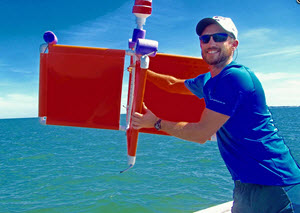
Steve releases a drifter at Main Pass (Mobile Bay), Alabama, to study the surface tidal plume. (Provided by Steve Dykstra)
When Deepwater Horizon oil approached coastal environments, it was unclear how river water entering the Gulf of Mexico would affect the oil’s transport and fate. Steve Dykstra uses drifters and ship-deployed sensors to study how freshwater plumes disperse in the coastal environment over different seafloor topography. He plans to someday use his findings and experience to help inform coastal resource management in developing countries.
Steve Dykstra is a Ph.D. student at the University of South Alabama’s marine science program and a GoMRI Scholar with the Consortium for Oil Spill Exposure Pathways in Coastal River-Dominated Ecosystems (CONCORDE).
His Path
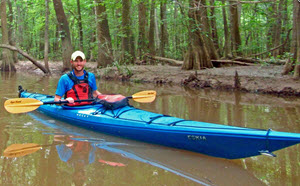
Steve explores the Mobile-Tensaw Delta to better understand how the area’s fluvial-tidal flow affects coastal circulation. (Provided by Steve Dykstra)
Steve became interested in science while exploring the forests, lakes, and wetlands around his childhood home near Lake Michigan. He was fascinated by nature’s complexity and developed a particular interest in river and stream morphology, which studies the form, function, and interactions of these waters with the surrounding landscape. As he grew up, Steve became more knowledgeable about morphology by frequenting sand dunes and learning how to redirect or “pirate” streams. He completed a bachelor’s degree in science at Calvin College in 2008 and decided his next steps would be less conventional.
Steve worked as a naturalist in Alaska’s Kenai Fjords National Park and Chugach National Forest, where he led tourist excursions and taught visitors about the area’s geology, ecology, and wildlife. Next, he volunteered for the NGO Help for the Massai, distributing food and helping run immunization clinics in Tanzania near Serengeti National Park in the Ngorongoro Conservation Area. “Working with the indigenous Massai people, I got a first-hand look at the developing world,” he said. “It taught me how to work cross-culturally.”
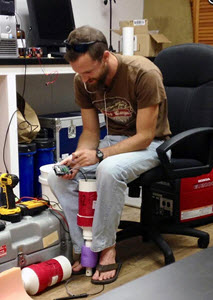
Steve prepares the microprocessors he constructed to go inside his drifters. (Provided by Steve Dykstra)
Steve completed an environmental science master’s degree at Taylor University and interned with Dynamic Solutions International’s watershed management program in Vietnam. He worked in watershed management in Tajikistan through the Global Partners organization. Security issues sent him back to the United States, and he decided to pursue a long-time desire – obtaining his Ph.D. Steve found an opportunity to research freshwater discharge’s influence on the coastal environment with Dr. Brian Dzwonkowski and joined his team at the Dauphin Island Sea Lab (DISL).
A personal motivator for Steve is a calling to Biblical stewardship. “As a Christian, I believe I’m called to care for and try to reconcile the world around me,” he said. “I think it’s something that a lot of Christians overlook, but stewardship includes the natural environment that we have.”
His Work
Steve works in the Mobile Bay delta, where tides influence river flow and level as it moves into the coastal area. As freshwater enters saltier waters, it remains on the surface and forms a plume that spreads over a wide area. However, changes in the coastal geomorphology can alter flow dynamics, salinity, and the freshwater’s movement into the Gulf. “Narrow or wide or deep inlets change the way water flows,” explained Steve. “As the geomorphology changes – either naturally or anthropogenically –it changes the flow dynamics, which inadvertently change how much salinity goes into the Bay and how the freshwater moves out into the Gulf.”
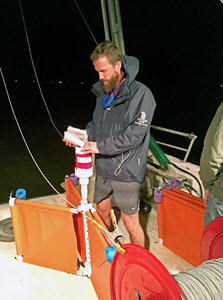
Steve prepares a drifter for release. (Provided by Steve Dykstra)
Steve’s component of the research focuses on Main Pass, Mobile Bay, where he helps build and release GPS-equipped drifters fitted with temperature and salinity sensors to study how fast they move, where they move, and how they spread out and disperse. He takes simultaneous measurements aboard a research vessel using conductivity, temperature, and depth (CTD) sensors and a Laser In-Situ Scattering and Transmissometry (LISST) instrument, which measures sediment grain sizes and concentrations in the water. He compares these measurements with the drifter readings to determine the plume’s movement relative to the surrounding environment, what it transports, and how it mixes with Gulf waters.
Steve’s observations will help validate a CONCORDE-developed circulation model reflecting the exposure pathways and mechanisms of Deepwater Horizon oil. His work will inform the land-to-sea portion of the model and compliment other researchers’ work in offshore regions. “It’s easier to predict how oil will function when it’s moving around in the Gulf of Mexico, but it’s more difficult to figure out how it will interact with the complex shoreline,” he said. “I’m taking observations to help inform and change the model to better reflect the system that we’re actually working with.”
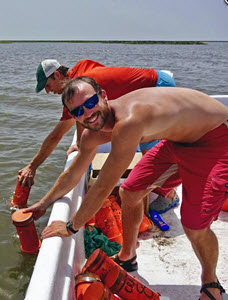
Steve and his advisor, Dr. Brian Dzwonkowski, release small drifters in the Grand Bay National Estuary Research Reserve. (Provided by Steve Dykstra)
His Learning
One of the greatest benefits from Steve’s GoMRI research has been the opportunity to take the time to delve into the materials and research. His past travels left him little opportunity to get to know a single system. “I often had to skip over some good insights and get more of the theory behind something instead of really learning one particular local environment. I think it’s been helpful to finally do and understand that,” he said. Steve’s GoMRI work also introduced him to marine science. Prior to beginning his Ph.D., Steve had never taken a marine science class and had little experience working in coastal or marine environments. He credits his research as the source of everything he currently knows about marine environments.
Steve also frequently works with his secondary advisor Kelly Dorgan, a sediment ecologist with the ACER consortium. Interacting with researchers from different projects helps him see differences in how consortia operate and coordinate when conducting research in same region. Steve meets and interacts with scientists in many disciplines and observes how they conduct their research and interact with other investigators. Steve reflected, “I’ve been able to learn quite a bit about discerning who to learn from and what questions to ask which researchers.”
His Future
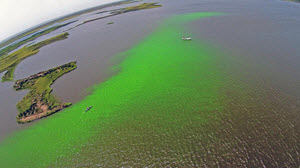
Steve and Dr. Dzwonkowski (white boat) follow drifters to compare their tracks with a dye release in Grand Bay National Estuary Research Reserve. (Photo by Robert Moorhead)
Steve is considering a post-doctoral position after graduation and becoming further established in his field. However, his long-term goal is to go back overseas and conduct research in resources management for developing countries, where he believes his education and experience in streams and coastal environments could help. “I’d like to help countries that are trying to manage their resources, particularly in deciding how to balance development and conservation. Whether I’m doing consulting work or conducting research with a local university, I’d like to continue to do some of the relief work I was doing previously but with further expertise.”
Steve advises that students considering a science career should start broad, learning a wide range of foundational material, and then specialize through research and internship opportunities. “Don’t do an internship because it looks good on your resume but chase your dreams and allow yourself to fail in that process,” he said. He hints that those opportunities might even offer a way to avoid debt after graduating, “Be willing to take things slower and work jobs that you may not have initially considered or move to places with better financial opportunities. I’ve been able to go through debt-free, not because I had parents assisting me, but because I worked hard and moved to places that I’d never been before.”
Praise for Steve
Dzwonkowski said that Steve has shown impressive ambition and an industrious nature throughout his graduate career. He said that Steve seeks ways to improve his grant-writing skills, hunting down external research funds to support his graduate career through student travel opportunities and prestigious fellowship opportunities. “Given his early and immediate interest in proposal writing, I am positive that Steve will be successful obtaining future research funds,” he said.
Dzwonkowski also highlighted Steve’s contributions to education and outreach efforts. DISL adapted Arduino computing components for their summer research, and Steve helped train students to wire and program the components and discussed how they could use the low-cost technology in their own research. He is preparing to help build Arduino-based technical skills into K-12 lesson plans. “He has a very positive influence on the people around him,” said Dzwonkowski. “He has been a great addition to DISL, and I look forward to seeing him develop along what I know will be a highly impactful career path. I believe he will make a difference in many peoples’ lives over the course of his career.”
The GoMRI community embraces bright and dedicated students like Steve Dykstra and their important contributions. The GoMRI Scholars Program recognizes graduate students whose work focuses on GoMRI-funded projects and builds community for the next generation of ocean science professionals. Visit the CONCORDE website to learn more about their work.
************
The Gulf of Mexico Research Initiative (GoMRI) is a 10-year independent research program established to study the effect, and the potential associated impact, of hydrocarbon releases on the environment and public health, as well as to develop improved spill mitigation, oil detection, characterization and remediation technologies. An independent and academic 20-member Research Board makes the funding and research direction decisions to ensure the intellectual quality, effectiveness and academic independence of the GoMRI research. All research data, findings and publications will be made publicly available. The program was established through a $500 million financial commitment from BP. For more information, visit http://gulfresearchinitiative.org/.
© Copyright 2010- 2017 Gulf of Mexico Research Initiative (GoMRI) – All Rights Reserved. Redistribution is encouraged with acknowledgement to the Gulf of Mexico Research Initiative (GoMRI). Please credit images and/or videos as done in each article. Questions? Contact web-content editor Nilde “Maggie” Dannreuther, Northern Gulf Institute, Mississippi State University (maggied@ngi.msstate.edu).
RFP-V Drennan: Using Complementary Simulations to Improve Oil Tracking under Hurricane Conditions
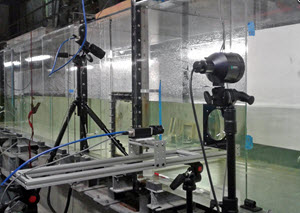
A close up of major equipment used in the experimental set up in the University of Miami ASSIST facility. The equipment includes (left to right) the wave slope gauge, the Particle Image Velocimetry (PIV)/bubble imager, and spray shadowgraph. (Photo by Will Drennan)
Interactions among wind, waves, and upper-ocean currents are essential factors in predicting oil slick transport and fate. These complex interactions, however, make capturing their dynamics in simulations challenging, especially when turbulent weather conditions are present.
The Gulf of Mexico Research Initiative recently awarded Dr. William Drennan a grant to study how wind-wave-current interactions affect oil transport under significant wave influences, such as hurricanes. The researchers are taking a two-step approach that combines model simulations with parameters derived from laboratory wave tank experiments. Their goal is to improve our ability to monitor and contain oil in the event another spill occurs under high-turbulence conditions.
“The more oil that gets away from us, the more oil that ends up in the ecosystem somewhere,” said Drennan. “Our goal is that, if there is another spill like this, we will be able to better prepare and make the clean up more efficient. If there’s a big storm coming, we need to modify how we react to the spill and capture the oil that will escape from the spill area as a result.”
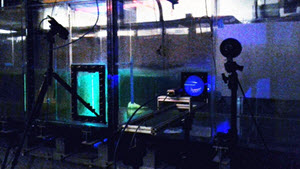
The ASIST flume experiment while underway, using the laser light for the slope gauge and the backlight of the PIV. (Photo by Will Drennan)
Co-Principal Investigator Dr. Lian Shen is simulating wind, waves, and ocean currents using a suite of state-of-the-art wave-resolving models to visualize the spray, bubbles, and oil transport pathways that result from breaking waves under various sea conditions. The models will help capture the processes essential to ocean wave-field dynamics so that researchers can observe where oil goes in simulations.
The model’s simulations need to be realistic so that results represent oil’s behavior in the ocean.
Drennan is simulating breaking waves using unique and advanced wind-wave tank facilities in the University of Miami’s Surge-Structure-Atmosphere Interaction (SUSTAIN) laboratory. Observations from experiments in the tanks will help him map the wave topography in great detail and inform and calibrate Shen’s models. Drennan is measuring spray and bubble behavior under various wind and wave conditions (including a Category 5 hurricane) with and without oil present. He is incorporating these laboratory measurements into the models to provide a detailed 3D description – a necessary dataset to construct the wind, waves, and currents field and develop a deeper understanding of their physical processes.
Drennan reflected on the project’s motivations for focusing on transport under significant wave influences, “As long as we’re going to be producing oil in areas where there are hurricanes or tropical storms, we need to understand how to respond to a potential disaster under those conditions. It’s interdisciplinary, because the consequences of a disaster affect everything from marine life to fisheries to coastal resilience. If we can prepare and respond better to a disaster, then we can avoid some of the really negative consequences.”
The project’s researchers are William Drennan at the University of Miami Rosenstiel School of Marine and Atmospheric Science and Lian Shen at the University of Minnesota Department of Mechanical Engineering. Their project is Investigation of Oil Spill Transport in a Coupled Wind-Wave Current Environment Using Simulation and Laboratory Studies.
************
The Gulf of Mexico Research Initiative (GoMRI) is a 10-year independent research program established to study the effect, and the potential associated impact, of hydrocarbon releases on the environment and public health, as well as to develop improved spill mitigation, oil detection, characterization and remediation technologies. An independent and academic 20-member Research Board makes the funding and research direction decisions to ensure the intellectual quality, effectiveness and academic independence of the GoMRI research. All research data, findings and publications will be made publicly available. The program was established through a $500 million financial commitment from BP. For more information, visit http://gulfresearchinitiative.org/.
© Copyright 2010- 2017 Gulf of Mexico Research Initiative (GoMRI) – All Rights Reserved. Redistribution is encouraged with acknowledgement to the Gulf of Mexico Research Initiative (GoMRI). Please credit images and/or videos as done in each article. Questions? Contact web-content editor Nilde “Maggie” Dannreuther, Northern Gulf Institute, Mississippi State University (maggied@ngi.msstate.edu).
Fact Sheet: ACER Tool Talk Series Highlights SCAT Maps

A SCAT map of a portion of the Chandeleur Islands which are the focus of ACER’ research. Credit: https://gomex.erma.noaa.gov/erma.html
A Shoreline Cleanup and Assessment Technique (SCAT) map indicates the degree of oiling at a geographic location. SCAT teams survey shorelines to collect important data that will help them analyze the amount of necessary cleanup, choose cleanup techniques, and monitor clean up effectiveness.
Trailer: Dispatches from the Gulf 2 (2017)

Credit: Screenscope
The Gulf of Mexico Research Initiative is pleased to announce the release of the Screenscope film production company’s trailer for “Dispatches from the Gulf-2.”
This second film continues the remarkable stories about the global scientific team studying the Deepwater Horizon oil spill. The movie, narrated by Matt Damon, will air later this year as a new episode of the award-winning Journey to Planet Earth Series.
The first “Dispatches from the Gulf” documentary received industry recognition with an Emmy for best photography and the Blue Whale Award at the 2016 Blue Ocean Film Festival. Using material from this first documentary, producers Hal and Marylyn Weiner created 50 video shorts that include film highlights, interviews with scientists and graduate students, and more. An associated Educators Guide provides detailed descriptions and keywords for each video and can be used in classroom curriculum and in other educational efforts.
The Gulf of Mexico Research Initiative, in response to the 2010 oil spill, initiated an unprecedented response effort and mobilized the largest, coordinated scientific research endeavor around an ocean-related event in history. For additional information about the Gulf of Mexico Research Initiative:
- Watch this video: The Making of a Ten-Year Gulf of Mexico Research Program
- Use the Research Information System to learn about funded projects, people, and publications
- Use the Gulf of Mexico Research Initiative Information and Data Cooperative to discover and access scientific datasets resulting from GoMRI-funded research
***********
“Dispatches from the Gulf” is made possible in part by a grant from The Gulf of Mexico Research Initiative (GoMRI). The GoMRI is a 10-year independent research program established to study the effect, and the potential associated impact, of hydrocarbon releases on the environment and public health, as well as to develop improved spill mitigation, oil detection, characterization and remediation technologies. An independent and academic 20-member Research Board makes the funding and research direction decisions to ensure the intellectual quality, effectiveness and academic independence of the GoMRI research. All research data, findings and publications will be made publicly available. The program was established through a $500 million financial commitment from BP. For more information, visit http://gulfresearchinitiative.org/.
© Copyright 2010- 2017 Gulf of Mexico Research Initiative (GoMRI) – All Rights Reserved. Redistribution is encouraged with acknowledgement to the Gulf of Mexico Research Initiative (GoMRI). Please credit images and/or videos as done in each article. Questions? Contact web-content editor Nilde “Maggie” Dannreuther, Northern Gulf Institute, Mississippi State University (maggied@ngi.msstate.edu).
Fact Sheet: Sea Grant Releases Brochure on Oil FAQs
The Sea Grant Oil Spill Outreach Team recently developed a new informational brochure that explores basic aspects of oil as a natural resource and oil spills. The synthesizes peer-reviewed science for a broad range of general audiences, particularly those who live and work across the Gulf Coast.
The brochure Frequently Asked Questions Oil Edition addresses questions such as What is oil? How is oil released into the environment? Who produces and uses oil? Does oil break down? How do scientists determine the origin of oil found in the environment?
Sea Grant offers oil-spill-related public seminars across the Gulf Coast. Click here to view upcoming science seminars and read about recently-held events. To receive email updates about seminars, publications, and the outreach team, click here.
************
GoMRI and the Sea Grant programs of the Gulf of Mexico (Florida, Mississippi-Alabama, Louisiana, and Texas) have partnered to create an oil spill science outreach program.
The Gulf of Mexico Research Initiative (GoMRI) is a 10-year independent research program established to study the effect, and the potential associated impact, of hydrocarbon releases on the environment and public health, as well as to develop improved spill mitigation, oil detection, characterization and remediation technologies. An independent and academic 20-member Research Board makes the funding and research direction decisions to ensure the intellectual quality, effectiveness and academic independence of the GoMRI research. All research data, findings and publications will be made publicly available. The program was established through a $500 million financial commitment from BP. For more information, visit http://gulfresearchinitiative.org/.
© Copyright 2010- 2017 Gulf of Mexico Research Initiative (GoMRI) – All Rights Reserved. Redistribution is encouraged with acknowledgement to the Gulf of Mexico Research Initiative (GoMRI). Please credit images and/or videos as done in each article. Questions? Contact web-content editor Nilde “Maggie” Dannreuther, Northern Gulf Institute, Mississippi State University (maggied@ngi.msstate.edu).
Video: CWC Researchers Use GoPros to Monitor Land Loss

Photo by CWC
A recent blog post describes how consortium scientists Giovanna McClenachan and R. Eugene Turner used GoPro® cameras to photograph a study site at two-hour intervals during four- to six-week periods between August 2014 and September 2015. Read about their findings here and check out the resulting time-lapse video!
Grad Student Diamante Investigates How PAHs Affect Fish Development
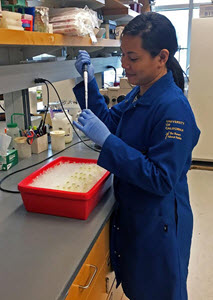
Graciel prepares zebrafish embryo samples for RNA extractions to assess gene regulation after PAH exposure. (Provided by Graciel Diamante)
Polycyclic aromatic hydrocarbons (PAHs) can disrupt important signaling pathways that transcribe genes during fish’s early embryonic development, which could cause malformations. Graciel Diamante is conducting laboratory experiments with fish embryos to understand how weathered PAHs affect fish development. She is also finding that her work demonstrates the importance of perseverance, giving back, and collaborating within a diverse scientific community.
Graciel is an environmental toxicology Ph.D. student at the University of California, Riverside (UCR) and a GoMRI Scholar with the RECOVER consortium.
Her Path
Graciel began pursuing biology as an undergraduate at California State University, Northridge (CSUN) after her enthusiastic biology professor sparked her interest in the field. She explored different research programs and worked in several labs and summer research opportunities to narrow her interests. She discovered a passion for toxicology while working on a University of California, Los Angeles summer project researching how saporin – a ribosome-inactivating protein found in soapwort plants – causes toxicity.
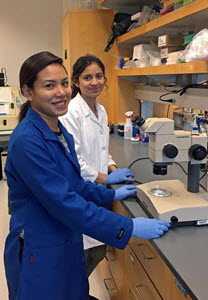
Graciel (left) and Norma Menjivar-Cervantes, an undergraduate at UCR, assess zebrafish embryos after PAH exposure. (Provided by Graciel Diamante)
She completed her undergraduate degree in cell and molecular biology and entered UCR’s environmental toxicology Ph.D. program. There, her interest in understanding how different compounds affect fish cardiovascular development led her to her advisor, Dr. Daniel Schlenk. Although Dr. Schlenk did not have an open position when Graciel arrived, he was impressed by her persistence and took her on as a graduate teaching assistant. She also conducted laboratory research while attending classes until Schlenk’s lab began its collaboration with the RECOVER consortium. “When the GoMRI grant came in, she was my first choice to put on as graduate student support,” said Schlenk.
Her Work
Chrysene is one of the most persistent PAHs in the water column following an oil spill and can produce oxygenated derivatives such as 2- and 6-hydroxychrysene after undergoing photo-oxidation. These hydroxylated compounds can disrupt important estrogen-signaling pathways during embryonic development, but little else is known about their toxicity. Graciel investigates the signaling pathways involved in hydroxylated PAH toxicity using zebrafish as a model for vertebrate development.
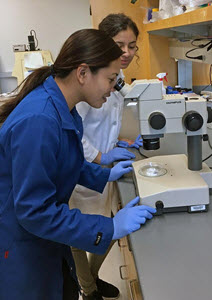
Graciel (left) and undergraduate Norma Menjivar-Cervantes use a miscroscope to assess the impacts of chemical exposure to zebrafish embryos. (Provided by Graciel Diamante)
Graciel prepares zebrafish embryos so that they are all the same developmental stage and conducts 74-hour exposure experiments using different concentrations of 2-hydroxychrysene and 6-hydroxychrysene (0.5 μM to 10 μM). Using real-time polymerase chain reaction (qPCR), she analyzes the embryos to assess the expression of certain genes that these chemicals can potentially alter and evaluate the occurrence of deformities compared to controls. She also determines the number of dead and alive embryos during the experiments.
She is observing that, unlike the parent compound chrysene, 2-hydroxychrysene and 6-hydroxychrysene exposures of at least 0.5 μM and 3 μM, respectively, increase developmental defects including cardiac, circulatory, and eye defects. The 6-hydroxychrysene concentrations of at least 3 μM decrease embryo survival, while 2-hydroxychrysene concentrations do not. Next, Graciel will conduct the same experiment using mahi mahi embryos and determine if the same effects are observed across fish species. She will use lower hydroxylated PAH concentrations and evaluate embryos for the deformities and altered transcripts found in the zebrafish experiments.
Her Learning
Graciel is an active mentor in the UCR’s Research in Science and Engineering (RISE) undergraduate program, which helps students from diverse backgrounds get involved with research. While she was an undergraduate student participating in CSUN’s Research Initiative for Scientific Enhancement program and later its Minority Access to Research Careers program, Graciel saw first-hand the impact such programs can have on a student’s professional growth. “As a mentor, I want teach them about a project’s importance, experimental design, and the ups and down of research – things you can’t learn in a classroom setting,” she said. “I want them to find what it is that inspires them, so that they can find a career they truly enjoy.”
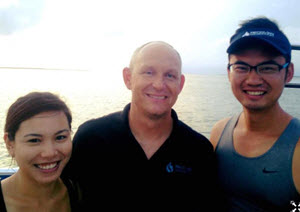
Graciel (left) with RECOVER scientists Dr. Daniel Schlenk (center) and Dr. Elvis Xu (right). (Provided by Graciel Diamante)
Graciel said that working in Schlenk’s lab during her GoMRI research taught her that science is a continual learning process. “Just as you uncover the answer to one question, another question arises.” She also learned that science pushes forward collaborations. “The importance of networking became even clearer when I joined the GoMRI community,” she said. “The RECOVER group has great scientists as well as some of the nicest people I have met.”
Living and attending school in a culturally mixed environment has helped Graciel meet and work with individuals from unique backgrounds. Cultural diversity has had an important impact on her personal maturity and shown her the importance of a diverse scientific community. She explained, “Research needs different ideas and is highly dependent on creativity and critical thinking. There is no better way to obtain this than from diverse individuals.”
Her Future
Graciel hopes to attain a post-doctoral position, continue researching fish cardiac development and physiology, and combine toxicology and developmental biology to investigate contaminants and their specific mode of action. Ultimately, she wants to become a professor and foster students’ curiosity about science and promote higher education. She suggests that students considering a science career get involved in a research project to help focus their ambitions. Gaining research experience and working in multiple labs as an undergraduate helped Graciel prepare for graduate work and her overall scientific career. “These experiences helped me figure out what my interests were and if this was the career I wanted to pursue,” she said.
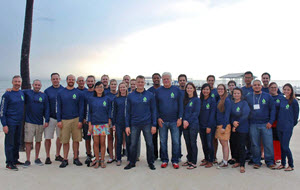
Graciel and the RECOVER team pose for a photo at a consortium All-Hands Meeting. (Photo by Daniel DiNicola)
Praise for Graciel
Schlenk said Graciel displayed a positive attitude and persevered in the face of setbacks. He explained that when the project began, it appeared that Graciel was seeing very significant effects on the fish. However, she discovered that her results were caused by a pathogen infestation in the animal model, not the chemicals she was testing. Rather than giving up, Graciel quickly began preparations to repeat the experiment. “She spent almost a whole year on her project and had to repeat everything all over again using a different animal,” he said. “So many students say ‘tell me the easy way out’ and she’s never ever asked that. It’s been neat to see her develop through this project so that she knows now what studies to do and what end points to look at. It’s very encouraging for me as a mentor.”
Schlenk explained that Graciel is a first-generation college student and that her passion for education and women in science is evident in mentoring female undergraduate students. Schlenk believes that the students’ increasing excitement about science and research is due to Graciel’s mentorship. “It’s wonderful that she’s able to touch students’ lives,” he said. “I think she’s so grateful for the opportunities she’s had that she wants to show her gratitude by doing the same things for younger students – kind of passing the torch.”
Schlenk also discussed Graciel’s personal interactions in the lab, describing her as “the mom in the group,” helping out and taking care of issues without complaint. He concluded, “She’s just a wonderful, caring person who wants to do the right thing. It’s so refreshing.”
The GoMRI community embraces bright and dedicated students like Graciel Diamante and their important contributions. The GoMRI Scholars Program recognizes graduate students whose work focuses on GoMRI-funded projects and builds community for the next generation of ocean science professionals. Visit the RECOVER website to learn more about their work.
************
The Gulf of Mexico Research Initiative (GoMRI) is a 10-year independent research program established to study the effect, and the potential associated impact, of hydrocarbon releases on the environment and public health, as well as to develop improved spill mitigation, oil detection, characterization and remediation technologies. An independent and academic 20-member Research Board makes the funding and research direction decisions to ensure the intellectual quality, effectiveness and academic independence of the GoMRI research. All research data, findings and publications will be made publicly available. The program was established through a $500 million financial commitment from BP. For more information, visit http://gulfresearchinitiative.org/.
© Copyright 2010- 2017 Gulf of Mexico Research Initiative (GoMRI) – All Rights Reserved. Redistribution is encouraged with acknowledgement to the Gulf of Mexico Research Initiative (GoMRI). Please credit images and/or videos as done in each article. Questions? Contact web-content editor Nilde “Maggie” Dannreuther, Northern Gulf Institute, Mississippi State University (maggied@ngi.msstate.edu).
RFP-V Shay: Building a Rapid Response System for Predicting Water Column Processes and Oil Fate
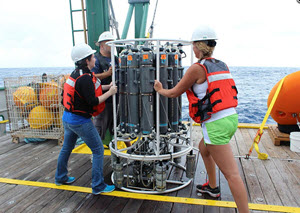
Senior research associate Jodi Brewster (left) and Ph.D. candidate Johna Rudzin (right) deploying a CTD with Nanson bottles off the University of Miami R/V F. G. Walton Smith, a ship in the University-National Oceanographic Laboratory System fleet. (Photo by Jodi Brewster).
As the Deepwater Horizon oil spill unfolded, there were concerns that the Loop Current might transport oil out of the Gulf to the Florida Keys and up the eastern seaboard. This possibility highlighted the need for quick predictions of oceanic flows and subsurface hydrocarbon distribution during and after a spill. Because physical and biochemical processes can alter subsurface hydrocarbons’ chemical composition and behavior, a successful modeling system must account for these processes when predicting oil fate.
The Gulf of Mexico Research Initiative (GoMRI) recently awarded Dr. Lynn “Nick” Shay a grant to develop an integrated physical and biogeochemical observation and prediction system to map the near-real-time distribution of subsurface hydrocarbons and quantify hydrocarbon fate as oil interacts with currents and sinking marine particles. Their goal is to build an observational system that researchers can easily deploy from ships and/or aircraft to start immediate sampling and begin running model scenarios for future oil spills.
The proposed system is a cluster of ten electromagnetic Autonomous Profiling Explorer (APEX) floats with physical, chemical and bio-optical sensors that provide information to a data-assimilative physical-biogeochemical model for hindcast, nowcast, and forecast simulations of oil transport and fate. The team will equip the floats with a novel combination of CTD and electromagnetic current sensors and oxygen, chlorophyll, and colored dissolved organic matter fluorescence and backscatter sensors. The system will focus on the accurate representation of mid-water column processes, including the interaction of hydrocarbon droplets with marine particles.
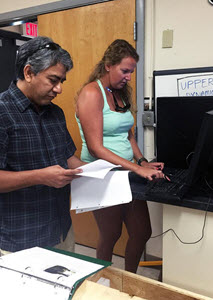
Prior to deployment, Johna Rudzin (right) and assistant research scientist Benjamin Jaimes (left) test the profiling parameters of an air-deployable EM/Apex float in a Rosenstiel School of Marine and Atmospheric Science laboratory. (Photo by Jodi Brewster).
“These floats have been used in the field for shipboard and aircraft deployments during hurricanes and can readily withstand major ocean and atmospheric stressors,” said Shay. “These profilers were designed to profile to depths of 2,000 m at intervals of 4 – 7 days, depending on the ocean and atmosphere conditions. That means if a hurricane is moving over the Gulf, for example, we can program the floats to sample faster and examine the effects of strong wind-driven currents and upwelling on these biochemical processes.”
The researchers will perform data-assimilative model simulations to hindcast circulation during Deepwater Horizon and determine optimal deployment strategies for field testing the floats. They will then deploy the floats in the northern Gulf from Summer 2017 to Spring 2018 to assess its skill during energetic physical processes, such as the Loop Current and atmospheric events, including hurricane season (summer) and atmospheric frontal passages (winter).
The team will assess the system’s performance using profiler metrics such as temperature, current, and salinity taken pre-, during-, and after weather events. They will also assess the system’s performance using data gathered during and after Deepwater Horizon by other GoMRI projects and the National Oceanic and Atmospheric Administration (NOAA). They will then evaluate and improve the model’s representation of mid-water column particle distributions and fluxes, accounting explicitly for marine particles interacting with oil droplets. Finally, they will validate the system’s capability for real-time, end-to-end nowcasting and forecasting by assimilating physical and biochemical satellite and float observations in near-real-time and assessing the system’s predictive skill.
Shay explained that the products created by this research will make both academic and societal contributions, “Scientifically, we hope to show how the physical stressors affect these biogeochemical processes. Societally, we hope to provide the community with an easily deployable end-to-end system product that returns real-time data to help emergency responders and policy makers to mitigate deep-sea oil spills like Deepwater Horizon.”
The project’s researchers are Lynn “Nick” Shay at the University of Miami, Katja Fennel at Dalhousie University, Peter Furze at Teledyne Webb Research, and Ruoying He at North Carolina State University. Their project is Three-Dimensional Gulf Circulation and Biogeochemical Processes Unveiled by State-of-the-Art Profiling Float Technology and Data Assimilative Ocean Models.
************
The Gulf of Mexico Research Initiative (GoMRI) is a 10-year independent research program established to study the effect, and the potential associated impact, of hydrocarbon releases on the environment and public health, as well as to develop improved spill mitigation, oil detection, characterization and remediation technologies. An independent and academic 20-member Research Board makes the funding and research direction decisions to ensure the intellectual quality, effectiveness and academic independence of the GoMRI research. All research data, findings and publications will be made publicly available. The program was established through a $500 million financial commitment from BP. For more information, visit http://gulfresearchinitiative.org/.
© Copyright 2010- 2017 Gulf of Mexico Research Initiative (GoMRI) – All Rights Reserved. Redistribution is encouraged with acknowledgement to the Gulf of Mexico Research Initiative (GoMRI). Please credit images and/or videos as done in each article. Questions? Contact web-content editor Nilde “Maggie” Dannreuther, Northern Gulf Institute, Mississippi State University (maggied@ngi.msstate.edu).
Video: Infrared Video Documents Oil-Dispersant Interactions

Credit: Alexander Soloviev
Nova Southeastern University researcher Alexander Soloviev and his team generated a short clip in infrared imagery demonstrating how crude and weathered oil slicks respond to dispersant application.
RFP-V Thomas: Building a Benthic Genome Database for Improved Oil Spill Monitoring
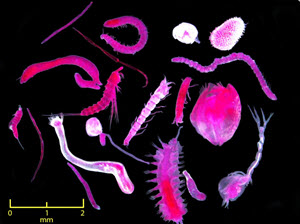
Image of meiofaunal eukaryotes (Credit to Larry Hyde)
Meiofauna are invertebrate organisms that live in seafloor sediments. These marine creatures perform ecosystem functions such as trophic transfer, biogeochemical cycles, pollution removal, and sediment transport stability. Sensitive to environmental events such as oil spills, meiofauna are valuable bioindicators of impacts from contamination. However, their small size and our limited knowledge about these organisms’ community structure and taxonomy makes it difficult to track and characterize oil’s impacts.
The Gulf of Mexico Research Initiative recently awarded Dr. Kelley Thomas a grant to compile a reference genome database of benthic meiofaunal eukaryotes and establish Standard Operating Procedures (SOPs) for monitoring oil spills using bioinformatics. These tools can help researchers and responders interpret how spills might affect organisms in a particular area and how the organisms are expected to recover. “There’s so much we don’t understand about the relationship between the Gulf’s biogeochemical structure and the distribution of different taxa – we really don’t have any idea,” explained Thomas. “This information will help us better interpret the spill’s consequences and what kind of recovery will take place.”
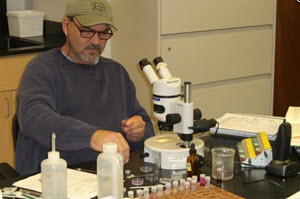
Larry Hyde reviews samples under a microscope. (Photo by Rick Kalke)
His team is analyzing as many individual benthic eukaryotes as they can using whole genome shotgun sequencing, a quick and economically-effective method for analyzing the structure of long DNA strands. The researchers are compiling the resulting data into a large database of reference genomes to identify biomarker genes based on their ability to identify changes in population and community structure. Once completed, they can sequence pre- and post-spill samples of the benthic community for the biomarker genes and identify which organisms and communities the spill impacted.
“In the mid-2000s, genetic sequencing technology rapidly advanced to allow us to run up to 200,000,000 sequences at a time when before we could only run about 100 sequences at a time,” explained Thomas. “The technology has steadily improved and gotten cheaper over time since then. That’s why today it is feasible to consider modeling the benthic Gulf of Mexico in a large-scale way just by conducting DNA sequencing and analyses.”
The project is also developing clear and concise SOPs for using the genome database to conduct environmental and oil spill monitoring. The open-source SOPs will target researchers without previous genomics experience to help train future scientists to understand the communities’ sediment biology and conduct big data analyses using bioinformatics. An annual workshop will introduce undergraduate and graduate students to the SOPs, from sample preparation to interpreting metagenomics and implementing bioinformatics.
“It’s not just microscopes anymore. Most of a researcher’s time is spent in front of a computer,” said Thomas. “The skills taught in this training will have more biological and environmental applications than just learning how to analyze Gulf of Mexico data.”
Thomas’s team is enthusiastic about the potential of their project’s products to offer analytic tools and facilitate academic progress in the field of biology. They hope to fill gaps in the current understanding of benthic eukaryote taxa, including information about their roles in the environment, their interactions, and even their viral histories. He explained that his team is very interested in the possibility of combining their work with that of other GoMRI projects. For example, combining their findings with the ongoing effort to describe the Gulf’s biogeochemistry and other such patterns and trying to link it to organismal patterns.
“We’re not just developing a practical resource. I believe that this database is going to contribute to and make a substantial impact on biology,” said Thomas. “This is going to be the way people will monitor those environments.”
The project’s researchers are W. Kelley Thomas of the University of New Hampshire Hubbard Center for Genome Studies, Holly M. Bik of the University of California – Riverside, and Paul A. Montagna of the Texas A&M University – Corpus Christi Harte Research Institute for Gulf of Mexico Studies. Their project is Genomic Responses to the Deepwater Horizon Event and Development of High-Throughput Biological Assays for Oil Spills.
************
The Gulf of Mexico Research Initiative (GoMRI) is a 10-year independent research program established to study the effect, and the potential associated impact, of hydrocarbon releases on the environment and public health, as well as to develop improved spill mitigation, oil detection, characterization and remediation technologies. An independent and academic 20-member Research Board makes the funding and research direction decisions to ensure the intellectual quality, effectiveness and academic independence of the GoMRI research. All research data, findings and publications will be made publicly available. The program was established through a $500 million financial commitment from BP. For more information, visit http://gulfresearchinitiative.org/.
© Copyright 2010- 2017 Gulf of Mexico Research Initiative (GoMRI) – All Rights Reserved. Redistribution is encouraged with acknowledgement to the Gulf of Mexico Research Initiative (GoMRI). Please credit images and/or videos as done in each article. Questions? Contact web-content editor Nilde “Maggie” Dannreuther, Northern Gulf Institute, Mississippi State University (maggied@ngi.msstate.edu).
Grad Student Quas Analyzes Sediment Grain Size to Characterize Oil Behavior
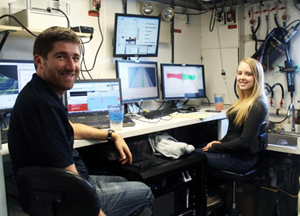
Dr. Ian Church trains Lauren to operate the Multibeam on the R/V Point Sur during the first leg of the CONCORDE Fall Campaign. (Photo credit: Heather Dippold)
Oil droplets can attach to tiny sediment particles suspended in the water column, causing them to sink to the seafloor where they can linger for a long time. Sediment grain size influences if and how oil droplets are resuspended into the water column. Larger particles sink faster and are more difficult to resuspend in the water column than smaller particles.
Lauren Quas uses acoustic sonar to map different sediment grain sizes and help understand and predict the behavior of oil in seafloor sediments. Knowing where different grain sizes are concentrated in the northern Gulf of Mexico seafloor can help scientists evaluate resuspension rates in those areas and estimate where oil might end up.
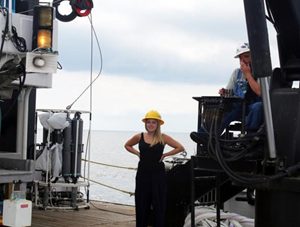
Lauren and Chief Engineer Joshua Jansen supervise the lowering of the multibeam pole into the water. (Photo credit: Alison Deary, Carla Culpepper, and Kelia Axler)
Lauren Quas is a master’s student in the University of Southern Mississippi’s Hydrographic Science program and a GoMRI Scholar with the Consortium for Oil Spill Exposure Pathways in Coastal River-Dominated Ecosystems (CONCORDE).
Her Path
As a child, Lauren loved being outdoors and collecting rocks and seashells. Her family’s vacations often involved trips to the beach, which sparked her love for the ocean. Encouraged by her parents to see the world, Lauren spent almost a decade during her high school and college years visiting countries in nearly every continent on the globe. No matter where she went, she found that the landscapes and coastlines were the most awe-inspiring parts of her travels. “It is in these places that you realize how small we are as humans and yet how big our impact is on the world,” she said.
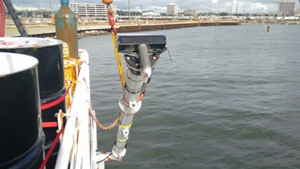
The multibeam sonar attached to the pole mount off the side of the R/V Point Sur. (Photo credit: Ian Church)
While completing her bachelor’s degree in geology at the University of Memphis, Lauren interned at the University of Memphis Groundwater Institute conducting visual stream measurements. Knowing that she wanted to pursue a career that would combine her passion for adventure and travel with her love for the ocean, she enrolled in the University of Southern Mississippi’s Geological Oceanography program. She switched her major to hydrographic science after working with her advisor, Dr. Ian Church, and seeing the career possibilities hydrography offers. She conducts studies with Dr. Church and CONCORDE’s hydrographic research team to understand the dynamics of oil and ocean sediment.
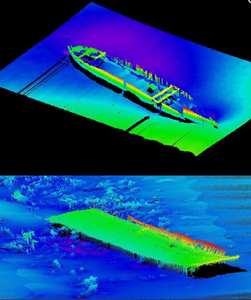
The Allen Reef Liberty Ship (above) and Casino Magic Barge (below) are examples of seafloor targets researchers can map using multibeam sonar. The sunken vessels are part of fish havens in the northern Gulf of Mexico. (Photo credit: Ian Church, Lauren Quas)
Her Work
Lauren operates a multibeam sonar to map the seafloor’s appearance and depth and quantifies the grain size of sediments using acoustic backscatter (a sound wave’s intensity after hitting the seafloor and returning to the sonar). A higher intensity return indicates that the seafloor sediment has large grain sizes, while a lower intensity return means it is composed of small grain sizes. She also collects sediment samples during research cruises using a sediment multi-corer, which removes the top 5 – 10 cm of sediment from the seabed. The sediment samples are brought back to her team’s lab at Stennis Space Center, where she analyzes them for grain size.
Lauren correlates the grain sizes depicted in the multibeam sonar data with the laboratory grain analyses to graph where different sediment sizes are located. Her sediment and backscatter data are important inputs for CONCORDE’s ocean models, which incorporate physical, chemical, and biological field data. Future scientists and responders will be able to use these models to predict and interpret how future oil spills could impact the northern Gulf of Mexico.

Lauren uses a multicorer like this one to collect seabed sediment samples. (Photo credit: CONCORDE)
Her Learning
Lauren’s first research cruise began two months after she entered her Hydrographic Science program. She recalled being intimidated at jumping into field work because of her limited background in hydrography. However, Dr. Church used the first leg of the cruise to teach her about the equipment and data processing programs, and Lauren then taught another student how to do so. “The knowledge I gained within such a short time is all due to the opportunities provided to me by Dr. Church and the CONCORDE project,” said Lauren. “This consortium is full of some of the most incredible, hard-working people I have ever met. It has been incredibly valuable to me as a young scientist to watch and work with this team.”
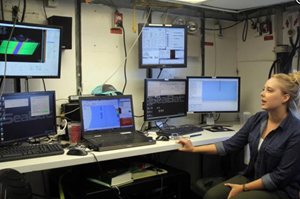
Lauren describes how the multibeam sonar transmits real-time bathymetry data to the computers onboard the R/V Point Sur. (Photo credit: Alison Deary, Carla Culpepper, and Kelia Axler)
Her Future
Lauren hopes to complete her master’s degree in August 2017 and begin her career as a field hydrographer. “The world’s oceans need to be mapped and I want to have a part in that,” said Lauren. “I am excited about the advances in technology.” She recommended that students considering a career in science get hands-on experiences to discover their passions. “I started out as a geologist, and now I am a hydrographer. If you have an interest, get your hands dirty. Volunteer or find an internship. You need the fundamentals taught in the classroom, but there is nothing like experiencing what a day in the life of a scientist is like.”
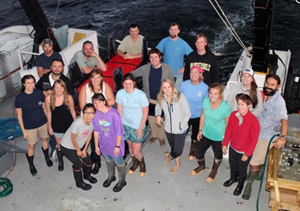
Lauren (center, gray jacket) and the CONCORDE field team onboard R/V Point Sur for the consortium’s Spring Campaign. (Provided by Lauren Quas)
Praise for Lauren
Dr. Ian Church described Lauren as an intelligent, hardworking, and innovative student whose eagerness to assist and teach others has made her a mentor to her peers. He emphasized the determination and problem-solving skills she exhibited in her leadership role aboard the R/V Point Sur during CONCORDE’s recent seabed mapping campaign. Lauren oversaw the successful mobilization of vessel sonar equipment, system troubleshooting, calibration, and data acquisition, processing, and analysis, which Church called “an incredible and notable accomplishment for anyone, let alone a graduate student with less than a year’s experience.”
Church said that Lauren’s enthusiasm is contagious and she takes pride in her research. “She is a naturally talented researcher with a drive to discover and produce innovative solutions to complex problems – I could not think of a person more deserving of the GoMRI Scholar award.”
The GoMRI community embraces bright and dedicated students like Lauren Quas and their important contributions. The GoMRI Scholars Program recognizes graduate students whose work focuses on GoMRI-funded projects and builds community for the next generation of ocean science professionals. Visit the CONCORDE website to learn more about their work.
************
The Gulf of Mexico Research Initiative (GoMRI) is a 10-year independent research program established to study the effect, and the potential associated impact, of hydrocarbon releases on the environment and public health, as well as to develop improved spill mitigation, oil detection, characterization and remediation technologies. An independent and academic 20-member Research Board makes the funding and research direction decisions to ensure the intellectual quality, effectiveness and academic independence of the GoMRI research. All research data, findings and publications will be made publicly available. The program was established through a $500 million financial commitment from BP. For more information, visit http://gulfresearchinitiative.org/.
© Copyright 2010- 2017 Gulf of Mexico Research Initiative (GoMRI) – All Rights Reserved. Redistribution is encouraged with acknowledgement to the Gulf of Mexico Research Initiative (GoMRI). Please credit images and/or videos as done in each article. Questions? Contact web-content editor Nilde “Maggie” Dannreuther, Northern Gulf Institute, Mississippi State University (maggied@ngi.msstate.edu).
RFP-V Lin: Resiliency and Recovery Connections in Oiled Wetland Plant-Microbial-Benthic Ecosystem
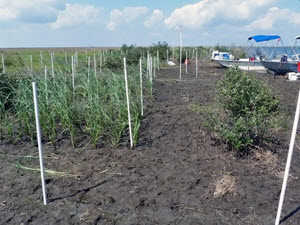
Restoration/remediation plots set up in a previously heavily oiled shoreline marsh along the northern Barataria Bay, Louisiana. (Photo provided by Qianxin Lin)
Marshes depend on a healthy, well-functioning complex of plants, microbes, and benthic communities to support the environmentally and economically important ecosystem services they offer, such as reducing storm surges and providing nursery grounds for many species. Researchers have been conducting studies assessing Louisiana marsh flora and fauna after the 2010 Deepwater Horizon oil spill and have identified factors influencing the plant-microbial-benthic complex’s function and long-term sustainability. Their work-to-date suggests that recovery is occurring but is not yet complete, highlighting the need for a much longer-term study to better quantify marsh recovery and resiliency.
The Gulf of Mexico Research Initiative recently awarded Dr. Qianxin Lin a grant to bring together marsh ecosystem researchers and build on their previous work. Specialists are collecting and analyzing samples of marsh plants, benthic organisms, and microbes and are synthesizing their observations to identify connections and influence on oiled marsh recovery. Their findings will help document long-term impacts on the coastal plant-microbial-benthic ecosystem and assess the recovery timeline. They are also evaluating the effectiveness of certain restoration and remediation strategies in promoting long-term sustainability in oil-affected marshes.
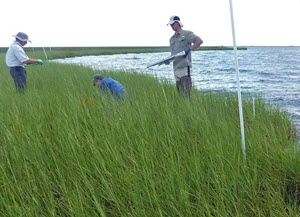
Sean Graham, Stefan Bourgoin, and Don Deis collect samples at a study site in northern Barataria Bay, Louisiana. (Photo provided by Qianxin Lin)
“Researchers are usually specialists who study just one of these components [plants, microbes, benthic communities] rather than all of them,” explained co-Principle Investigator John Fleeger. “We have a group of investigators who are working together to look at all of those parts, and we’re really getting the whole picture of how the marsh is responding.”
The researchers have been sampling the plant-microbial-benthic complex every six months for the last five and a half years. While their previous work focused on how the different components of the marsh responded to oil, they are now focusing on the long-term and larger picture of ecosystem recovery. Team members return to study sites and collect samples for each component of the study. Some will count the number of periwinkle snails, fiddler crab burrows, and aboveground plant stems present in the field and collect belowground root and rhizome samples. Others analyze soil samples using microscopes and DNA extractions to identify the functional microbial community. They are also testing soil shear strength to determine how stable it is and to make observations about oiling’s influence on the soil’s stability or erosion rate.
The team has already uncovered some of the plant-microbial-benthic connections they are seeking. For example, their work has shown that plants, such as the grass Spartina, and the densities of animals living in the sediment recovered at the same pace, suggesting that the recovery of sedimentary animals is closely correlated with plant recovery. Fleeger explained, “We have to make these connections thinking ‘What did the plant people find? What did the benthic people find? How can we look at those findings together and make connections within them?’ There’s no one big magic index that allows us to put all of the data in one big formula and crank out a number. We have to actually gauge how the different components are responding and then piece it together.”
The researchers plan to expand their work this summer to include field manipulative experiments that look closely at linkages they have identified, such as the relationship between plants and periwinkle snails. The team will investigate how strong these interactions are and how oil might tip the balance between the plants’ sustainability and the numbers of the snails eating them. They are also building on past experiments to evaluate the long-term effectiveness of restoration plantings and remediation with fertilizer. Initial assessments of the experiments have shown promising short-term results towards accelerating the pace of recovery and enhancing marsh stability. The team will continue experimenting with and evaluating combinations of planting and fertilizer to determine their viability as methods for enhancing long-term marsh recovery.
The project’s researchers are Qianxin Lin, John Fleeger, and Aixin Hou at Louisiana State University, Donald R. Deis at Atkins North America, Inc., and Sean Graham at Nicholls State University. Their project is Long-Term Impact, Recovery and Resilience: Wetland Plant-Microbial-Benthic Ecosystem Responses to the Deepwater Horizon Oil Spill and Mitigation Strategies Promoting Sustainability.
************
The Gulf of Mexico Research Initiative (GoMRI) is a 10-year independent research program established to study the effect, and the potential associated impact, of hydrocarbon releases on the environment and public health, as well as to develop improved spill mitigation, oil detection, characterization and remediation technologies. An independent and academic 20-member Research Board makes the funding and research direction decisions to ensure the intellectual quality, effectiveness and academic independence of the GoMRI research. All research data, findings and publications will be made publicly available. The program was established through a $500 million financial commitment from BP. For more information, visit http://gulfresearchinitiative.org/.
© Copyright 2010- 2017 Gulf of Mexico Research Initiative (GoMRI) – All Rights Reserved. Redistribution is encouraged with acknowledgement to the Gulf of Mexico Research Initiative (GoMRI). Please credit images and/or videos as done in each article. Questions? Contact web-content editor Nilde “Maggie” Dannreuther, Northern Gulf Institute, Mississippi State University (maggied@ngi.msstate.edu).
Lesson Plan: Marine Navigation Learning Module
 The module is the fourth in a series of marine environment-focused teaching and learning modules developed by the consortium for grades 6 – 12. This module focuses on navigating marine environments, particularly historical and current human navigation and animal navigation. The module is available for download here.
The module is the fourth in a series of marine environment-focused teaching and learning modules developed by the consortium for grades 6 – 12. This module focuses on navigating marine environments, particularly historical and current human navigation and animal navigation. The module is available for download here.
This module was developed by the DEEPEND (Deep-Pelagic Nekton Dynamics) Consortium and their consultants. Whenever possible, the lessons will focus specifically on events of the Gulf of Mexico or work from the DEEPEND scientists.
All modules in this series aim to engage students in grades 6 through 12 in STEM disciplines, while promoting student learning of the marine environment. We hope these lessons enable teachers to address student misconceptions and apprehensions regarding the unique organisms and properties of marine ecosystems. We intend for these modules to be a guide for teaching. Teachers are welcome to use the lessons in any order, use just portions of lessons, and may modify the lessons as they wish. Furthermore, educators may share these lessons with other school districts and teachers; however, please do not receive monetary gain for lessons in any of the modules.
You can view other modules here: http://outreach.deependconsortium.org/index.php/education/resources/lesson-plans
RFP-V Van Bael: Chemical Evolution & Degradation of Petroleum in Saline Marsh Plants & Soils
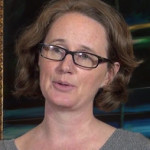
Dr. Sunshine Van Bael
The importance of bacteria for biodegradation of petroleum is well described for contaminated seawater and coastal soils, but very little is known about the role of symbiotic plant bacteria in degrading petroleum. Endophytes are bacteria and fungi that live as symbionts within plant roots, stems and leaves. These symbionts are closely associated with the plant and some endophyte species serve the dual purpose of promoting plant growth and degrading petroleum inside of plant tissues. In an extreme environment such as a salt marsh, where oxygen is limited in soils, plants may be especially dependent on endophytic bacteria for resilience to stress and to respond to petroleum contamination.
The overall goal of the proposed research is to develop a mechanistic understanding of plant bacterial symbioses in relation to petroleum/dispersant pollution in saline marshes. The proposed work will characterize the transport, fate and catabolic activities of bacterial communities in petroleum-polluted soils and within plant tissues. The project focuses on Spartina alterniflora (smooth cordgrass), the foundational grass species within salt marshes along Atlantic and Gulf coasts. The specific goals are (1) to use next-generation genomic technology for characterizing the taxonomy and function of microbial communities inside of S. alterniflora tissues and in the rhizosphere, while relating these communities to the chemical evolution of crude oil constituents in plant tissues and in soil; and (2) to use new visualization and computational modeling approaches for investigating the biomechanical and chemical influences on bacteria movement at the interface of roots and soil to mechanistically relate bacterial chemotaxis to the presence of petroleum, dispersant, oxygen and root exudates. The proposed research goals directly address GoMRI research theme two, as each ultimately relates plant-symbiont interactions to the chemical evolution and biodegradation of petroleum and dispersants in coastal ecosystems. Pursuing these goals will advance understanding of key processes that occurred in the DWH spill and may occur in future spills.
The outcomes of the proposed research will include (1) a deeper knowledge of the functional genomics of petroleum degradation and uptake of petroleum into plants, (2) the first descriptions and computational models for the biomechanical and chemical aspects of bacterial movement at the root: rhizosphere interface in response to petroleum and dispersant, and (3) the first determination of how plant-endophyte symbioses influence the fate of petroleum in marsh ecosystems. Developing a mechanistic understanding of plant-symbiont-petroleum interactions could provide a foundation for the development of remediation tools using naturally occurring plant-bacteria combinations. Such strategies are being developed in other ecosystems but have not yet been extended to include coastal plants in the Gulf of Mexico (GoM), where there is a persistently high threat of petroleum contamination.
This project was funded by the Gulf of Mexico Research Initiative (GoMRI) in the RFP-V funding program.
The Gulf of Mexico Research Initiative (GoMRI) is a 10-year independent research program established to study the effect, and the potential associated impact, of hydrocarbon releases on the environment and public health, as well as to develop improved spill mitigation, oil detection, characterization and remediation technologies. An independent and academic 20-member Research Board makes the funding and research direction decisions to ensure the intellectual quality, effectiveness and academic independence of the GoMRI research. All research data, findings and publications will be made publicly available. The program was established through a $500 million financial commitment from BP. For more information, visit http://gulfresearchinitiative.org/.
RFP-V Slack: Resilience Attributes for Children, Youth, and Communities in Deepwater Horizon
The Understanding Resilience Attributes for Children, Youth, and Communities in the Wake of the Deepwater Horizon Oil Spill project is lead by Tim Slack, Louisiana State University.
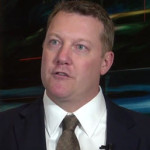
Dr. Tim Slack
This proposal outlines a research agenda to assess the public health impacts of the 2010 Deepwater Horizon (DH) oil spill in the Gulf of Mexico, with special emphasis on the impacts of the disaster on children and their families over time. The project will leverage face-to-face household interview data (N=692) collected by Columbia University’s National Center for Disaster Preparedness (NCDP) in 2014 on child and family health impacts in DH spill affected areas to build a three wave longitudinal data set with the 91% (N=629) of respondents who agreed to participate in subsequent follow up surveys.
Specifically, the proposed research asks the following research questions: Q1: What are the impacts of disaster-related trauma on children and families exposed to the 2010 DH oil spill, both in terms of physical and mental health effects as well as social consequences, such as increased risk behaviors, and decreased economic and educational opportunities? Q2: What is the relationship of primary and secondary stressors on these outcomes? Q3: What attributes of children and families are related to greater resilience to negative disaster-related impacts? Conversely, what attributes of children and families are related to greater vulnerability to negative impacts? Q3a: How does resilience/vulnerability vary across key sociodemographic groups, economic/occupational types (e.g., fishers and oil/gas workers), and families with different levels of social capital (e.g., social network structures and trust) or attachment to the social or natural environment? Q3b: What role do online social networks play in facilitating resilience? Q4: What sorts of issues are children confronting as a result of the oil spill and what sorts of measures do children, families, and community stakeholders see as being needed in response? Q5: How do all of the above change over time?
The ultimate goals of this research project are to: 1) Assess the public health and social impacts of the DH oil spill with a special focus on children and their families; 2) Identify attributes of children and families associated with resilience to negative disaster impacts and, conversely, attributes of children and families associated with vulnerability to negative disaster impacts; 3) Build a three wave panel dataset that allows for the assessment of within-unit change (i.e., children and their families) related to impacts, resilience, and vulnerability; 4) Train graduate students in disaster resilience research to help build the next generation of scholars dedicated to these issues; and 5) Make the information generated from this project actionable with the aim of helping facilitate disaster resilience and mitigate vulnerability.
This project was funded by the Gulf of Mexico Research Initiative (GoMRI) in the RFP-V funding program.
The Gulf of Mexico Research Initiative (GoMRI) is a 10-year independent research program established to study the effect, and the potential associated impact, of hydrocarbon releases on the environment and public health, as well as to develop improved spill mitigation, oil detection, characterization and remediation technologies. An independent and academic 20-member Research Board makes the funding and research direction decisions to ensure the intellectual quality, effectiveness and academic independence of the GoMRI research. All research data, findings and publications will be made publicly available. The program was established through a $500 million financial commitment from BP. For more information, visit http://gulfresearchinitiative.org/.
DEEPEND Infographic Poster Visualizes Vertical Migration
 Deep-sea investigators served as consultants for their partner Oregon Coast Aquarium’s educational infographic about diel vertical migration – the largest animal migration phenomenon on earth. The consortium has printed several copies of the poster to distribute to teachers as well as a large banner for use during outreach events.
Deep-sea investigators served as consultants for their partner Oregon Coast Aquarium’s educational infographic about diel vertical migration – the largest animal migration phenomenon on earth. The consortium has printed several copies of the poster to distribute to teachers as well as a large banner for use during outreach events.
RFP-V Kourafalou: Identifying the “Missing Link” Between River-Induced Fronts and Hydrocarbon Transport
Researcher Oscar Garcia-Pineda demonstrates some of the methods the team uses to collect imagery and samples of floating oil near MC20. (Provided by Villy Kourafalou)
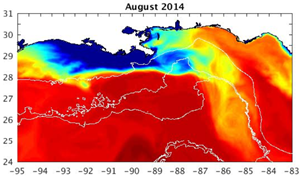
Imagery from the project’s high-resolution Gulf of Mexico model represents sea surface salinity distribution when Mississippi waters extended offshore toward the southern Gulf and interacted with the Loop Current (August 2014). (Provided by Villy Kourafalou)
The flow of the Mississippi River into the northern Gulf of Mexico may have caused circulation patterns and fronts that significantly influenced the transport and fate of Deepwater Horizon oil. However, the Gulf’s complex topography and the proximity of variable oceanic currents to the Mississippi Delta make it difficult to monitor and model these processes.
The Gulf of Mexico Research Initiative recently awarded Dr. Villy Kourafalou a grant to investigate and quantify how river-induced fronts and the circulation patterns they create affect hydrocarbon fate and transport in the presence of complex topography and oceanic circulation patterns, such as the Loop Current. The project seeks to improve the accuracy of hydrocarbon pathway predictions using novel satellite data analyses, field surveys, and data-guided high-resolution physical oceanography and oil spill simulations to target missing knowledge links, particularly oil spreading and thickness under different environmental conditions.
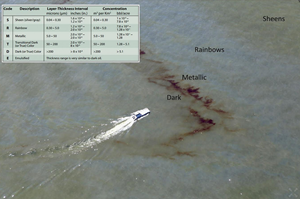
An ASTER satellite image of the project’s May 2016 field campaign and the sampling experiments that targeted areas of different thicknesses. Multiple oil thickness gradients are visible from thin rainbow-sheens to very thick dark-metallic areas of floating oil and emulsions. (Provided by Oscar Garcia-Pineda)
“We want to accommodate this specific oil parameter [oil thickness] that has been challenging to estimate and, therefore, largely missing in oil spill prediction,” said Kourafalou. “We plan to derive a methodology to measure oil spill spreading and thickness and perform comprehensive oil spill simulations that accommodate this additional information.”
The team uses photo-GPS reconnaissance air and boat surveys and optical sensor and synthetic aperture radar data collection to measure the thickness and optical signature of floating oil near a known active leak (Taylor Energy platform, MC20) in the Mississippi River Delta. They conduct their field work during different seasons, environmental conditions, and manifestations of the Mississippi River plume, including low- and high-discharge conditions and interactions with the Loop Current. The researchers will compare field survey measurement to the collected remote sensing data to refine existing algorithms, models, and maps of Deepwater Horizon footprint and surface oil thickness.
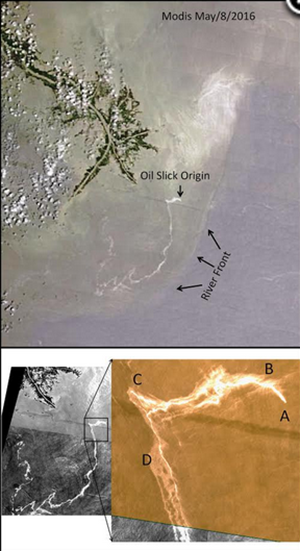
Satellite images based on MODIS (top) and ASTER (bottom) high-resolution satellite data collected May 8, 2016. (Provided by Chuanmin Hu and Oscar Garcia-Pineda)
The researchers will re-simulate Gulf of Mexico conditions from 2008-2017 using their high-resolution Gulf of Mexico Hybrid Coordinate Ocean Model (GoM-HYCOM), which includes mesoscale Gulf processes and fronts and filaments associated with the Mississippi River plume dynamics. These simulations will help the team carefully study the interactions between Mississippi River and Loop Current frontal dynamics and quantify their influence on hydrocarbon transport, particularly when the Loop Current exports Mississippi River waters southward.
Using their observations of oil thickness and spread, the team will initialize an oil spill simulation for the Deepwater Horizon incident period with more detailed oil slick properties and forcing data. After validating the simulation with satellite data products and available Deepwater Horizon data, the team will investigate how ocean currents and other features, especially river-induced fronts, influenced the surface spreading of Deepwater Horizon oil. Repeated simulations will examine the oil’s transport behavior under various environmental and circulation conditions.
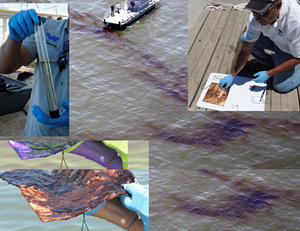
Researchers analyze and measure samples collected from the MC20 site to characterize oil thickness. (Provided by Oscar Garcia-Pineda)
The researchers believe that an improved understanding of coastal, shelf-break, and deep-sea interactions could have important implications for oil spill science and for resource management and disaster response. “Oil exploration often takes place off wetlands and rivers, where released hydrocarbons become subject to river-induced currents and fronts,” said Kourafalou. “Understanding how these factors influence oil pathways will help improve the predictions of oil spill models and guide response and recovery efforts.”
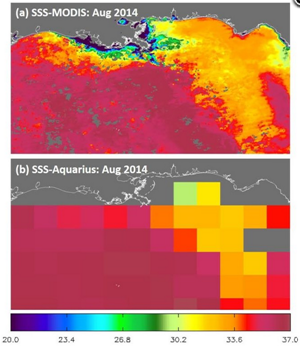
Imagery of sea surface salinity for a period when Mississippi waters extended offshore toward the southern Gulf of Mexico due to interactions with the Loop Current (August 2014). A special algorithm derived salinity from the ocean color MODIS satellite data (top), which provides substantially improved resolution of features compared to the available salinity imagery from Aquarius satellite data (bottom). (Provided by Chuanmin Hu)
The team is producing outreach products that engage both local coastal communities and the international science community, including middle-school science class materials designed to motivate student career paths in STEM fields and “science made easy” videos distributed through social media.
The project’s researchers are Villy Kourafalou at the University of Miami, Oscar Garcia-Pineda at Water Mapping, LLC, Lars Robert Hole at the Norwegian Meteorological Institute, and Chaunmin Hu at the University of South Florida. Their project is Influence of River-Induced Fronts on Hydrocarbon Transport.
************
The Gulf of Mexico Research Initiative (GoMRI) is a 10-year independent research program established to study the effect, and the potential associated impact, of hydrocarbon releases on the environment and public health, as well as to develop improved spill mitigation, oil detection, characterization and remediation technologies. An independent and academic 20-member Research Board makes the funding and research direction decisions to ensure the intellectual quality, effectiveness and academic independence of the GoMRI research. All research data, findings and publications will be made publicly available. The program was established through a $500 million financial commitment from BP. For more information, visit http://gulfresearchinitiative.org/.
Fact Sheet: Sea Grant Releases Brochure on Oil Spill’s Mental Health Impacts
The Sea Grant Oil Spill Outreach Team released a new informational brochure about how the Deepwater Horizon oil spill affected the mental health of some Gulf Coast residents. They reviewed published science and worked with experts to develop this brochure for a broad range of audiences, particularly those who live and work across the Gulf Coast.
The brochure The Deepwater Horizon oil spill’s impact on people’s health: Increases in stress and anxiety highlights impacts on individuals and coastal communities, which varied based on job type, community attachment, and previous disasters encountered.
The Sea Grant Team offers public seminars across the Gulf Coast. Click here to view upcoming science seminars and read about recently-held events. To receive email updates about seminars, publications, and the outreach team, click here.
************
GoMRI and the Sea Grant programs of the Gulf of Mexico (Florida, Mississippi-Alabama, Louisiana, and Texas) have partnered to create an oil spill science outreach program.
The Gulf of Mexico Research Initiative (GoMRI) is a 10-year independent research program established to study the effect, and the potential associated impact, of hydrocarbon releases on the environment and public health, as well as to develop improved spill mitigation, oil detection, characterization and remediation technologies. An independent and academic 20-member Research Board makes the funding and research direction decisions to ensure the intellectual quality, effectiveness and academic independence of the GoMRI research. All research data, findings and publications will be made publicly available. The program was established through a $500 million financial commitment from BP. For more information, visit http://gulfresearchinitiative.org/.
Video: C-IMAGE Releases Aerial Video of OneGulf Expedition
 Researchers studied fish and seafloor sediments across the southern, western and northern Gulf of Mexico. Their goals were to understand the lasting impacts of oil spills and to develop baseline levels in Gulf waters.
Researchers studied fish and seafloor sediments across the southern, western and northern Gulf of Mexico. Their goals were to understand the lasting impacts of oil spills and to develop baseline levels in Gulf waters.
This aerial footage shows a sample of the work our researchers perform while aboard the R/V Weatherbird II. These studies include using a sediment multicore, bottom longline fishing, and plankton tows (bongo nets).
This research was made possible by a grant from The Gulf of Mexico Research Initiative/C-IMAGE II.
Fact Sheet: ACER Blog Explains Mass Spectrometry
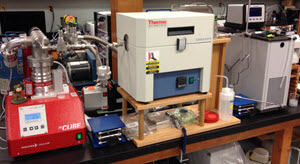
The mass spectrometer used to measure nitrogen compound in sediment samples to calculate denitrification rates. Photo credit: B. Mortazavi
The post explains that a mass spectrometer, or mass spec for short, has become an important tool in many aspects of science including genetics, biochemistry, pharmaceuticals, environmental science, geology and ecology. The mass spec is an instrument that tells us the masses of specific chemical elements in a sample. Briefly, a mass spec works by converting all of the chemical elements in a liquid, solid or gas sample to ions (‘ionizing’). The instrument then sorts or separates the ion based on their mass (specifically their mass to charge ratio) by applying a magnetic or electric field. A detector then records the specific ions present at specific times in the stream of ions.
An ion is a charged (positive or negative) molecule. A mass spec creates these charged particles by firing electrons at the sample until it all breaks apart. The ions are then shot into an electric or magnetic field. This field causes the ions of different charge to move to the detector at different rates from the chamber where the field is applied. Just as a lighter box is easier to shove than a heavier one, lighter ions are deflected more than heavier ones and reach the detector first.
For more educational entries from the ACER blog, head to the ACER Happenings page.
RFP-V Saul: Impact of Deepwater Horizon Oil Spill on Behaviors of Fishers in Gulf of Mexico
The Avoiding Surprises: understanding the impact of the Deepwater Horizon oil spill on the decision making behaviors of fishers and how this affects the assessment and management of commercially important fish species in the Gulf of Mexico using an agent-base project is lead by Steven Saul, Arizona State University.

Researcher Steven Saul
The Deepwater Horizon oil spill disrupted the livelihoods of many individuals living along the coast of the Gulf of Mexico, ranging from those in the tourism industry to those who fish the Gulf’s waters for a living. Many of those in the fishing industry, and the sectors that depend on it had to modify their operations (i.e. alter their fishing locations, target species, gear used, or trip duration) in the months after the spill due to spatial closures restricting access to potentially polluted waters. Some of the fishing effort during this time was redirected towards assisting with the cleanup efforts associated with the oil spill. This re-tasking had a direct effect on fishing catch and effort in 2010, and perhaps beyond, depending on whether behaviors that were modified due to the oil spill were maintained in the years ahead or if there was a return to the original behavioral patterns that existed before the incident.
To assess the status of commercially important fish stocks in the Gulf of Mexico, the National Marine Fisheries Service relies heavily on information on fish catch and fishing effort that is compulsorily provided by the fishing industry to the government. This information is used to estimate trends in fish abundance over time and serves as inputs to tune the fish population models that are used to establish fishing regulations, such as annual catch limits. At the present time, it is not well understood how the oil spill closures affected the catch of fish and the amount of time/effort fishers needed to use to catch those fish. As a result, it has been difficult for the National Marine Fisheries Service to use the 2010 year of data as a proxy for the trends in abundance that year due to the substantial behavior changes that occurred in the fishing fleet. A biased index of abundance could affect the abundance estimates and the estimated catch limit trajectories stock assessment models provide for future years, as recruitment in future years is dependent on the biomass available in previous years, which is in turn, affected by the fishing mortality that year. Such biases could result in socioeconomic losses to the fishing community by either triggering unnecessary reductions in catch, or conversely increases in catch under conditions where biomass is actually reduced.
To improve our understanding of these dynamics, the goal of this project is to develop a spatially explicit bioeonomic model of some the most important commercial fishery species and the fleets that harvest them in the Gulf of Mexico. The project continues the work initiated by the PI and his collaborators, whom have developed a spatially explicit model for the West Florida shelf that incorporates the behavior of four reef fish species (red grouper, gag grouper, red snapper and mutton snapper) and two commercial fishing fleets (handline and longline) (1). The new proposed model will extend the geographical scope of the current model to the entire US shelf of the Gulf of Mexico, will include additional species (brown shrimp, pink shrimp and menhaden) and two new fishing fleets (shrimp trawlers and menhaden purse seiners). Additionally the model will be modified to incorporate the direct effects of oil pollution on the survival of adult fish and shrimp and the reduction in recruitment caused by impacts of oil on spawner fitness and larval survival. In addition to understanding fleet dynamics, the model will also be used to evaluate long term responses of these populations to the disturbances caused by the oil pollution and by the imposition of fishing closures. Alternative responses to the spill will also be evaluated to understand the scope of the possible effects of different sizes of oil spills on the recovery of these populations.
Click for access to GoMRI’s YouTube videos of RFP-V Projects…
************
This project was funded by the Gulf of Mexico Research Initiative (GoMRI) in the RFP-V funding program.
The Gulf of Mexico Research Initiative (GoMRI) is a 10-year independent research program established to study the effect, and the potential associated impact, of hydrocarbon releases on the environment and public health, as well as to develop improved spill mitigation, oil detection, characterization and remediation technologies. An independent and academic 20-member Research Board makes the funding and research direction decisions to ensure the intellectual quality, effectiveness and academic independence of the GoMRI research. All research data, findings and publications will be made publicly available. The program was established through a $500 million financial commitment from BP. For more information, visit http://gulfresearchinitiative.org/.
RFP-V Smith: Investigating Louisiana Dolphins’ Reproductive Health After Deepwater Horizon
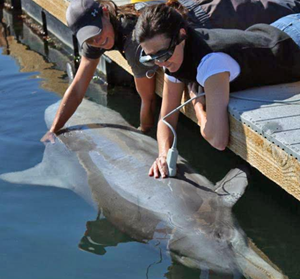
Megan Tormey (left) and Cynthia Smith (right) of NMMF conduct a voluntary ultrasound examination of a Navy dolphin in San Diego Bay, California, utilizing a heads-up video display (virtual reality glasses) to view the ultrasound image in real time. (Photo courtesy of U.S. Navy)
Concern about how the Deepwater Horizon oil spill may continue to negatively affect wild bottlenose dolphins living in the spill’s footprint remains high. Researchers supporting the Natural Resource Damage Assessment (NRDA) studied live and stranded dolphins in the heavily affected area of Louisiana’s Barataria Bay and reported that exposed dolphins exhibited increased lung disease, adrenal gland abnormalities, late-term pregnancy losses, and an 80% reproductive failure rate – four times greater than dolphins from unaffected areas. So how are the dolphins doing now?
The Gulf of Mexico Research Initiative recently awarded Dr. Cynthia Smith a grant to further investigate the dolphins’ reproductive impairment after the oil spill. Many stranded perinatal dolphins (perinates) in this region showed evidence of fetal distress and subsequent death in the womb and exhibited high reproductive failure rate. This project seeks to better understand how oil spill exposure impaired the reproductive health of this population through more precise physiologic measures and to assess how long these negative reproductive effects could last.
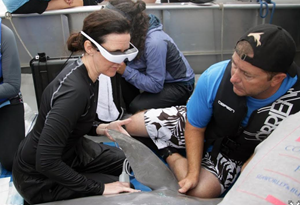
NMMF’s Cynthia Smith (left) and Randall Dear performing ultrasound on a bottlenose dolphin during a previous NOAA-led health assessment. (Photo by Todd Speakman, NOAA; NMFS permit #18786)
The project’s veterinary and research teams will care for dolphins from the Navy’s Marine Mammal Program that have documented health histories and receive ongoing assessments to develop advanced diagnostic techniques that will be applied to Barataria Bay dolphin capture-release field studies. The techniques will help identify fetal, placental, and maternal abnormalities potentially contributing to increased reproductive failure. The teams will use blood-based hormone testing for fetal and placental health evaluations and to assess potential mechanisms driving reproductive failure.

Dolphin Y01 pushing a dead calf in Barataria Bay, Louisiana, in March 2013.
(Photo by Louisiana Department of Wildlife and Fisheries)
Examinations of live, pregnant Barataria Bay dolphins and comparisons with documented Navy dolphin pregnancies will help establish current maternal health, pregnancy status, and fetal and placental health scores. The researchers will track the reproductive health of Barataria Bay dolphin mothers using boat-based monitoring. Parallel studies will evaluate dead adult and perinatal dolphins stranded during the study period for lesions and cause of death. The team will assess tissue samples from dead perinates for evidence of fetal distress, inflammation, and signs that a breath was taken outside of the womb. Then they will compare results with tissue analyses from historical Navy perinate losses to identify potential risk factors and predictors of late-term perinatal losses.
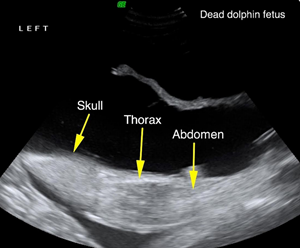
Ultrasound image of a dead dolphin fetus acquired by NMMF’s Cynthia Smith and Veronica Cendejas in Barataria Bay 2011 (NMFS permit #932-1905/MA-009526). (Provided by Cynthia Smith)
The project’s researchers believe that the development of advanced technologies and establishment of baseline reproductive health data will enhance the medical evaluation of Barataria Bay dolphins and advance diagnostic capacities for small cetaceans.
Smith elaborated, “This research will lend insight into the progression of disease states that are likely contributing to loss and inform our understanding of the potential timeline for recovery with regard to successful reproduction. Once we define why these animals are losing their babies, we can help determine the best way to develop strategies for their protection and recovery.”

Ultrasound image of a live dophin fetus acquired by NMMF’s Cynthia Smith and Veronica Cendejas in Barataria Bay 2011 (NMFS permit #932-1905/MA-009526). (Provided by Cynthia Smith)
This project’s researchers are Cynthia Smith, Lori Schwacke, and Stephanie Venn-Watson of the National Marine Mammal Foundation (NMMF) and Teri Rowles of the National Oceanic and Atmospheric Administration (NOAA). Their project is Investigation of Mechanisms for Reproductive Failure in the Aftermath of the Deepwater Horizon Oil Spill to Understand Population Recovery Scenarios for Cetaceans.
************
The Gulf of Mexico Research Initiative (GoMRI) is a 10-year independent research program established to study the effect, and the potential associated impact, of hydrocarbon releases on the environment and public health, as well as to develop improved spill mitigation, oil detection, characterization and remediation technologies. An independent and academic 20-member Research Board makes the funding and research direction decisions to ensure the intellectual quality, effectiveness and academic independence of the GoMRI research. All research data, findings and publications will be made publicly available. The program was established through a $500 million financial commitment from BP. For more information, visit http://gulfresearchinitiative.org/.
How Grad Student Cui Uses River Diversion Models to Inform Oil Spill Remediation

Linlin creates a movie of the Lagrangian particle tracking to determine the impacts of Davis Pond diversion on salinity gradients in the Barataria Bay. (Provided by Linlin Cui)
When oil from the Deepwater Horizon spill began approaching land, one proposed response was to divert Mississippi River water and sediment into the marshes to try and push surface oil more towards the Louisiana-Texas shelf. Linlin Cui is investigating the impacts of Mississippi River diversions on Barataria Bay hydrodynamics to help inform how future oil spill responders plan and execute freshwater diversions. Her research and its products provide tools for combating the loss of Louisiana’s coastal wetlands and for conserving and restoring healthy and productive ecosystems.
Linlin is a Ph.D. student in Louisiana State University’s (LSU) Oceanography and Coastal Sciences program and a GoMRI Scholar with CWC.
Her Path
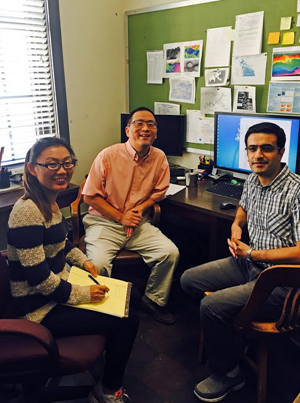
Linlin (left), Haosheng Huang (center), and Soroush Sorourian (right) discuss the research process in Huang’s office. (Provided by Linlin Cui)
Linlin grew up in a small fishing town near China’s Yellow Sea. Her childhood included fond memories of tasting new types of seafood and of fishermen selling fresh catches at the local seafood market. Most of China’s eastern coastal areas, including Linlin’s hometown, experienced rapid economic growth since the early 2000s. Booms in the manufacturing industry contributed to serious environmental issues, including coastal water pollution. Today, various fish species are decreasing in number and declining in health and size. “Many people in my small hometown do not know how to protect the coastal environment,” said Linlin. “Seeing all these heart-breaking changes made me wonder if I could do something about it.”
Linlin learned about numerical modeling during the senior year of her marine science undergraduate studies at Nanjing University of Information Science and Technology. Numerical modeling allows researchers to conduct studies using limited historical data and analyze their dynamic processes in accurate and quantitative ways. She studied numerical modeling more closely through Shanghai Ocean University’s fisheries research master’s program, where she independently developed an East China Sea mesoscale meteorological model that was used to investigate the passage of typhoon and enhanced air-sea fluxes. Fascinated by the great potential of numerical ocean models, she joined Dr. Haosheng Huang’s research group 2013 and began work on GoMRI-sponsored coastal ocean and estuarine dynamics studies.
Her Work
A major diversion is under development to push Mississippi River water and sediment into Barataria Bay to help restore coastal Louisiana wetlands affected by Deepwater Horizon oil. Linlin used the Finite Volume Community Ocean Model (FVCOM) to characterize how these diversions may impact Barataria Bay hydrodynamics, including salinity gradients and oil’s residence time in the Bay and adjacent continental shelf, and to predict possible oil slick transport trajectories for future events.

Linlin and her classmates collect data during an Estuarine Ecology course field trip to Grand Isle. (Provided by Wei Huang)
Linlin helped create and validate a high-resolution FVCOM hydrodynamic model grid for the Louisiana-Texas continental shelf with a horizontal resolution of 10 meters for Barataria Bay. The model uses coupled hydrodynamics-wave-sediment data to simulate oil-particle interactions, oil deposition and resuspension, and sediment erosion and transport in response to frontal and tropical disturbances. Her preliminary simulations showed that Davis Pond and mid-Barataria diversions decreased salinity in the lower Barataria Bay by as much as 5 parts per thousand and decreased oil residence times from 27 to 2 days. “Reduced salinity can cause significant reductions, displacements, or enhancements to fish and shellfish species based on their different tolerances and responses to salinity changes,” she explained.
Linlin’s modeling results can be used to help plan emergency response efforts to disasters such as oil spills. Policy-makers and resource managers can use the model to inform the planning and execution of water and sediment diversions, including identifying the ideal time to open diversions and the optimal volume of water.
Her Learning

Simulation depicting the Barataria Basin’s surface salinity and current fields after the opening of the Davis Pond diversion. The diversion is intended to push oil from the Gulf oil spill away from coastal wetlands. (Provided by Linlin Cui)
Linlin’s research experiences helped her grow as a scientist and as a member of the scientific community. Working with Dr. Huang, she learned about new meteorological and oceanic models that could be applied to her research. She also became more involved in the scientific community through her participation in conferences such as the Gulf of Mexico Oil Spill and Ecosystem Science Conference, the State of the Coast Conference, and the Estuarine and Coastal Modeling Conference and participation in weather research and forecasting model training sessions. She said, “All of the excellent feedback and suggestions from other experienced researchers that I received from these conference and training experiences have broadened my horizons and improved my research.”
Her Future
Linlin hopes to continue her research through a postdoc position in physical coastal ocean research. She recommended that students considering a science career should pursue a field that they truly love and accept failures when they happen, “Failure is a natural process and always part of scientific research – don’t give up easily.” She emphasized the importance of working closely with advisors and learning from their expertise and being involved in the science community.
Praise for Linlin
Dr. Huang highlighted Linlin’s capability and growing knowledge in her field, stating that she is well-versed in the tools required for her research and able to learn new software quickly and apply it. He noted her persistence and carefulness when conducting research, citing her numerical model’s triangular grid as an example. The grid’s construction took more than six months of diligent computer work, delineating characteristic water channel networks and wetlands and engineering structures based on Google Earth imagery and the LiDAR digital elevation model. She validated the model with observational data, but the grid still required adjustments and revisions. “The work is painstaking and requires great patience,” said Huang. “Linlin is determined and has gone through the process enthusiastically.”
Huang praised Linlin’s positivity and ability to work with other researchers, “Linlin is quite polite and friendly to the faculty, staff, and other graduate students in our department. She generously shares her working notes and experiences in high-performance computing and scientific visualization with other students in my group and with people in our university.”
The GoMRI community embraces bright and dedicated students like Linlin Cui and their important contributions. The GoMRI Scholars Program recognizes graduate students whose work focuses on GoMRI-funded projects and builds community for the next generation of ocean science professionals. Visit the CWC website to learn more about their work.
************
The Gulf of Mexico Research Initiative (GoMRI) is a 10-year independent research program established to study the effect, and the potential associated impact, of hydrocarbon releases on the environment and public health, as well as to develop improved spill mitigation, oil detection, characterization and remediation technologies. An independent and academic 20-member Research Board makes the funding and research direction decisions to ensure the intellectual quality, effectiveness and academic independence of the GoMRI research. All research data, findings and publications will be made publicly available. The program was established through a $500 million financial commitment from BP. For more information, visit http://gulfresearchinitiative.org/.
RFP-V Rodgers: Unraveling the Biotic and Abiotic Chemical Evolution of Macondo Oil
The The State-of-the-Art Unraveling of the Biotic and Abiotic Chemical Evolution of Macondo Oil: 2010-2018 project is lead by Ryan P. Rodgers, Florida State University.

Researcher Ryan P. Rodgers
Once released into the environment, petroleum undergoes physical processes that modify its native composition (water washing and evaporative losses) and chemical processes (largely oxidative, i.e. photo-oxidation and biodegradation) that we and others have shown results in an increase in oxygen-containing chemical functionalities of the predominately hydrocarbon matrix to ketone, hydroxyl, and carboxylic acid functionalities. Efforts to date have documented these weathering trends for Macondo well oil (MWO) from approx. 10 months post-spill to the present. It has been demonstrated that a pool of persistent oxidized petroleum-derived material increased with increasing weathering of MWO in the environment. However, not much is yet known about the molecular structure of the oxygenated transformation products, its environmental fate, or potential effects, as these oxidized products lie largely outside the conventional gas chromatography analytical window. However, there now exists technology to quantitatively track how the various oil-weathering processes (evaporative, water washing, photo-oxidation and biodegradation) change the petroleum composition at a molecular level. For example, it has been demonstrated that ultra-high resolution mass spectrometric analysis allows identification of 1000’s of oxidative weathering products.
This project aims to apply these techniques in order to understand how these weathering processes occur, to quantify rate(s) of oxygenated oil weathering product formation and degradation, and characterize toxicological effects on the ecosystem. More specifically, this project aims to answer the questions: (1) How does the molecular composition of MWO oil change over time? (2) Which compositional changes are caused by photo-oxidation? Biodegradation? How does the structural / chemical composition of the oil influence oxidation? (3) How does this compositional change influence toxicity of weathered MWO? (4) What is the overall fate of MWO on a time scale of 8 years?
This project will track the continued weathering of MWO and focus on early sampling dates (0-10 months) immediately after the spill, where a rapid formation of oxygenated products is hypothesized, as well as highly weathered samples (to be collected up to eight years after the spill). The proposed analytical methodologies will capture bulk and molecular level, biotic / abiotic temporal compositional changes in the MWO as it weathers in the environment. The efforts will generate a compositional database of the quantitative and qualitative weathering of MWO. Second, analysis of field samples will be combined with controlled laboratory experiments of MWO photo-oxidation and biodegradation. Third, MWO and other oils, their structurally defined fractions, and all weathering products for each, will be screened for toxicity (narcosis), and observed effects will be linked (correlated) to the molecular compositional change in MWO during weathering. Finally, since the structural dependence of weathering will captured herein, along with each fractions toxicity (and water soluble fractions), a simple model will be constructed based on the quantitative yields of each structural fraction, its associated weathering products, and rate of formation. Thus, simple quantitative fractionation of any future contaminant could potentially be used to predict the rate, mass, and type of weathering products formed. The model will be validated against field data collected from the Deepwater Horizon disaster and other recent oil spills.
Click for access to GoMRI’s YouTube videos of RFP-V Projects…
************
This project was funded by the Gulf of Mexico Research Initiative (GoMRI) in the RFP-V funding program.
The Gulf of Mexico Research Initiative (GoMRI) is a 10-year independent research program established to study the effect, and the potential associated impact, of hydrocarbon releases on the environment and public health, as well as to develop improved spill mitigation, oil detection, characterization and remediation technologies. An independent and academic 20-member Research Board makes the funding and research direction decisions to ensure the intellectual quality, effectiveness and academic independence of the GoMRI research. All research data, findings and publications will be made publicly available. The program was established through a $500 million financial commitment from BP. For more information, visit http://gulfresearchinitiative.org/.
How Grad Student Seubert Interprets Gulf of Mexico Resiliency Using Predator Diet
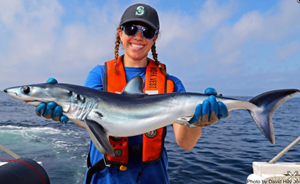
Emily displays a shortfin mako she and her team encountered while conducting longline surveys. (Provided by Emily Seubert)
Major environmental disturbances such as oil spills can alter a marine ecosystem’s structure and even cause species losses or additions in impacted areas – changes which may have long-term consequences for an ecosystem’s functions.
Emily Seubert investigates the diets of marine predators in the northern Gulf of Mexico food web to better understand how the Deepwater Horizon spill may have affected the Gulf’s functional diversity and resiliency. “It is our duty as residents of this planet to protect and care for it,” explained Emily. “The more we understand, the more knowledge we can spread to others and help protect our world.”
Emily is a marine science master’s student with the University of South Alabama and a GoMRI Scholar with the Alabama Center for Ecological Resilience (ACER).
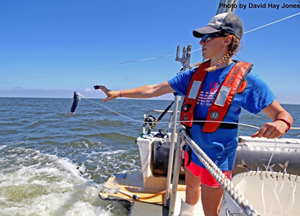
Emily throws out a baited gangion as she sets the bottom longline. (Provided by Emily Seubert)
Her Path
Emily spent the summers of her Seattle childhood exploring Puget Sound tide pools and being awestruck by orca whale pods that would surround her family’s boat. These experiences drove her desire to study marine science. Emily completed a bachelor’s degree in biological sciences at the University of California, Davis in 2013 and began a master’s degree in marine science at the University of South Alabama and the Dauphin Island Sea Lab in 2015. Her desire to learn more about ecosystem interactions and functions sparked her interest in joining her advisor Dr. Marcus Drymon to study effects of the Deepwater Horizon oil spill on species diversity and food web interactions.
Her Work
Functional diversity refers to an ecosystem’s particular biological processes, functions, and characteristics. Previous studies have suggested that the Deepwater Horizon spill reduced the abundance and diversity of consumers at various trophic levels in the Gulf food web, likely altering ecosystem function. Community-level changes documented post-spill showed elevated numbers of predator species compared to pre-spill observations, which could indicate a restructuring of the northern Gulf food web. Emily assesses stable isotope ratios in apex predators (top of the food chain) and mesopredators to investigate the post-spill food web and quantify functional groups, which will help her identify shifts in the system’s functional diversity.

Emily (left) uses a knife to peel back the skin of a bull shark so she can use a biopsy punch to extract a sample of white muscle tissue. (Provided by Emily Seubert)
Emily extracts blood and muscle tissue samples from predatory shark, ray, and fish species collected in waters around the Chandeleur Islands, Mississippi Sound, and Mobile Bay. She analyzes the samples for carbon, nitrogen, and sulfur stable isotope ratios. Emily explained that carbon 13 – the stable isotope of carbon – does not fractionate as it moves through the food web; therefore, carbon’s stable isotope ratio is useful for identifying the source of organic matter that fuels a food web. Similarly, sulfur does not fractionate and its stable isotope ratio can help differentiate between benthic and pelagic food webs. Unlike carbon and sulfur, nitrogen does fractionate with each change in trophic level, making it a useful indicator of trophic position. The combination of these three stable isotope ratios allows Emily to identify each sampled organism’s role in the food web and determine if its functional role overlaps with other organisms.
Emily uses this information to look at the ecosystem as a whole to determine what the area’s functional diversity indicates about its resiliency after an environmental disaster. She explained that having more functionally diverse species increases an ecosystem’s resiliency to disasters: “The more functionally diverse an ecosystem, the greater its resiliency and its potential to recover from a disturbance like an oil spill. Think about an ecosystem with only three roles or trophic niches to fill, and you’ve lost one in a disaster. That ecosystem would suffer a lot more from losing one species or niche than a more robust ecosystem with ten roles or trophic niches.”
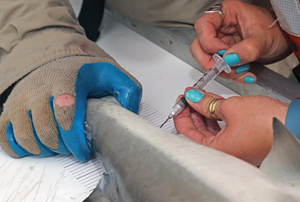
Emily uses a hypodermic needle to extract blood from the caudal vein of a blacktip shark. (Provided by Emily Seubert)
Understanding the resiliency and robustness of ecosystems can help inform recovery and restoration plans for future environmental disasters. Researchers and responders can use this information to determine which ecosystems are more vulnerable to environmental disasters and will therefore need more protection and better management. “If a disaster-affected ecosystem exhibited low numbers of apex predators and high numbers of mesopredators, we should manage our fishing pressures on those higher-level organisms,” explained Emily. “In that scenario, we can suspect that something is offsetting the balance, and relieving our fishing efforts on top predators may help bring the system back to equilibrium.”
Her Learning
Emily has found that, while the scientific process seems straightforward, learning how to juggle fieldwork, lab work, classes, presentations, and conferences can be challenging. Her ACER research provided her with valuable experience in planning, executing, and managing research and in clearly communicating her research and findings, helping her grow as a young scientist and professional. “The difference between where I started and where I am now is night and day,” said Emily. “I gain more confidence and knowledge with every obstacle and task I face. I know that I am growing as a scientist every day, surrounded by amazing mentors and a fantastic support team.”
Her Future
Emily plans to complete her master’s degree by the end of 2017 and find a position that allows her to travel and work in various labs around the country or even the world. She believes that working with different organisms, ecosystems, environments, and people can help her better understand our natural world. “As I have done throughout my career, I will continue to keep my eyes and ears open and to never stop learning,” she said.
Emily recommends that students interested in marine science should take chances and venture outside of their comfort zone. Her path took her far from home to an area she never anticipated and researching species she knew little about. However, she says she cannot imagine working with a better ecosystem, study species, or advisor for her master’s research, “I feel extremely lucky and blessed to be doing what I’m doing, and I never would be where I am if I hadn’t taken chances.”
Praise for Emily
Emily’s advisor Dr. Marcus Drymon said it has been a pleasure to work with Emily as she matures into a seasoned researcher. He praised her “palpable enthusiasm” for her research and her cheerful wit, calling her an integral part of his project. “I’m proud of the progress that Emily has made,” he said. “I see enormous potential for Emily’s work to contribute to a broader understanding of ecosystem resiliency.”
The GoMRI community embraces bright and dedicated students like Emily Seubert and their important contributions. The GoMRI Scholars Program recognizes graduate students whose work focuses on GoMRI-funded projects and builds community for the next generation of ocean science professionals. Visit the ACER website to learn more about their work.
************
The Gulf of Mexico Research Initiative (GoMRI) is a 10-year independent research program established to study the effect, and the potential associated impact, of hydrocarbon releases on the environment and public health, as well as to develop improved spill mitigation, oil detection, characterization and remediation technologies. An independent and academic 20-member Research Board makes the funding and research direction decisions to ensure the intellectual quality, effectiveness and academic independence of the GoMRI research. All research data, findings and publications will be made publicly available. The program was established through a $500 million financial commitment from BP. For more information, visit http://gulfresearchinitiative.org/.
Smithsonian Features Luminous Critters Living in the Deep, Dark Gulf

A close up profile of an adult anglerfish female from the Linophryne family collected in the northern Gulf of Mexico. © 2016 DEEPEND/ Dante Fenolio
Scientists are finding fascinating discoveries in the largely unknown deep waters of the Gulf of Mexico.
Some fishes, invertebrates, and bacteria have evolved a special adaptation to living in dark conditions using bioluminescence. What’s new is the discovery of specific bacteria species that live symbiotically on anglerfish and emit light.
The Smithsonian recently published an article about these anglerfish and bacteria based on research funded by the Gulf of Mexico Research Initiative (GoMRI). Scientists with the DEEPEND consortium comb through mountains of marine samples and microbial DNA sequence data to help us better understand risks when events like the Deepwater Horizon strike.
Read the article Meet the Tiny Bacteria That Give Anglerfishes Their Spooky Glow to find out how fish who don’t produce their own light pair up with bacterium that do.
************
GoMRI and the Smithsonian have a partnership to enhance oil spill science content on the Ocean Portal website.
This research was made possible in part by a grant from BP/The Gulf of Mexico Research Initiative (GoMRI) to the Deep-Pelagic Nekton Dynamics of the Gulf of Mexico (DEEPEND) consortium. The GoMRI is a 10-year independent research program established to study the effect, and the potential associated impact, of hydrocarbon releases on the environment and public health, as well as to develop improved spill mitigation, oil detection, characterization and remediation technologies. An independent and academic 20-member Research Board makes the funding and research direction decisions to ensure the intellectual quality, effectiveness and academic independence of the GoMRI research. All research data, findings and publications will be made publicly available. The program was established through a $500 million financial commitment from BP. For more information, visit http://gulfresearchinitiative.org/.
RFP-V Smith: Reproductive Failure in Deepwater Horizon Oil Spill and Recovery of Cetaceans

Researcher Cynthia Smith
Concern about how the Deepwater Horizon oil spill may continue to negatively affect wild bottlenose dolphins living in the spill’s footprint remains high. Researchers supporting the Natural Resource Damage Assessment (NRDA) studied live and stranded dolphins in the heavily affected area of Louisiana’s Barataria Bay and reported that exposed dolphins exhibited increased lung disease, adrenal gland abnormalities, late-term pregnancy losses, and an 80% reproductive failure rate – four times greater than dolphins from unaffected areas. So how are the dolphins doing now?
The Gulf of Mexico Research Initiative recently awarded Dr. Cynthia Smith a grant to further investigate the dolphins’ reproductive impairment after the oil spill. Many stranded perinatal dolphins (perinates) in this region showed evidence of fetal distress and subsequent death in the womb and exhibited high reproductive failure rate. This project seeks to better understand how oil spill exposure impaired the reproductive health of this population through more precise physiologic measures and to assess how long these negative reproductive effects could last.
Click for access to GoMRI’s YouTube videos of RFP-V Projects…
************
This project was funded by the Gulf of Mexico Research Initiative (GoMRI) in the RFP-V funding program.
The Gulf of Mexico Research Initiative (GoMRI) is a 10-year independent research program established to study the effect, and the potential associated impact, of hydrocarbon releases on the environment and public health, as well as to develop improved spill mitigation, oil detection, characterization and remediation technologies. An independent and academic 20-member Research Board makes the funding and research direction decisions to ensure the intellectual quality, effectiveness and academic independence of the GoMRI research. All research data, findings and publications will be made publicly available. The program was established through a $500 million financial commitment from BP. For more information, visit http://gulfresearchinitiative.org/.
Podcast: DEEPEND’s Tamara Frank Discusses Research and Struggles Entering Marine Biology Field
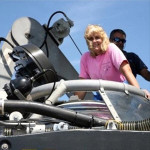
Dr. Tamara Frank
Dr. Frank works with the consortium’s crustacean team studying creatures such as crabs, lobsters, shrimp, and krill. She speaks about her research and shares why getting a job as an aspiring female scientist was very challenging.
RFP-V Miller: Identifying Toxic Components in Fresh and Weathered Crude Oil

Ph.D. student Rebecca Lichtler prepares hydrocarbon solutions for toxicity studies in cultured cells. (Photo by Charles Miller)
Hydrocarbons associated with oil spills can have harmful effects on humans and organisms, yet little is known about the specific compounds that contribute to toxicity. The ability to identify and quantify oil’s key toxic compounds will help improve predictions of future spills’ effects on human health and marine ecosystems.
The Gulf of Mexico Research Initiative recently awarded Dr. Charles Miller a grant to identify toxic compounds within fresh and weathered Deepwater Horizon crude oil. Miller’s team hypothesizes that a relatively small group of chemicals accounts for most of oil’s toxicity and hopes to identify these oil compounds that are crucial to understanding toxicity.
Oils from different sites and sources vary in composition and toxicity, and oil components change radically with time and weathering. There are sixteen polycyclic aromatic hydrocarbon (PAH) compounds that the Environmental Protection Agency has identified as reference compounds for use in environmental studies. Researchers will explore oil compounds not included in the sixteen reference PAHs to expand our knowledge about the toxicity of these less-studied oil compounds.
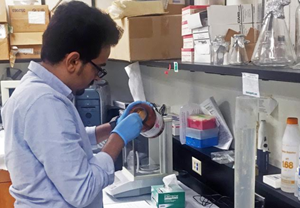
Ph.D. student Ahmad Alqassim prepares a chemical solution for cellar analysis. (Photo by Charles Miller)
“There are oil compounds that are more prevalent and complex than the sixteen reference compounds, but they have been studied either very little or not at all,” said Miller. “There are thousands of chemicals in oil that we have no toxicity data for at all – we don’t know what they do.”
Miller’s team will conduct genetic assays to identify oil compounds that activate the aryl hydrocarbon receptor (AhR), a protein in all human cells that can signal the expression of genes related to serious adverse health effects, including cancer. They will separate crude oil samples into fractions that will each be combined with human stem cells to identify those that activate the AhR. The researchers will then refractionate the identified fractions into smaller groups of chemicals and run them through the assay again. They will repeat this process to isolate individual compounds responsible for oil toxicity.
Miller hopes this research will provide important guidance into which oil compounds should be assessed in order to gauge a spill’s toxicity. “Some spills are more toxic than others, and we don’t always know why that is,” he said. “If we knew which chemicals to watch for, it could help estimate how toxic a spill may be.” Tracking these toxic compounds during future spills will help researchers and responders better understand the severity and persistence of the potential risks associated with oil contamination.
This project’s researchers are Charles Miller, Jeffery Wickliffe, and Mark Wilson of the Tulane University School of Public Health and Tropical Medicine and Edward Overton of the Louisiana State University Department of Environmental Sciences. Their project is Toxicological Properties of Specific Aromatic Hydrocarbons Isolated from Fresh and Aged Crude Oil from the Deepwater Horizon Spill.
************
The Gulf of Mexico Research Initiative (GoMRI) is a 10-year independent research program established to study the effect, and the potential associated impact, of hydrocarbon releases on the environment and public health, as well as to develop improved spill mitigation, oil detection, characterization and remediation technologies. An independent and academic 20-member Research Board makes the funding and research direction decisions to ensure the intellectual quality, effectiveness and academic independence of the GoMRI research. All research data, findings and publications will be made publicly available. The program was established through a $500 million financial commitment from BP. For more information, visit http://gulfresearchinitiative.org/.
Video: DROPPS Researcher Delivers Televised Talk on Oil Degradation
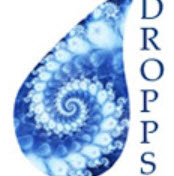 In April 20, 2010, the Gulf of Mexico had its greatest mishap in record time with the Deepwater Horizon oil spill, wherein an estimated 1,000 barrels of oil (peaking at more 60,000 barrels) per day were released into the Gulf for 87 days, for a total of 3.19 million barrels for the entire duration. The ecological impacts of this spill have become one of the subjects of extensive research.
In April 20, 2010, the Gulf of Mexico had its greatest mishap in record time with the Deepwater Horizon oil spill, wherein an estimated 1,000 barrels of oil (peaking at more 60,000 barrels) per day were released into the Gulf for 87 days, for a total of 3.19 million barrels for the entire duration. The ecological impacts of this spill have become one of the subjects of extensive research.
Dr. Hernando Bacosa is a postdoctoral fellow at the University of Texas at Austin. His lecture at Del Mar College, “Biodegradation and Photooxidation of Spilled Oil in Northern Gulf of Mexico,” presented some recent findings about the Deepwater Horizon oil spill’s ecological impacts and was televised on Channel 19 Spectrum Cable and Grande Cable in Corpus Christi.
RFP-V Thomas: Genomic Responses to Deepwater Horizon and High-Throughput Biological Assays
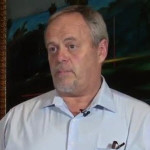
Researcher W. Kelley Thomas
The Genomic Responses to the Deepwater Horizon event and development of high-throughput biological assays for oil spills project is lead by W. Kelley Thomas, University of New Hampshire.
Within the GoM, the benthic environment is biologically hyper-diverse, performing critical ecosystem functions that have consequences for the ecology of the entire GoM region. Benthic communities are strongly impacted by oil spills, which render them a valuable tool for assaying and monitoring the impacts of contamination. However, the characterization of these communities has been impractical for large- scale deployment due to the tedious and time-consuming nature of the taxonomy required to accurately describe these communities. This project leverages recent and dramatic advances in DNA sequencing technology that have transformed the process of rapid, accurate, and cheap assays of community biodiversity. To achieve these goals, the project team brings together the interdisciplinary expertise in marine biology, taxonomy, genomics and bioinformatics necessary for the development of a meaningful and robust technology and has formulated three objectives.
Objective 1: Use targeted sequencing of individual benthic eukaryotes to generate a representative sample of diverse genomes from which to select an expanded set of nuclear and mitochondrial loci for targeted mining of shotgun metagenomic data.
Objective 2: Assess eukaryotic community structure across space and time via high-throughput sequencing of environmental metagenomes using a new and expanded array of nuclear and mitochondrial marker genes.
Objective 3: Establish Standard Operating Procedures (SOPs) and reproducible bioinformatic workflows for environmental monitoring of oil spills. This will include establishing a database for integration of taxonomic and molecular datasets, and dissemination of tools and educational resources.
Click for access to GoMRI’s YouTube videos of RFP-V Projects…
************
This project was funded by the Gulf of Mexico Research Initiative (GoMRI) in the RFP-V funding program.
The Gulf of Mexico Research Initiative (GoMRI) is a 10-year independent research program established to study the effect, and the potential associated impact, of hydrocarbon releases on the environment and public health, as well as to develop improved spill mitigation, oil detection, characterization and remediation technologies. An independent and academic 20-member Research Board makes the funding and research direction decisions to ensure the intellectual quality, effectiveness and academic independence of the GoMRI research. All research data, findings and publications will be made publicly available. The program was established through a $500 million financial commitment from BP. For more information, visit http://gulfresearchinitiative.org/.
Grad Student Pasparakis Looks to Fish Embryos for Long-Term Oil Spill Answers

Christina analyzes different life stages of mahi-mahi embryos under a stereomicroscope. (Photo by Dan DiNicola)
Studies that investigate the effects of oil exposure on developing fish are typically conducted at otherwise non-stressful ambient conditions, which may result in conservative impact estimates. Christina Pasparakis is studying the combined effects of oil exposure and other environmental stressors to create a more comprehensive assessment of Deepwater Horizon impacts.
Christina is a marine science Ph.D. student at the University of Miami and a GoMRI Scholar with the RECOVER consortium.
Her Path
Christina grew up on Key Biscayne, a south Florida island, where she developed a deep appreciation for the ocean and marine life. She was five years old when Hurricane Andrew devastated south Florida, including Key Biscayne’s once-flourishing Bill Baggs Cape Florida State Park. A few years later, however, salt marshes and mangrove ecosystems brimming with new forms of marine life had replaced the invasive Australian Pines that once dominated the park. “Watching the island regenerate after such a profound natural disaster, I learned a valuable lesson: nature is, in fact, remarkably resilient,” she explained. “It solidified my interest in studying nature and its incredible ability to adapt to changing conditions.”
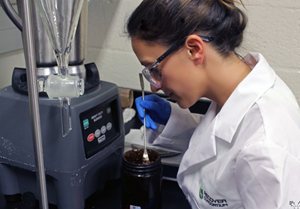
Christina makes a high-energy water-accommodated fraction (HEWAF) from surface oil. These WAF dilutions will be used in exposure experiments with embryonic mahi-mahi. (Photo by Dan DiNicola)
As Christina completed her biology master’s degree at San Francisco State University in 2013 and entered the University of Miami’s Ph.D. program in marine science, news about the Deepwater Horizon oil spill deeply saddened her. She became increasingly concerned as the spill’s ecological severity grew over time. When her advisor Dr. Martin Grosell started a multi-year oil spill research project in 2015, which continued his Natural Resources Damage Assessment oil-impact studies, Christina began researching oil’s effects on the developing Gulf fish whose spawning period temporally and geographically overlapped with the Deepwater Horizon event.
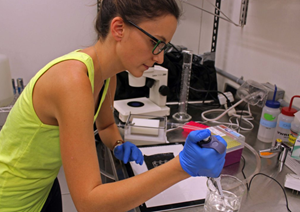
Christina hydrates a microplate used for high-throughput oxygen consumption data in small organisms, such as embryos and larvae. (Photo by Dan DiNicola)
Her Work
Recent studies suggest that oil toxicity may cause cardiovascular and morphological abnormalities in the embryonic and larval stages of developing fish. These sublethal effects of oil exposure may have subtle, yet ecologically significant, long-term consequences on entire fish populations. Christina is currently focused on understanding factors that affect developing embryos’ buoyancy, a critical aspect of their survival that helps promote dispersal and positioning of hatched larvae in the food-laden upper water column.
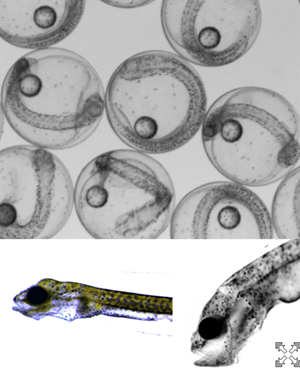
Stereomicroscope images of early life stage mahi-mahi at different developmental periods. The embryos (top) are 2 days post-fertilization and a few hours away from hatch, while the larvae (bottom left and right) are 2-3 days post-hatch. (Image by Christina Pasparakis)
Christina conducts exposure experiments on mahi-mahi at early developmental life stages using varying concentrations and types of oil (such as surface oil or source oil) and different environmental stressors, such as UV radiation, temperature, and salinity. She then quantifies changes in embryonic buoyancy over time, measures their sinking rate and nitrogenous waste excretion, and uses optical and imaging systems to assess oxygen consumption, cardiac function, and overall development. “All of these variables have significant implications for fish survival and growth to later life-stages,” explained Christina. “For example, embryos sinking down the water column earlier in development could place them in unfavorable conditions for hatching and post-hatch feeding and may increase predation risk.”
So far, Christina’s research has found that larvae who were exposed to oil as embryos displayed increased oxygen consumption rates, indicating elevated metabolic rates and the potential for corresponding increases in energy depletion. She observed depletions in embryonic mahi-mahi yolk sacs, the sole energy substrates for most developing fish embryos, which confirmed the projected energy depletion. Her results are the first to demonstrate increased energy demand and energy depletion in oil-exposed fish embryos and larvae.
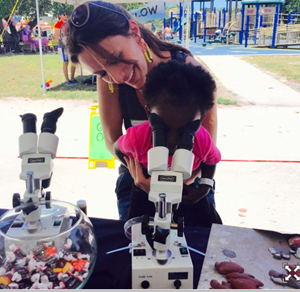
Christina at the University of Miami-sponsored Ocean Kid’s Day, a program that invites children from low-performing, high-needs elementary schools to participate in a day of marine science adventures. Here, she shows a young girl how early life stages of live mahi-mahi look under a microscope. (Photo by Elena Papademetriou)
Her Learning
Christina’s Ph.D. research has taught her the importance of creating a strong foundation of knowledge and expertise before jumping into an experiment. Troubleshooting the oxygen-sensing system she used to measure oxygen consumption was a long, tedious, and often frustrating process that did not produce any useable results. Reflecting on that process today, however, she has a much different perspective. “Those months of troubleshooting and method development were arguably some of the most valuable and character building experiences of my Ph.D.,” she explained. “It helped me test my boundaries and taught me that creativity and improvisation are critical skills in science.”
Christina believes in the importance of investing in future scientists. She initially found training and supervising undergraduate volunteers in the Grosell lab especially challenging and asked for a different lab duty. However, Grosell insisted that a person can only excel by improving on their weaknesses and assigned her even more undergraduates – it was ultimately one of the most fulfilling aspects of her Ph.D. “I learned how to be simultaneously critical and motivating and became a much more qualified mentor and teacher,” she said. “Watching my current undergraduate volunteer grow as a scientist and conduct experiments alone has been very rewarding and has solidified my passion to teach in the future.”
Participation in outreach activities with local students through the University of Miami’s Rosenstiel School of Marine and Atmospheric Science has been an important part of Christina’s growth. She volunteered with Ocean Kids, a University of Miami-sponsored program that introduces at-risk grade school students to science. She also helped with Women in Science Day to inspire young girls to pursue scientific careers. “My volunteer activities provided an effective way to motivate younger generations to care about the sustainability and preservation of our ocean and fisheries,” said Christina. “I believe spreading knowledge about the destructive consequences of environmental catastrophes such as the Deepwater Horizon oil spill will help prevent these disasters from happening in the future and better prepare us for when they do occur.”
Her Future
Christina wants a career that will allow her to study, learn, and teach about oceans and their ability to adapt and recover during periods of rapid environmental change. She hopes to continue spreading awareness about the current state of marine ecosystems and how global climate change, increased pollution, and environmental disasters risk oceans’ sustainability and diverse marine life. “Motivation requires optimism,” she concluded. “Despite recent studies displaying dire projections for the future, we must find a way to focus on the positive and believe in the resilience of nature.”
Praise for Christina
Dr. Grosell noted that, in addition to pursuing her own research, Christina plays a central role in numerous collaborative projects with visiting scientists and University of Miami colleagues. “The ability to develop equipment and techniques for sophisticated measurements is a hallmark of an outstanding Ph.D. student. In Christina, these skills are combined with strong writing skills, and she consistently connects well with broad audiences,” said Grosell. “I view Christina as an exceptionally strong young scientist with immense potential.”
The GoMRI community embraces bright and dedicated students like Christina Pasparakis and their important contributions. The GoMRI Scholars Program recognizes graduate students whose work focuses on GoMRI-funded projects and builds community for the next generation of ocean science professionals. Visit the RECOVER website to learn more about their work.
************
The Gulf of Mexico Research Initiative (GoMRI) is a 10-year independent research program established to study the effect, and the potential associated impact, of hydrocarbon releases on the environment and public health, as well as to develop improved spill mitigation, oil detection, characterization and remediation technologies. An independent and academic 20-member Research Board makes the funding and research direction decisions to ensure the intellectual quality, effectiveness and academic independence of the GoMRI research. All research data, findings and publications will be made publicly available. The program was established through a $500 million financial commitment from BP. For more information, visit http://gulfresearchinitiative.org/.
Sea Grant Releases Brochure on Oil Spill and Fish Lesions
The Sea Grant Oil Spill Outreach Team released a new informational brochure about the connection of Deepwater Horizon and fish lesions reported in the winter following the spill. The team reviewed published science and worked with experts to develop this brochure for a broad range of audiences, particularly those who live and work across the Gulf Coast.
The brochure Skin Lesions in Fish: Was There a Connection to the Deepwater Horizon Oil Spill? explains what fish skin lesions are, what factors might cause lesions, and what fish lesion data can tell us about the oil spill.
The Sea Grant Oil Spill Outreach Team offers public seminars across the Gulf Coast. Click here to view upcoming science seminars and read about recently-held events. To receive email updates about seminars, publications, and the outreach team, click here.
************
GoMRI and the Sea Grant programs of the Gulf of Mexico (Florida, Mississippi-Alabama, Louisiana, and Texas) have partnered to create an oil spill science outreach program.
The Gulf of Mexico Research Initiative (GoMRI) is a 10-year independent research program established to study the effect, and the potential associated impact, of hydrocarbon releases on the environment and public health, as well as to develop improved spill mitigation, oil detection, characterization and remediation technologies. An independent and academic 20-member Research Board makes the funding and research direction decisions to ensure the intellectual quality, effectiveness and academic independence of the GoMRI research. All research data, findings and publications will be made publicly available. The program was established through a $500 million financial commitment from BP. For more information, visit http://gulfresearchinitiative.org/.
Grad Student Fiore Investigates Oil Spill Impacts on Gulf Economy and Fisheries Resiliency
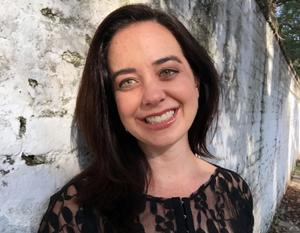
Jacqueline Fiore is an economic analysis and policy Ph.D. student at Tulane University. (Provided by Jacqueline Fiore)
Natural and manmade disasters often involve long-term effects, but the majority of follow-up research tends to focus on the biophysical impacts rather than the social. Jacqueline Fiore, a Louisiana resident, understands how disasters such as hurricanes and oil spills can impact local industries, citizens, and ecosystems.
Jacqueline, a Ph.D. student in Tulane University’s Economic Analysis and Policy program and a GoMRI Scholar with the Consortium for Resilient Gulf Communities (CRGC), uses applied economics to study the Deepwater Horizon oil spill’s socioeconomic impacts on Gulf fisheries, assess their ability to recover, and help inform future oil spill response.
Her Path
Jacqueline’s journey into oil spill research began on the other side of the globe after she completed a bachelor’s degree in communications and two master’s degrees in epidemiology and economics. She worked for Michigan State University conducting epidemiological studies on malaria in Malawi, Africa with the National Institutes of Health Malawi International Center for Excellence in Malaria Research program. While she enjoyed this research, Jacqueline felt that she was still searching for her “niche” and realized that she wanted to learn econometric methods for public health research.
Jacqueline entered Tulane University’s Ph.D. program in economic analysis and policy. Her advisor Dr. K. Brent Venable introduced her to the CRGC studies on Gulf communities’ resilience to large-scale environmental disasters such as the 2010 Deepwater Horizon oil spill. Jacqueline joined the project’s economics sub-team with her other two advisors RAND Corporation economists Drs. Craig Bond and Shanthi Nataraj and uses economic analysis to study the oil spill’s impact on the fishing industry.
Her Work
Jacqueline explained that the concept of resilience refers to human communities’ ability to respond, reorganize, and recover during and following a damaging event. She continued, “The dynamics of certain indicators, such as fisheries landings and revenues, can provide information about the abilities of fisheries to withstand and recover from oil spill events.”
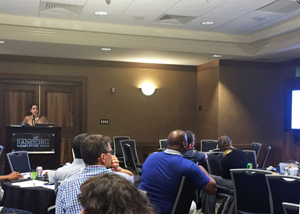
Jacqueline presents her preliminary findings at the CRGC All-Hands Meeting in Mobile, Alabama, in June 2016. (Photo by Elizabeth Thornton of RAND Corporation)
Jacqueline contacted approximately 70 fisheries and tourism representatives for insight into the best data sources for her research and identified National Oceanic and Atmospheric Association (NOAA) commercial fishing data and state-maintained trip ticket datasets as the most comprehensive sources for pre- and post-spill data. She then worked with the CRGC economics sub-team to identify the best model specifications for analysis. She plans to combine these specifications with public- and restricted-access data to assess the spill’s effects on fisheries landings for select Gulf fish species.
Jacqueline’s research will quantify impacts to fisheries landings in pounds and revenues over time, accounting for variables such as number of fishing trips, type of gear used, and total area fished. She will complement anecdotal accounts and time-series data with an econometric assessment to place the spill’s economic impacts in context with the impacts of the 2005 hurricane season. Ultimately, Jacqueline hopes that her findings will help the fisheries industry and associated communities prepare for the way various Gulf fish species and fishers may respond to future disasters.
Her Learning
Jacqueline discovered that the research process can be challenging, particularly when working with human-related data. She recalls learning about and adhering to data confidentiality rules when using government datasets, adjusting her economic models to match each data source’s availability and variables, and even reframing how she communicated her findings to various audiences. For example, she adapted presentations of her preliminary results at CRGC All-Hands Meetings to better suit an audience without an economics background. Rather than focusing on her work’s detailed methods and techniques, which the audience would not be familiar with, she focused on graphs that illustrated trends in her findings.
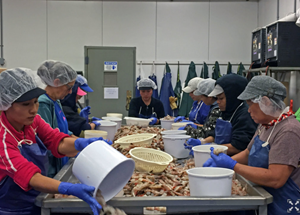
Dominik’s Seafood Inc. – a shrimp processing plant in Bayou La Batre, Alabama – is one of the many local Gulf-area businesses that could benefit from Jacqueline’s research with the economics sub-team. (Photo by Jacqueline Fiore)
Jacqueline also experienced how her research can impact and be impacted by a wide range of people. CRGC All Hands Meetings are attended by the consortium’s technical and stake holder advisory committees, principal investigators, research staff, and graduate students, allowing Jacqueline to gain valuable feedback about her findings from a diverse audience. Fellow researchers offered insights into why some fish species may have been more affected after the spill than others and theorized how fisheries closures might cause some fish species to appear more resilient than they may actually be. She also met with Deepwater Horizon-impacted community members and observed seafood processing plants on a field trip to Bayou La Batre, Alabama. The plant’s employees may use her results to identify which fish species may be the most affected and to estimate financial impacts should another disaster occur.
Her Future
Jacqueline plans to complete her Ph.D. in spring 2018 and hopes to pursue a research program or program management position where she can use her training and expertise in economics and epidemiology. She is particularly interested in industry- or government-initiated projects that are implemented in an academic or private sector, because she “enjoys multidisciplinary collaboration, quick turnaround, and the ability to measure her findings’ impact on the target audience.”
She has found that a person’s career path can evolve based on interactions with others, job opportunities, and academic training and advises that students take time for self-reflection on their life experiences. “Try to learn something from each opportunity and challenge you encounter,” she said. “Your initial goals may look much different from the final outcome.”
Praise for Jacqueline
Craig Bond and Shanthi Nataraj praised Jacqueline’s enthusiasm and contributions to their work. “She not only does what would be expected of a research assistant – conducting literature reviews and data analyses – she also goes above and beyond and contributes to the intellectual design of the effort. Perhaps as importantly, she always does so with a smile,” said Bond. They explained that Jacqueline is considered a full partner on the research, “She has become a valuable colleague over the past two years, and we look forward to our continued collaboration.”
The GoMRI community embraces bright and dedicated students like Jacqueline Fiore and their important contributions. The GoMRI Scholars Program recognizes graduate students whose work focuses on GoMRI-funded projects and builds community for the next generation of ocean science professionals. Visit the CRGC website to learn more about their work.
************
The Gulf of Mexico Research Initiative (GoMRI) is a 10-year independent research program established to study the effect, and the potential associated impact, of hydrocarbon releases on the environment and public health, as well as to develop improved spill mitigation, oil detection, characterization and remediation technologies. An independent and academic 20-member Research Board makes the funding and research direction decisions to ensure the intellectual quality, effectiveness and academic independence of the GoMRI research. All research data, findings and publications will be made publicly available. The program was established through a $500 million financial commitment from BP. For more information, visit http://gulfresearchinitiative.org/.
OneGulf Voyage Gathers Unprecedented Marine Samples for Two Oil Spills
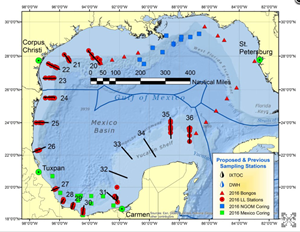
The cruise map of the One Gulf Expedition shows the 69 long-line stations (red circles) completed in 40 days. Researchers caught over 2,400 fish to study the impacts of Gulf oil spills. (Credit: C-IMAGE Consortium)
An international science team recently completed a 4,000-mile expedition to learn more about the long-term fate of two of the world’s largest subsea oil spills, the 1979 Ixtoc-I and the 2010 Deepwater Horizon. The 40-day Gulf of Mexico voyage continued their 2015 field campaign, contributing to a multi-year Gulf-wide analysis of these oil spills and the marine environment’s response and recovery.
Aboard the R/V Weatherbird-II, researchers with the Center for the Integrated Modeling and Analysis of Gulf Ecosystems II (C-IMAGE II) collected thousands of bottom-dwelling fish, sediment, water, and plankton samples from the Yucatan Peninsula and Bay of Campeche to the Texas shelf. A land-based team combed Mexico’s Campeche, Tabasco, and Veracruz shorelines for evidence of residual oil.

Erika Fredrik (USF) collects deep-sea sediment samples used for microbial studies with GoMRI partners. (Credit: C-IMAGE Consortium)
“It’s unprecedented to undertake this type of research,” said University of South Florida (USF) Professor and C-IMAGE Director Steven Murawski. “Planning logistics, acquiring permits, and organizing resources needed for 40 days at sea in international waters is very difficult; and we appreciate the many agencies and groups that helped make this expedition possible.”
The samples collected during the 2015-2016 expeditions contributed to the first set of Gulf-wide baseline data, enabling scientists to characterize the Gulf’s present condition. Analyses of biota and sediment will help identify if there are relatively pristine (oil-free) areas of the Gulf and inform impact assessments of future spills.
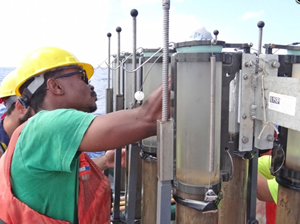
Ph.D. student Usman Muhammed (ETH-Zürich) transfers a core of Gulf sediments into storage for future chemical analysis. (Credit: Benjamin Prueitt, C-IMAGE)
A significant challenge in assessing Deepwater Horizon impacts is not knowing contamination levels before the spill. One way that the OneGulf scientists are addressing the lack of pre-2010 spill data is to study areas impacted by Ixtoc-I and forecast what Deepwater Horizon-impacted sites may experience in 30 years. “We hope to be able to fully characterize oil residue still remaining along the Mexican coasts,” said USF Marine Geochemist and team lead Patrick Schwing. “The samples we collected will help us identify the spatial extent, thickness, and any lasting impacts and study the products of this oil’s natural weathering.”

Dan Razionale, an undergraduate student at Eckerd College, collects pore water from a sediment core to test for levels of nutrients and trace metals. (Credit: Benjamin Prueitt, C-IMAGE)
The OneGulf team, however, did not start from zero to investigate the Ixtoc-I spill. Endowed Chair of Biodiversity and Conservation Science and Professor Emeritus John Wes Tunnell at the Harte Research Institute was studying corals off the Texas coast when the Ixtoc-I spill began. He documented where oil washed ashore and, even though funds ran out, continued taking students back to oil-impacted areas for years afterward. He guided the C-IMAGE researchers to the same locations that he had been monitoring. Tunnell and researchers with the Universidad Nacional Autónoma de México (UNAM) Adolfo Gracia and Elva Escobar-Briones played vital roles in designing studies to examine Ixtoc-I impacts.
The Ixtoc-I and Deepwater Horizon spills share many similarities and present a unique opportunity for comparative analysis. Here are some topics that the team hopes to learn more about:

Researchers collect fish bile samples for toxicity analysis. Bile indicates how fish are metabolizing remaining oil levels. (Credit: C-IMAGE Consortium)
A Similar Marine Snow Event?
Recent studies (Passow, 2014; Brooks, et al., 2015; Hastings, et al., 2015) reported evidence that marine snow associated with Deepwater Horizon created a mechanism for oiled particles to reach the seafloor, which may serve as long-term storage for contaminants that could potentially reenter the water column (Chanton, et al., 2015). One question scientists have is: how long will sedimented oily particles remain in the environment, potentially affecting bottom-dwelling fish and sediment-dwelling organisms?
Researchers on the OneGulf voyage think they may have uncovered a clue. They found a layer of oily sediment buried under the seafloor near the Ixtoc-I site. Lab analyses of these sediment core samples will determine a possible source of this oily layer, and if the oil signature is consistent with an Ixtoc-I spill point source, then the answer may be possibly decades.

Researchers on the Tunnell Trek collect a sediment core adjacent to a mangrove forest impacted by the 1979 Ixtoc I spill. (Credit: C-IMAGE Consortium)
Food Web Impacts?
Ongoing investigations are addressing questions about short- and long-term impacts on the marine food web following the Deepwater Horizon spill. Recent studies (Murawski, et al., 2014; Synder, et al., 2015 and Tarnecki, et al., 2015; Wilson, et al., 2015) suggest that hydrocarbons associated with Deepwater Horizon may have entered the coastal food web; that some demersal fishes in oil-contaminated waters exhibited elevated hydrocarbon concentrations and experienced shifts in diet and trophic level; and that there was a short-term increase in observed fish lesions that declined as hydrocarbon concentrations decreased.
OneGulf researchers will compare tissues, blood, and bile from bottom-dwelling fish caught off the Veracruz coast, the most likely place where Ixtoc-I oil settled, to biological samples collected near the Deepwater Horizon site and unpolluted areas. They will use these data to establish if fish experience elevated hydrocarbon levels or lasting effects of exposure in the entire Gulf or just near Deepwater Horizon and Ixtoc-I sites.
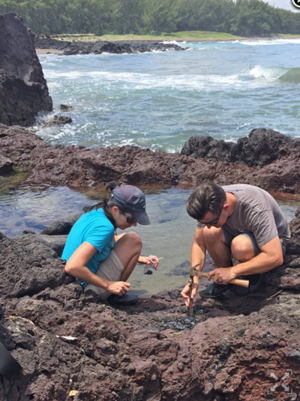
Isabel Romero and Patrick Schwing chisel a tar patty in Montepio, Mexico. Submerged tar still gives off surface oil sheens in tide pools along the shore. (Credit: Ethan Goddard)
Long-Term Shoreline Contamination?
Some of the most visible evidence of Deepwater Horizon contamination was weathered oil found in beached tar balls and sand patties (Aeppli, et al., 2012), oil buried in sand (Hayworth, et al., 2015; Yin, et al, 2015; Zuijdgeest and Huettell, 2012), and fouled vegetation (Judy, et al., 2014). How long will hydrocarbons from this weathered oil persist in and possibly harm northern Gulf coastal environments?
Another clue for answers may come from the OneGulf voyage. The land-based team found oily tar balls and slabs on beaches and in barren mangrove areas along Campeche, Tabasco, and Veracruz shorelines that they believe may be potentially from Ixtoc-I. Analyses of these recent collections is ongoing, and the team hopes the results will help provide insights about possible long-term coastal contamination and impacts from Deepwater Horizon.
What’s Next?
In one sense the cruise is over, but in another sense it is just beginning. Murawski explained, “The really hard work of cataloging, analyzing, and interpreting the significance of these results has just started.” Dozens of scientists and technicians from Europe, Mexico, Canada, and the United States will spend years refining our understanding of how the Gulf works and how subsea oil spills impact its large and diverse ecosystem.
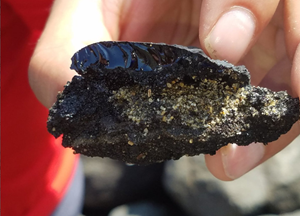
A piece of tar and asphalt found on Mexican shores. The tar layered some of the beach sands and still smelled of oil when broken. Future analysis will determine the lasting decadal effects of tar on the shores and in the mangroves. (Credit: Isabel Romero)
Scientists studying other important Gulf of Mexico issues are benefiting from the OneGulf expedition, too. The C-IMAGE team collected surface water samples for the Florida Fish and Wildlife Conservation Commission’s Harmful Algal Bloom group who are studying the diversity and spread of Gulf blooms including Red Tide (K.brevis). Two international Ph.D. students joined the voyage, Usman Muhammed with the Technical Institute of Zürich (ETH-Zürich) who studies carbon cycling and Diana Torres Galindez with the UNAM who studies deep-sea fishes. An official from the Mexican fishery service, INAPESCA, assisted the C-IMAGE efforts and collected offshore shark species samples.
“We have learned a great deal about the Gulf’s health after the Deepwater Horizon spill,” Murawski said. “But we can’t stop here. There’s remarkable scientific potential in the southern Gulf as well.”
More Information:
- Listen to a podcast Ixtoc Spill: Reflections featuring scientists Wes Tunnell and John Farrington.
- Listen to a podcast In the Mud in Mexico featuring scientist David Hollander
- Read updates and see pictures from those who participated in this summer’s expedition at #OneGulf and the C-IMAGE blog and Flickr site.
************
This research was made possible in part by a grant from the Gulf of Mexico Research Initiative (GoMRI) to the Center for the Integrated Modeling and Analysis of Gulf Ecosystems II (C-IMAGE II).
The Gulf of Mexico Research Initiative (GoMRI) is a 10-year independent research program established to study the effect, and the potential associated impact, of hydrocarbon releases on the environment and public health, as well as to develop improved spill mitigation, oil detection, characterization and remediation technologies. An independent and academic 20-member Research Board makes the funding and research direction decisions to ensure the intellectual quality, effectiveness and academic independence of the GoMRI research. All research data, findings and publications will be made publicly available. The program was established through a $500 million financial commitment from BP. For more information, visit http://gulfresearchinitiative.org/.
Screenscope Releases 50 Short Videos to Accompany Dispatches from the Gulf Documentary
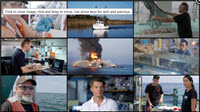
Screenscope, Inc., is pleased to announce the release of 50 short videos complementing the Dispatches from the Gulf documentary film.
The videos include highlights from the film, interviews with Gulf of Mexico Research Initiative (GoMRI)-funded scientists and graduate students, and more. An associated Educators Guide provides detailed descriptions and keywords for each video. The videos were generated as an extension of the film, to be used in classroom curriculum and in other educational efforts.
- The 50 Shorts Videos are available here on the Dispatches from the Gulf
- The Educators Guide can be found here.
- If you are an educator, or know someone who is, you can request a free copy of the Dispatches from the Gulf DVD to use in your classroom here.
- More information about the Dispatches from the Gulf documentary is available here and here.
****************************
Dispatches from the Gulf is made possible in part by a grant from the Gulf of Mexico Research Initiative. The GoMRI is a 10-year independent research program established to study the effect, and the potential associated impact, of hydrocarbon releases on the environment and public health, as well as to develop improved spill mitigation, oil detection, characterization and remediation technologies. An independent and academic 20-member Research Board makes the funding and research direction decisions to ensure the intellectual quality, effectiveness and academic independence of the GoMRI research. All research data, findings and publications will be made publicly available. The program was established through a $500 million financial commitment from BP.
Researchers Seek New Insights from Decades-Old Spill
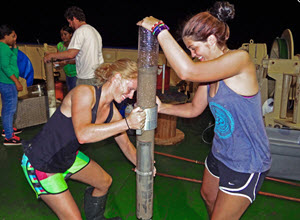
Undergraduate students Nichole Clark (left) and Rachael Kalin (right) transfer a sediment core aboard R/V Justo Sierra. (Provided by C-IMAGE)
The Ixtoc I blowout happened in the Bay of Campeche over thirty-five years ago, so why are scientists studying this spill now? Because understanding what happened to Ixtoc I oil may help predict if and how Deepwater Horizon oil will degrade, persist, and impact northern Gulf of Mexico ecosystems over the next few decades.
A Little Background
The 1979 – 1980 Ixtoc I wellhead erupted in 56 meters of water and released 3.5 million barrels of oil into the southern Gulf of Mexico. This spill is an important historical analog for the more recent Deepwater Horizon oil spill in the northern Gulf. Both spills affected coastal and deep-water biological systems as oil moved through the water column to the sea surface, causing widespread slicks that were treated with dispersants.
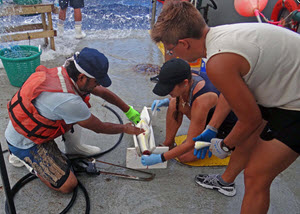
Martín Ramírez, Shannon O’Leary, and Kristina Deak collect samples from a fish caught aboard R/V Weatherbird II. (Provided by C-IMAGE)
In 2015, researchers with the Center for the Integrated Modeling and Analysis of Gulf Ecosystems II (C-IMAGE II) completed two expeditions covering over 11,000 kilometers in the southern Gulf using the R/V Justo Sierra and the R/V Weatherbird II. The team collected sediment cores, water samples, and fish tissues for the first-ever assessment of fish health and sediment contamination across Gulf habitats. This expanded record will provide much-needed baseline information if there are future spills or other environmental events and provides comparative data between Ixtoc I and Deepwater Horizon events.
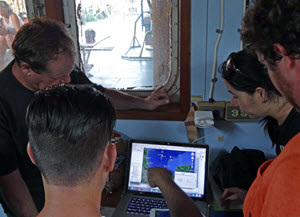
Chief-scientist David Hollander and researcher Isabel Romero discuss R/V Justo Sierra’s anticipated path through the Gulf of Mexico. (Provided by C-IMAGE)
Challenges…
Both expeditions required customs clearance for sampling equipment and permission to collect scientific samples within Mexico’s federally-enforced marine exclusion zone around the Ixtoc-I site. Over thirty researchers from seven countries needed visas and customs clearances prior to departure. Once underway, the teams experienced several unexpected weather events as they traveled long distances to obtain the samples. Principle Investigator Steve Murawski stated:
The collaboration of the US State Department, the Mexican State Department (SRE), the Mexican State oil company PEMEX, and several other agencies was critical to the success of these expeditions.
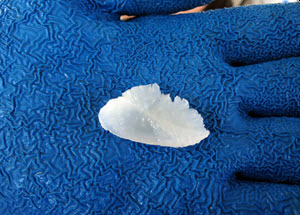
Researchers on the R/V Weatherbird II collected “ear stones” or otoliths (pictured) and other biological materials from fish to gather information about their development. (Provided by C-IMAGE)
…and Successes
Despite complications, the teams exceeded their expedition goals. Researchers collected sediment cores from 70 sites (14 – 3,200 meters depth), including several less than 5 kilometers from the Ixtoc I site and along the western Gulf (south of Texas), Campeche, and Yucatan Peninsula coasts. They collected over 700 fish from 25 stations in Mexico’s territorial sea. Scientists collected almost 5,000 blood, bile, and tissue samples (muscle, liver, fin ray, eye, and otoliths) from dominant Gulf of Mexico species like red snapper and golden tilefish, more than 400 ichthyologic photos, and 22 plankton samples. They also collected water samples from all sediment-coring sites and while in transit from Tuxpan, Mexico, to St. Petersburg, Florida – the Gulf’s longest axis.
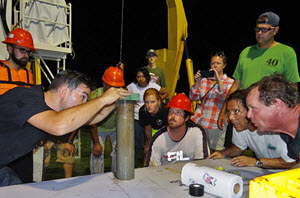
Researchers on the R/V Justo Sierra and crew look on as Patrick Schwing transfers a sample from the sediment corer. (Provided by C-IMAGE)
Cruise coordinator and R/V Justo Sierra co-chief scientist Patrick Schwing commented:
The real success story is how well the science party and the R/V Justo Sierra crew functioned as a team. I am grateful for all the hard hours that everyone worked. By the second site, the entire science team had the deck and laboratory operations down to…well…a science.
Adolfo Gracia, the R/V Weatherbird II’s science lead for Universidad National Autónoma de Mexico, stated:
We can hardly wait to see the findings and compare them with existing data of sediment oil and biological analyses recorded in the Ixtoc I area.
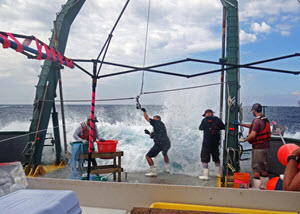
R/V Weatherbird II crew members cast longlines to catch prominent species of Gulf fish for sampling. (Provided by C-IMAGE)
David Hollander, the R/V Justo Sierra chief-scientist, said:
This research has the potential to reveal new and exciting results that provide a better understanding of long-term chemical and ecologic impacts and allow us to better predict the recovery times of impacted benthic environments in the northern Gulf of Mexico.
Preliminary research is already revealing the value of these expeditions. A previous C-IMAGE study discovered evidence that marine snow connected to Deepwater Horizon created a mechanism for oiled particles to reach the seafloor. Initial analyses suggest a similar event may have occurred around the Ixtoc I site and may have affected benthic marine life. Researchers will compare tilefish captured off the Veracruz coastline, the most likely resting place for Ixtoc I oil, to catches near the Deepwater Horizon site and unpolluted areas in the northern and southern Gulf. They can use these data to establish if tilefish experience heavy PAH exposure in the entire Gulf or just near Deepwater Horizon.
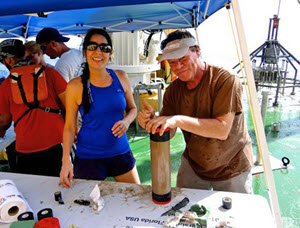
David Hollander and Isabel Romero show a sediment core they collected. The core will be cut open and analyzed to determine the composition of Gulf sediment at different points in history. (Provided by C-IMAGE)
What’s Next?
While C-IMAGE II researchers are still seeking a sample of unweathered Ixtoc-I oil, the samples collected during these expeditions will jumpstart our understanding of this spill. Future analyses will identify chemical and biological changes in the sediment cores, such as shifting redox conditions, changes in benthic meiofauna abundance and diversity, and changes in microbial communities. Researchers will also assess fish stock health by determining PAH compound concentrations in fish and looking for genomic responses and sublethal symptoms related to long-term environmental hydrocarbon exposure. Water samples will provide researchers a rich dataset of water quality, dissolved and particulate organic matter inputs, plankton densities, and concentrations of tiny plastic particles for use in future studies.
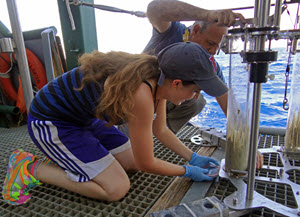
Brittany Verbeke removes a sediment core from R/V Weatherbird II’s sampling equipment. (Provided by C-IMAGE)
C-IMAGE’s efforts to uncover new information about fish and oil spill-impacted sediments will help society better understand past spills and better respond to future spills. This research is a significant step toward increased knowledge about the southern and northern Gulf and the Ixtoc I and Deepwater Horizon spill sites. C-IMAGE plans to continue offshore sediment and fish sampling from Mexico through Texas to Louisiana during summer 2016.
Learn More!
These podcasts provide audio stories about this research:
- The Loop Podcast: “The Gulf’s Big Blowouts”
- The Loop Podcast: “Return to Ixtoc”
- Mud, Microbes, and Mammals – Podcasts Take Listeners on Audio Trips through the Gulf
These study summaries provide findings from recent C-IMAGE research:
- Studies Identify Oil Spill Effects in Deep Sea Fish
- Study Finds Concurrent Rise and Fall of Fish Lesions and Oil Contamination
- Study Estimates Carbon, Likely from Deepwater Horizon Spill, in Gulf Sediment
- Study Reveals Oil Spill Changed Oxygen Conditions in Gulf Sediment
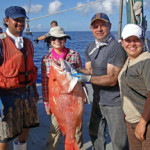
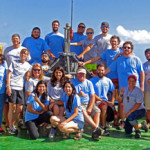
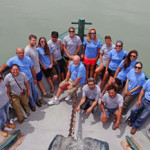
************
This research was made possible in part by a grant from the Gulf of Mexico Research Initiative (GoMRI) to the Center for the Integrated Modeling and Analysis of Gulf Ecosystems II (C-IMAGE II) consortium.
The Gulf of Mexico Research Initiative (GoMRI) is a 10-year independent research program established to study the effect, and the potential associated impact, of hydrocarbon releases on the environment and public health, as well as to develop improved spill mitigation, oil detection, characterization and remediation technologies. An independent and academic 20-member Research Board makes the funding and research direction decisions to ensure the intellectual quality, effectiveness and academic independence of the GoMRI research. All research data, findings and publications will be made publicly available. The program was established through a $500 million financial commitment from BP. For more information, visit http://gulfresearchinitiative.org/.
NBA Player Makes Science the Star for Miami Youth
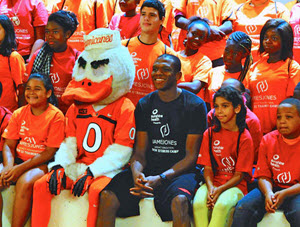
James Jones of the Miami Heat, along with the University of Miami mascot, sits with the Crew 22 camp kids at the opening ceremony. (Photo provided by CARTHE)
NBA Champion James Jones took the stage for young fans this July, but not to talk about sports. Instead, his goal was to get kids excited about cutting-edge science happening in their home town.
Over 40 kids participated in his week-long Crew 22 Training Camp hosted by the University of Miami Rosenstiel School of Marine & Atmospheric Science.
Jones and his wife Destiny started the James Jones Legacy Foundation to reach under-served youth in Miami. Growing up in the inner city, Miami native Jones wants kids in tough circumstances to know they have more options than they realize, saying, “We believe that allowing young people an opportunity to experience a college setting as part of our programming has the potential to transform the lives of these children.”
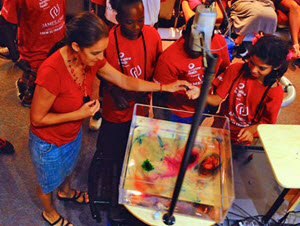
Professor Josefina Olascoaga assists camp kids in simulating the effect of the Earth’s spinning on currents by using a rotating tank and dye. (Photo provided by CARTHE)
After warming up the crowd with upbeat music, friendly banter, and just a little basketball talk, Jones let the kids see a different side of him. “I was a finance major in college and an academic all American,” he said, “I used basketball to get an education, but I’m not just a basketball player.”
Jones encouraged the kids to make friends with the science mentors, learn something new, and get outside their comfort zone. Then, he turned the program over to the enthusiastic CARTHE team and joined the group to learn right alongside them.
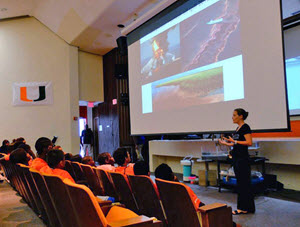
CARTHE Outreach Manager Laura Bracken teaches the group about the Deepwater Horizon oil spill and the importance of understanding how oil moves in the ocean. (Photo provided by CARTHE)
Laura Bracken, the CARTHE Outreach Manager, opened with the video “Bob the Drifter,” an animated depiction of their high-tech tracking devices that go with the flow of ocean currents, helping scientists understand how things move in water. She gave the example of the rubber ducks that, to this day, land in different parts of the world after a container full of them fell from a cargo ship in 1997. Professor Josefina Olascoaga, a physical oceanographer with CARTHE, asked the kids what they thought caused currents, getting answers like “wind,” “rain,” and “animals.” Using a rotating tank, she and post-doc Guillaume Novelli helped them see how the Earth’s spinning affects currents by adding dyes and watching swirling eddies form, taking the dyes in different directions.
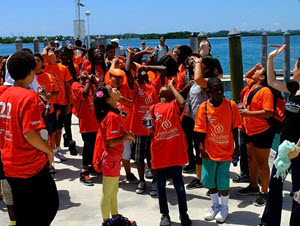
Campers watch as an airborne drone equipped with cameras is remotely maneuvered to capture images of them boarding the shark-tagging research vessel. (Photo provided by CARTHE)
Now, the team had the opening to relate currents and the oil spill. Bracken asked how many of them knew about the 2010 Deepwater Horizon oil spill. Only two raised their hands. The team explained what happened and how they were using science – and really cool equipment – to answer questions about how oil moves in the ocean. The kids got to see drifters and drones that CARTHE used in the GLAD and SCOPE experiments to understand surface currents in deep and in near-shore waters.
The week’s high-interest activities included a toad fish lab, a wave tank, sea slugs, corals, an aquarium, and aviation. A highlight of the program was a day spent catching and tagging sharks. Jones, who joined the kids every day, said he loved being able to expose them to things most people only see on television. “A lot of them thought this would be something similar to going to the zoo or the Seaquarium, but they’re actually out here baiting lines and taking blood and tagging sharks,” said Jones. “It’s something you see on Discovery Channel but rarely get a chance to do in person.”
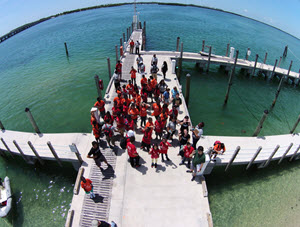
A drone’s perspective of the Jones Crew 22 campers as they gather to board a research vessel and tag sharks. (Photo provided by CARTHE)
CARTHE Director Tamay Özgökmen explained that, given the constant electronic distractions of our ADD world, outreach programs must be creative to bring science to the masses. He believes partnering with celebrities, such as sports stars and musicians, to host educational events provides an avenue to introduce new concepts when people are relaxed and open to ideas that might not ordinarily interest them. For this reason, CARTHE participated in the Tortugas Music Festival in April, where they spoke directly with over 500 individuals and brought scientific discovery to thousands. They hope to expand their reach to non-college audiences through films and other visual/audio media.
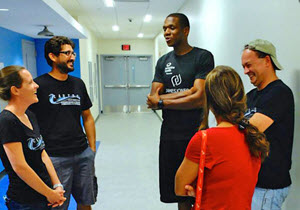
The CARTHE team chats with James Jones about the amazing experiences that the Crew 22 kids had during their week-long science camp. From L-R: CARTHE Outreach Manager Laura Bracken, post-doc Guillaume Novelli, Miami Heat Forward James Jones, CARTHE Director and Professor Tamay Ozgokmen, and Professor Josefina Olascoaga. (Photo provided by CARTHE)
And, partnering with the Jones Crew 22 camp has done just that. “I’ve always taken pride in finding new experiences,” said Jones. From the opening ceremony, where he got kids cheering and dancing, to the camp’s end, where he learned as their peer, Jones made science fun. Now, while most of these kids can say that Jones wears a size 16 shoe, they might also be able to tell their friends where the loop current goes, how currents move oil, or what it’s like reeling in a five-foot shark. For Jones and the CARTHE team, that means the week was a success.
Visit the CARTHE website for more information.
************
This research was made possible in part by grants from BP/The Gulf of Mexico Research Initiative (GoMRI) to the Consortium for Advanced Research on Transport of Hydrocarbon in the Environment (CARTHE). The GoMRI is a 10-year independent research program established to study the effect, and the potential associated impact, of hydrocarbon releases on the environment and public health, as well as to develop improved spill mitigation, oil detection, characterization and remediation technologies. An independent and academic 20-member Research Board makes the funding and research direction decisions to ensure the intellectual quality, effectiveness and academic independence of the GoMRI research. All research data, findings and publications will be made publicly available. The program was established through a $500 million financial commitment from BP. For more information, visit www.gulfresearchinitiative.org.
Teens Explore Oil Spill Impacts on Wetlands through Science and Art
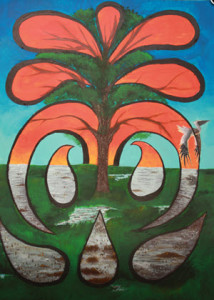
Student April Olivier’s acrylic painting, “Window of Time.” April created this during the CWC Art and Science Camp saying, “In my artwork, I depicted the deterioration of the marsh and land loss over time.” Provided by Murt Conover.
Each summer, parents send their children to camp, trying to match their interests while broadening their horizons. This year, the parents of ten Louisiana students hit the jackpot: the Coastal Waters Consortium (CWC) inaugural Art and Science Camp. This camp challenged participants, engaging both their analytical and creative talents to learn about a locally-relevant and nationally-important subject matter—oiled marsh lands.
For decades, academic institutions have witnessed the arts and sciences compete with each other for funding, recognition, and validation. However, the events at this year’s CWC Art and Science Camp proved that the two disciplines are not only compatible but complementary.
Murt Conover, the Senior Marine Educator for CWC, funded by the Gulf of Mexico Research Initiative (GoMRI), had been thinking about a combined discipline workshop such as this for years. The idea for the camp moved from dream to reality after a local artist, Karen Alice Clanton, approached Conover with questions regarding the Deepwater Horizon oil spill following her attendance at a CWC-hosted Coastal Roots workshop. Clanton, whose work focuses heavily on the Louisiana coast, and Conover soon developed a partnership, organizing a summer camp that emphasized the importance of both art and science as tools for communicating environmental concerns. For Conover, this workshop was a “breath of fresh air” because it was outside the traditional Science-Technology-Engineering-Math (STEM) focus, bringing together artists and scientists and reaching students who are not typically interested in science-related activities.
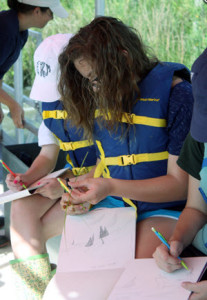
Students created artistic renderings in the field while receiving information from both scientists and artists. Photo by Murt Conover.
The camp took place June 8-11 in Cocodrie, Louisiana, and introduced teenagers to art and science – not as rivals but as allied subjects. The students (ranging from 8th to 12th grade) came from varying backgrounds, some with a noted interest in science and others in art. Students spent their days performing research and experiments about coastal wetlands and then translating what they learned into pieces of art. Upon their arrival, the campers and their parents learned about local professional artists, such as Walter Anderson, from camp instructors and local artists Clanton and Jennifer Koppin. They also heard about GoMRI-funded research that focuses on understanding the impacts of the oil spill on the ecosystems that they would be encountering during the camp. The following days were a melding of science and art.
The mornings began with students going into the wetlands aboard kayaks and research vessels and gathering samples of water, sediment, vegetation, and marine life. They learned about wetlands vegetation and impacts of disasters on them directly from scientists with CWC who are currently conducting research in these areas: Dr. John Marton (marsh biogeochemist at the Louisiana Universities Marine Consortium, LUMCON), Dr. Brian Roberts (marsh ecologist at LUMCON), and graduate student Elizabeth Robinson (studying oil impacts on blue crabs at Louisiana State University). Afternoons consisted of laboratory work analyzing the samples they collected and generating data from them. Then, they went into studios to recreate what they learned through art. Some camp activities included experiences in both disciplines simultaneously.
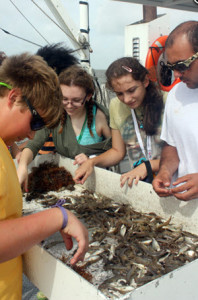
Hands-on science, such as collecting samples of marine life in the marsh, helped students gain a deeper understanding about the science that they later used in their artistic depictions. Here students were on board the RV Acadiana. Photo by Murt Conover.
For example, some boat trips consisted of sketching wildlife while listening to an expert explain the surrounding vegetation and the impacts of pollution on various species. The camp finished on a high note, with students holding a gallery show for their families and staff from LUMCON and CWC.
The art aspect of the camp provided an entirely new method of teaching the students about coastal wetlands. While students had no trouble understanding and learning from their experiences in the field, translating the science into works of art helped them look at the material from a completely different angle, fostering a deeper understand of the information. Conover explained that students would “ask the art teachers about composition one minute and then come to me the next minute asking about the details of the organisms they were drawing, wanting to make sure they were accurate.” As the students developed their artwork, it became obvious that they assimilated their experiences from field work and the lab by the visual imagery they created to share their learning.
The students were extremely enthusiastic about the camp, exceeding Conover’s expectations. One student remarked, “I came for the science, but I really learned a lot about art.” Meanwhile, another student who had attended the camp strictly to create art found that she loved working in the field and expressed that she was now considering pursuing wetlands biology once she entered college.
What began as an experiment to educate students on coastal wetlands through art and science soon became a life-changing experience. The impact of the camp on students and teachers set the stage for future CWC Art and Science camps, opening the door to not only education, but expression.
“Magic happened,” said Conover, “I can’t say it any other way.”
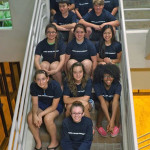

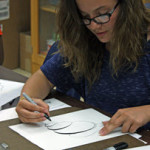
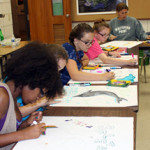
************
This research was made possible in part by a grant from BP/The Gulf of Mexico Research Initiative (GoMRI) to the Coastal Waters Consortium (CWC). The GoMRI is a 10-year independent research program established to study the effect, and the potential associated impact, of hydrocarbon releases on the environment and public health, as well as to develop improved spill mitigation, oil detection, characterization and remediation technologies. An independent and academic 20-member Research Board makes the funding and research direction decisions to ensure the intellectual quality, effectiveness and academic independence of the GoMRI research. All research data, findings and publications will be made publicly available. The program was established through a $500 million financial commitment from BP. For more information, visit http://gulfresearchinitiative.org/.
Louisiana Scientists Present Marsh Research in Public Workshop Series
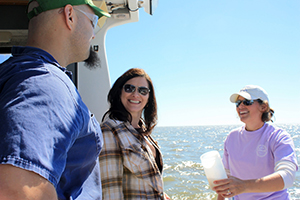
On board the R/V Acadiana, Dr. Tara Duffy and workshop participants collect marine and water samples in marsh waters. (Photo credit: Jessica Hernandez)
An old philosophical question asks, “If a tree falls in a forest and no one is around to hear it, does it make a sound?”
Similarly, if a scientist makes an important discovery and people do not hear about it, will it matter? Scientists are conducting research about oil and other impacts on coastal marine environments. Sharing this unfolding science with communities most affected by the Deepwater Horizon oil spill is a priority for them.
Marine educator Jessica Hernandez with the Coastal Waters Consortium (CWC) voiced the importance of this outreach, saying, “What is scientific research if we cannot share it with the public?” To do this, educators and scientists with the CWC have established a series of public education workshops to highlight recent research about the chemical evolution, biological degradation, and environmental stresses of petroleum and dispersant in the Gulf of Mexico and their effects on coastal and shelf ecosystems.
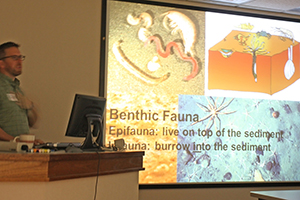
Dr. Chuck Wall presents research on marine life that live in marsh sediment. (Photo credit: Jessica Hernandez)
Dr. Chuck Wall and Dr. Tara Duffy, postdoctoral research associates with the Louisiana Universities Marine Consortium (LUMCON), led the first Gulf Lagniappe Public Education Workshop on October 26, 2013 at the DeFelice Marine Center in Cocodrie, Louisiana. Attendees listened to presentations, explored the bay, used laboratory equipment, and—in true Louisiana fashion—enjoyed a delicious chicken and sausage gumbo lunch.
Dr. Wall focused on two research areas—the hypoxic or “dead zone” in the Gulf and the effect of oil on the tiny creatures that live in salt marsh mud. He talked about the abundance and diversity of these mud-dwelling critters and explained his work that uses samples from both oiled and non-oiled areas to understand how oil exposure affects them.
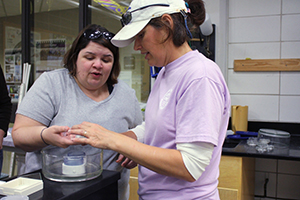
Dr. Tara Duffy helps participants use laboratory equipment to study marine larvae. Photo credit: (Jessica Hernandez)
A fisheries expert, Dr. Duffy spoke about her work with the early life stages of blue crab, anchovy, red snapper, and trout to study the impacts of oil exposure on these animals at this delicate developmental stage. She described lab experiments that exposes larvae to oil and records how the organisms respond.
After the presentations, participants traveled by boat around the local estuary and used trawl nets to collect marine samples. They experienced the biodiversity – both plants and animals – that live right offshore and that are at risk. After the bay tour, the group looked at plankton specimens under a microscope. Viewing these tiny organisms, integral to the Gulf of Mexico’s food web, brought home the many lessons of the day on the interconnectedness of the environment.

On board the R/V Acadiana, workshop participants identify marine animals caught when trawling in marsh estuaries. (Photo credit: Jessica Hernandez)
One attendee explained the desire to continue learning about the research saying, “Unless you are in this career, the aspects of this life and the ecosystems all around us are never in your mind,” adding that it was important to know “the things we do that impact them and how they impact us.”
The CWC will host another all-day Gulf Lagniappe Public Education Workshop on Coastal Wetlands Formation, Functions, and Susceptibility on November 23 at the LUMCON facility in Chauvin, Louisiana. For more information, go to the CWC website. To register directly online, go to http://blogcwc.weebly.com/events.html.
This research was made possible in part by a grant from BP/The Gulf of Mexico Research Initiative (GoMRI) to the Coastal Waters Consortium. The GoMRI is a 10-year, $500 million independent research program established by an agreement between BP and the Gulf of Mexico Alliance to study the effects of the Deepwater Horizon incident and the potential associated impact of this and similar incidents on the environment and public health.
Tulane Scientists Hold Oil Spill Q&A Event with Vietnamese Fishing Community
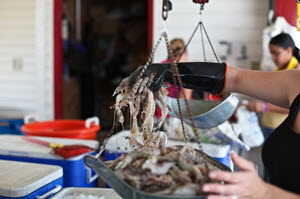
Louisiana Shrimp being weighed before sold. (Photo: Kerry Maloney/Louisiana Seafood News www.Louisianaseafoodnews.com)
Many people outside of the Gulf Coast region are not aware of the large population of Vietnamese residents who live across this area, in concentrated communities from Texas to Alabama.
Arriving as refugees during and after the Vietnam War, they settled along the Gulf Coast to work in the booming commercial fishing industry. Today, the business of catching and processing seafood for sale around the country remains an important economic driver for their community. As a result, the Macondo oil spill profoundly affected the livelihoods of many Vietnamese residents of Louisiana.
In order to address the concerns of this unique community, a joint team of researchers from Tulane University’s School of Science and Engineering and School of Public Health and Tropical Medicine provided information and fielded questions on a Sunday in July at a Vietnamese Catholic church in Houma, Louisiana. Titled, “Is it safe? The Oil Spill, Dispersants, and Frequently Asked Questions,” the event took place after mass with about 20 community members in attendance.
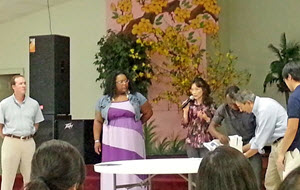
Tulane University held an outreach event on July 21, 2013 at Our Lady of Holy Rosary church in Houma, LA, to address issues related to the oil spill. The church is attended by the local Vietnamese community, many of whom work in the seafood industry. (Photo courtesy of C-MEDS)
Vijay John of Tulane University, Director of the Consortium for the Molecular Engineering of Dispersant Systems (C-MEDS), explained that in order to adequately answer all the questions, it was important that both Schools be represented at the meeting, saying, “The C-MEDS consortium is centered at Tulane University and is in close proximity to the communities that were most directly affected by the Deepwater Horizon incident. In addition, the School of Public Health and Tropical Medicine at Tulane has an extensive research and outreach program on the health impacts of the oil spill.”
Debi Benoit, a Research Board member of the Gulf of Mexico Research Initiative (GoMRI), began the session by explaining the history and mission of GoMRI. Then Vijay John, along with undergraduate students who work with him on dispersant studies, gave brief talks about what dispersants do and why they were used in the oil spill response. Using demonstrations to show the crowd how they worked, the presenters brought up a volunteer child from the audience to shake vials to make emulsions form. Dr. Jeffery Wickliffe, a Tulane toxicologist, ended the talk by explaining the methods researchers used to test seafood for safety.
At the conclusion of the talk, the questions began. “I earn my livelihood shucking oysters. How would I know if the oysters I am working with are contaminated?” “If I develop a skin rash 6 months after working with seafood, where do I go? Who do I turn to?” “My seafood catch is poor. How do I know if it is due to the spill?” “If the state closed certain areas due to contamination, would the water flowing between the closed and open areas not bring oil or other toxic materials into our catches?” And, “Should we be concerned about health hazards even now if we inadvertently come into contact with a contaminant?”
The audience was very polite, but their questions clearly showed that they had concerns about short- and long-term effects of the spill, both on their health and on their ability to provide for their families. The speakers listened with concern, answering questions with the latest scientific research. Dr. Wickliffe fielded quite a few health questions and was extremely helpful in addressing the audience’s concerns. The team also directed the community to organizations and resources that might be a source of ongoing support with health or economic issues. Because of the success of this program, Tulane researchers plan to hold similar events with local community groups in the future as a way of engaging those most affected by the oil spill and sharing their science findings with them.
The Consortium for the Molecular Engineering of Dispersant Systems (C-MEDS) received a research grant from the Gulf of Mexico Research Initiative (GoMRI). The GoMRI is a 10-year, $500 million independent research program established by an agreement between BP and the Gulf of Mexico Alliance to study the effects of the Deepwater Horizon incident and the potential associated impact of this and similar incidents on the environment and public health.
CWC Involves All in the Family in Oil Spill Marsh Science
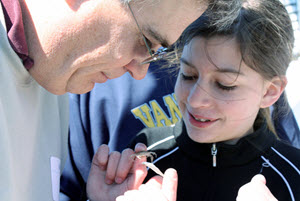
Alan and Anissa Holekamp enjoyed looking at a juvenile blue crab that was caught in the trawl aboard the R/V Acadiana during Dads and Daughters Day. (Photo by Murt Conover)
“My mom would love this boat ride.” “I wish my child could walk the marshes.”
Murt Conover, Senior Marine Educator and Aquarist with the Coastal Waters Consortium (CWC), often hears comments like these when leading teacher and student groups at the Louisiana Universities Marine Consortium (LUMCON) facility. She thought it seemed like a “no brainer” to put parents and kids together in outreach programs, and thus the inaugural Father/Daughter and Mother/Son Discovering Coastal Waters Science events were born.
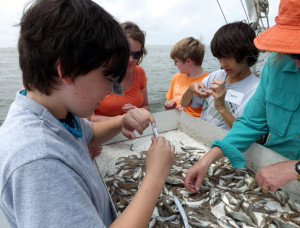
Mothers and sons identified, sorted, and counted the species caught in a trawl in Terrebonne Bay aboard the R/V Acadiana. (Photo by Murt Conover)
Conover loves planning educational activities that get local families outside in the marshes and waterways to learn about the delicate ecosystem that surrounds them. They also learn about impacts from natural and manmade hazards that affect this region, one being the Deepwater Horizon oil spill. She explains, “We like to get people to experience it first hand, because ownership leads to responsibility. We have a very ‘get your feet wet and hands muddy’ philosophy as far as education goes!” But the events are not just pretty nature walks. Participants often gather samples and analyze them in the LUMCON lab using state-of-the-art research technology. “We do the scientific process from start to finish,” Conover says proudly.
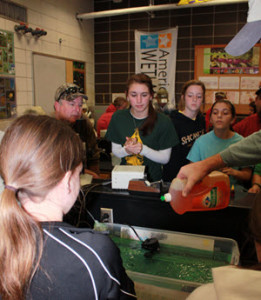
Groups of dads and daughters conducted experiments to learn about how oil can behave in currents before and after it has been dispersed. (Photo by Murt Conover)
Earlier this year, close to Valentine’s Day, CWC hosted a Dads and Daughters Day. They began with a ride on the R/V Acadiana to see the beauty of the Louisiana coast and to experience the kinds of tasks scientists perform on a research vessel. That afternoon, the group conducted oil-spill related experiments in the lab. After the experiments, they finished the day learning about marsh habitat.
CWC hosted a Mothers and Sons Day in May in honor of Mother’s Day. This event was similar to the Dads and Daughters Day, but because of the warmer weather, they constructed Remotely Operated Vehicles (ROVs) and tested them outside. Both the moms and the sons enjoyed working with this research technology and being out in the field. One son said, “We walked into the marsh. That was a first for me. We saw little house-like areas made of sticks.” He added, “I’m glad to see the oil spill didn’t kill all of the animals.”
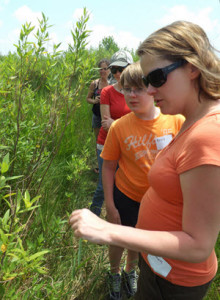
Mother Shawn Duplessis and her son Brady learned the names of the vegetation found on a natural ridge in the salt marsh. (Photo by Murt Conover)
One of the main goals of these programs was to acquaint locals with current research being done to learn about the environmental response to the oil spill, and participants’ feedback showed success. One mom gave this family outreach event the perfect review, commenting, “I wasn’t aware of the structure in place for studying oil spill impacts. It is comforting to realize that compassionate and competent people are researching independently, because without the independent research, it would be hard to trust the data provided to the public.”
Conover enjoyed watching the father/daughter and mother/son dynamics as they learned about the coastal environment. And since her own father came to support her efforts, the father/daughter event was even more special. She laughs, “Having my dad there that day, I got the same kind of experience as the other girls. It was fun to be the educator and the daughter.”
Both inaugural events had full attendance and participants and staff were pleased with these learning experiences. The CWC plans to host similar family-themed events in the coming months.

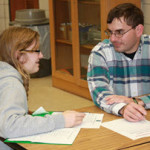
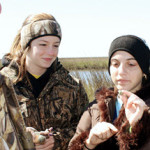
This research was made possible in part by a grant from BP/The Gulf of Mexico Research Initiative (GoMRI) with the Coastal Waters Consortium. The GoMRI is a 10-year, $500 million independent research program established by an agreement between BP and the Gulf of Mexico Alliance to study the effects of the Deepwater Horizon incident and the potential associated impact of this and similar incidents on the environment and public health.


